Better Sailing
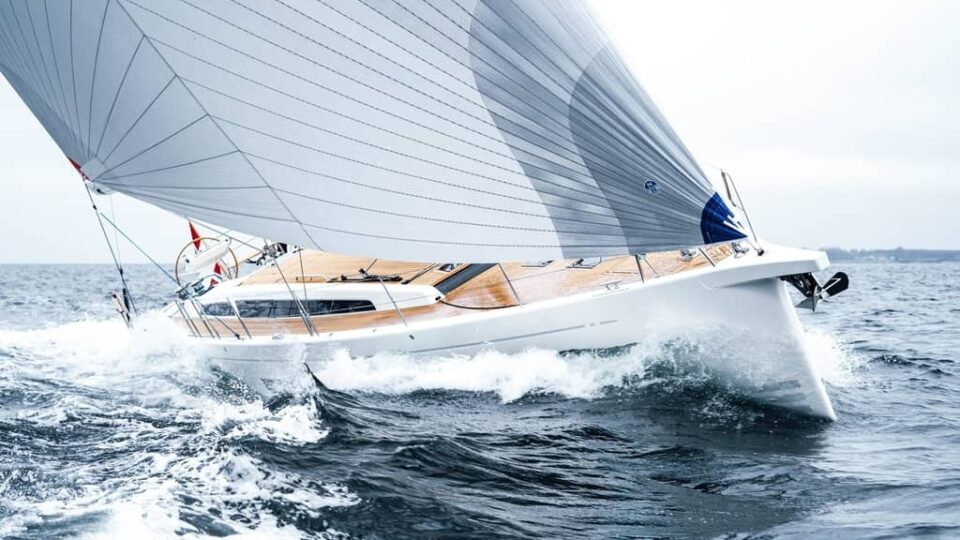

Names of Sails on a Sailboat
Are you a beginner sailor and want to get acquainted with the names of the sails? Are you an experienced sailor and want to learn more details about the sails on a sailboat? Then this article is written for you! Sails form a crucial part of the sailboat because without them, there’s no starting up. For that reason, there are many details about different types of sails concerning their utility, functionality, fabrication materials, and performance. Simply put, each sail serves different purposes when out on the water. Since the sail is the engine of your sailboat, in terms of it being the basic source of propulsion, it’s important to know when best to use either type of sail and why.
Types of Sails on a Sailboat
So, in order to better explain the types of sails, let’s look at their characteristics. The first important distinction between sails is their placement. Generally, the mainsail is placed aft of the mast , which means behind. On the contrary, the headsail is in front of the mast. There are also other sorts of sails that are used for specific conditions. These can be the spinnakers or balloon-shaped sails for downwind use. The second important distinction for the sails is their functionality. The specialized sails have different functionalities and are used in different sailing circumstances and weather conditions. A rule about sails is that large sails are appropriate for downwind use, whereas small sails are good for upwind use. Moreover, large sails perform better on weak winds while small sails are good for strong winds.
The Parts of a Sail and its Shapes
- Head: This is the top of the sail.
- Luff: The forward edge of the sail.
- Leech: Back edge of the sail.
- Tack: The lower front corner of the sail.
- Clew: The bottom back corner of the sail.
- Foot: Bottom of the sail.
There are two sail shapes, the fore-and-aft rigged sails, and square-rigged sails. Nowadays, fore-and-aft sails are more popular, have better performance and maneuverability. To grasp the idea square sails are the ones that Vikings had on their ships and are good at sailing downwind because they run from side to side. But they’re not suitable at all when sailing upwind. On the other hand, a fore-and-aft sail is tied from the front of the mast to the stern and is much better at sailing upwind.
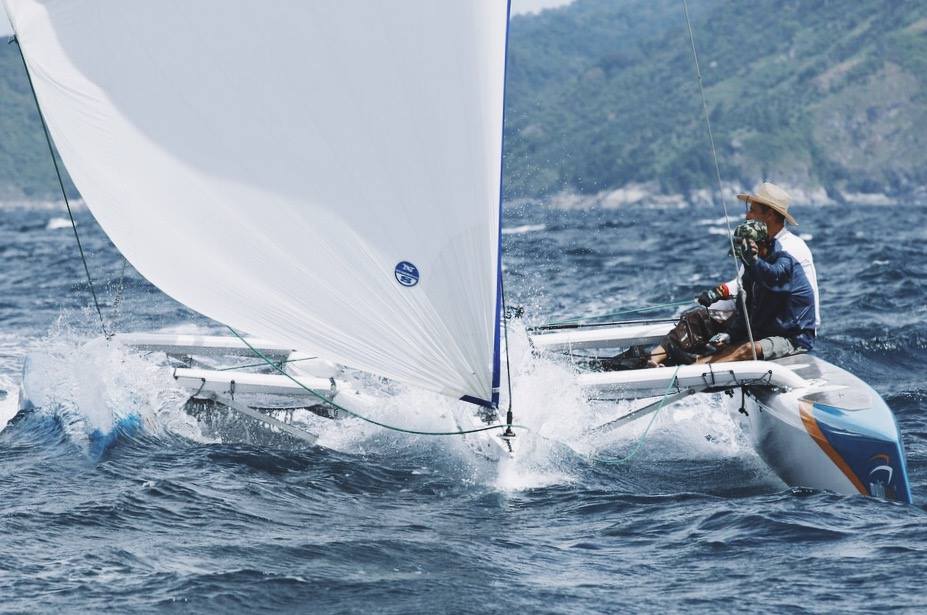
Also Read: What is Sailboat Rigging?
Types and Names of Sails
There are a lot of reasons why you’d want to put one sail over another, but the most important thing to remember has to do with the point of your sail and the wind strength. These points help you understand how your sailboat generates wind power. These points of sail include: into the wind (in irons), beam-reaching, broad-reaching, close-hauled, close-reaching, and running. They all go from windward to leeward and are symmetric from port to starboard . So, let’s get to the point and see the names and explanation of each sail:
- Mainsail : The large sail behind the mast which is attached to the mast and the boom, is called the mainsail. Mainsails cover a lot of surface area concerning incoming winds and by doing that they don’t need very strong winds to provide forward propulsion on a sailboat.
- Headsail or Jib : The small sail placed in front of the mast, attached to the mast and forestay (ie. jib or genoa), is called the headsail. Headsails are smaller than mainsails, thus their surface area is smaller. As a result, they can’t catch the same wind as a mainsail does. However, this is important because in case that the current wind is strong and the mainsail has been enough trimmed, being able to remove the mainsail and depend on the headsail alone, is a good strategy in order to reduce speed.
- Genoa : A genoa is like a large jib and it’s attached to the front of the forestay, like a headsail. When you use a genoa sail then you are expecting light to medium winds. Also, your sailboat would be somehow in a rush point of sail, meaning that the wind comes directly from the rear. Moreover, the surface area of a genoa sail is quite large, so it’s important to use it when winds are relatively low.
- Spinnaker : These downwind sails are symmetrical which makes them more sensitive to the reaching points of the sail and therefore more suitable for the running point of sail. Spinakkers are lighter than other types of jibs, and they don’t cover the mast like a genoa sail. Moreover, they remain unattached to the forestay and stretch out toward and past the bow of a sailboat.
- Gennaker : Gennakers are a mixture of genoa and spinnaker sails. There are small and big gennakers and both are downwind sails. They aren’t as symmetric as a spinnaker and aren’t attached to the forestay like a headsail. Furthermore, the gennaker sail is able to take on a more flexible point of sail while taking advantage of softer winds.
- Drifter Reacher : A drifter is a light air sail, and it’s basically a larger genoa for use in light winds. Its extra sail area offers better downwind performance than a genoa. It’s mostly made from lightweight nylon.
- Code Zero Reacher : This sail is a type of spinnaker, but it looks like a large genoa. However, code zero is designed for better reaching which makes it much flatter than the spinnaker.
- Windseeker : This sail is small, and it’s designed to guide light air onto the lee side of the mainsail. Moreover, it’s tall and thin and ensures a smoother flow of air.
Sail and Mast Configurations
Now that you got an idea of the different types of sails on a sailboat, it would also be an advantage to know how these types of sails are related to the configuration of a sailboat’s mast. There are numerous combinations when it comes to sails and mast configurations, let’s see some of them!
- Cat: A cat is similar to a dinghy and has one mast and one sail. The mast is located at the bow of the sailboat.
- Sloop: The sloop has the classic single mast and a double sail setup. The headsail can be different kinds of jibs, is connected with the forestay on the mast, and runs all the way up to the mast.
- Fractional Rig Sloop: A fractional rig sloop is different from the sloop because its forestay doesn’t reach the top of the mast. Its headsail is restricted to a fractional amount of space and this means that less wind can be captured, therefore the speed of the sailboat is reduced.
- Cutter: Having two forestays on the mast and cutters that are able to house two headsails this setup allows easy cruising because it offers a wide combination of points of sail for different strengths of wind.
- Ketch: Just like a sloop the ketch has a mast that enables the mainsail and headsail to a full range forestay. However, it also has a smaller mast between the mainmast and the stern of the sailboat.
- Schooner: A schooner is when a sailboat has two or more masts but it has a couple of sails to manage. A schooner’s aft mast is taller than the forward mast and sometimes a schooner can have up to six masts.
Names of Sails on a Sailboat – Summary
So, how many types of sails are there? In general, sailboats have one mainsail and one headsail. The rigging also affects the types of sails you can use. As we’ve explained before, the mainsail is a fore-and-aft Bermuda rig. Then, for a headsail, we use a jib or genoa. Most experienced sailors use extra sails to ensure better performance for their sailboat. For example, the spinnaker (a common downwind sail), the gennaker, the code zero (for upwind use), and the storm sail. Keep in mind that every sail has its own use and performance. Want to go downwind fast? Use a spinnaker. Don’t just raise any sail you think suits you best and go for it! It’s of great importance to understand the functionality, use, and performance of each sail.
Peter is the editor of Better Sailing. He has sailed for countless hours and has maintained his own boats and sailboats for years. After years of trial and error, he decided to start this website to share the knowledge.
Related Posts

Lagoon Catamaran Review: Are Lagoon Catamarans Good?

Best Inboard Boat Engine Brands

Are O’Day Sailboats Good? A Closer Look at a Classic Brand

Why Do Sailboats Lean?
- Buyer's Guide
- Destinations
- Maintenance
- Sailing Info
Hit enter to search or ESC to close.

Parts of a Sailboat

Sailboats share many parts with other boats, such as keels, decks, and sometimes engines. But parts like halyards, sheets, and blocks are unique to sailboats.
Sailboats require four main parts to operate: a hull, mast, sail, and rudder. The hull is the body of the boat, and all other parts are directly or indirectly connected to it. The mast is a long pole that serves as a guide and mounting point for the sail. The sail catches the wind and propels the boat, and the rudder directs the boat and acts as its steering.
Here are all the main parts of a typical cruising sailboat , including hardware, lines, controls, cabin items, and a rundown of common sailing terminology.
Table of contents
Port, Starboard, Bow, Stem, and Stern
Before we get into the parts of a sailboat, let’s get a handle on sailboat direction. The bow of the boat is the front (forward), and the stern is the rear (aft). The stem is the forward-most part of the bow and determines its shape. These words describe the general area of front and back.
When determining port and starboard, picture looking down on the boat with the bow oriented forward. The port side is the left side of the boat, and the starboard is the right side. Now picture yourself at the controls of your boat.
If your lookout sees an obstacle off the port bow, which direction should you look? That’s right—the obstacle is forward and to the left of you. Now, we’ll go over the basic parts of a sailboat.
Basic Parts of a Sailboat
What are the basic parts of a sailboat? These are items that are essential to the operation of the boat and universal across most sailing craft. Every sailor should know where these parts are and what they do. Here are nine fundamental sailboat parts, their function, and why they’re important.
The hull is the ‘boat’ itself. It comprises the frame of the boat, the skin that keeps the water out and serves as the mounting point for everything else on the boat (both directly and indirectly). Simply put, if you punch a hole in the hull, water will come into the boat. Sailboat hulls are constructed most commonly out of fiberglass or hardwood (such as white oak), but some boat hulls are made out of aluminum, steel, and even a material called ferrocement.
The deck is the platform that covers the hull. It’s the place where you walk when you’re not inside the boat. Most people would consider the deck as any place ‘on top’ of the hull. The deck serves as a mounting point for essential boat hardware such as the mast and winches. We’ll get into those later; just think of the deck as the visible top area of the vessel. Decks are often made of fiberglass as well, but traditional boats use teak wood planking in this area. You’ll often find abrasive anti-slip material on the deck, as sailors often walk across it in wet conditions.
The keel is the structural backbone of the boat. It’s located in the bottom of the hull and serves as a sort of ‘spine’ to which all frame members are mounted during construction. The keel is an essential part of the boat and cannot be broken or damaged. You’ll often hear the term ‘keelboat’ in the sailing community. This word describes a sailboat with a long and deep keel, which is like a thin fin that runs the length of the hull. Keelboats are seaworthy vessels, as the elongated hull adds stability and keeps the boat on a straight track.
Centerboard
Many sailboats don’t have a long, deep keel, but they still need some sort of fin to keep the boat tracking straight. To substitute a long keel, many boats utilize a dagger-like board called a centerboard . This plate protrudes underneath the center of the boat, usually between one and three feet below the bottom of the hull. Centerboards are often retractable, which is great for towing and beaching. Centerboards are most common on small sailboats designed for inland or coastal cruising.
The cockpit is usually located in the rear of the boat. It features seating for the crew and controls for the steering, sails, and engine. The cockpit is the command center of the sailboat and often features storage lockers under the seats. Many cockpits are self-draining, which means they’re located above the water line and clear themselves of water accumulation. Some sailboats have enclosed cockpits for off-shore sailing. In a typical cruising sailboat , the cockpit usually takes up ⅓ of the total length of the boat or less.
The mast is the big pole extending from the deck of the sailboat. It connects the sail to the boat and serves as a frame for all sails carried by the vessel. The mast is a key part of the sail plan and helps determine what kind of boat you’re looking at. Most sailboats have just one mast, but others have numerous masts. A schooner, for example, has two masts and a specific sail plan. A yawl also has two, but each mast serves a separate function.
The rudder steers the boat and is located on or under the stern of the vessel. Rudders are an essential part of the boat, and they’re particularly sensitive to impact or misalignment. On some boats, the rudder is completely invisible when in the water. Other boats have retractable rudders for beaching or towing. Fundamentally, a rudder is just a plate that’s hinged to move side to side. It’s connected to the tiller or the helm, which we’ll cover in a bit.
The sail is what propels the boat, and most boats have more than one. The aft (rear) sail on a single-masted boat is called the mainsail , and it’s the largest of the two primary sails. The triangular forward (front) sail is called the jib, and it’s generally smaller than the mainsail. Other sails include the spinnaker, which is like a loosely-mounted parachute that flies in front of the boat during conditions of low wind.
The boom is a hinged rod that extends perpendicular to the mast. It’s mounted on the lower part of the mast, and it controls the side-to-side position of the mainsail. The best way to remember the boom is to consider what happens when it swings side to side. If you’re not paying attention, a swinging boom could give you a nice crack on the head. Think of the boom as the throttle of the boat. If you’re properly pointed relative to the wind, pulling in the boom will increase the speed of the boat. This is where the bottom of the sail connects to the mast. The boom is also connected to the deck and adjustable using a winch and a crank.
Here is some of the hardware you’ll find on a typical sailboat. These items are usually mounted to the hull, on the deck, or to the mast. Boat hardware consists of control systems and other items that are essential to the operation or integrity of the boat.
Cleats are the universal mounting points for ropes on the deck. Cleats are used for tying up to the dock, securing lines, and tethering important items that can’t fall overboard. There’s a special kind of knot called a ‘cleat knot,’ which is essential to learn before sailing. A properly tied cleat will stay secure in almost all conditions, and it’ll be easy to untie if the need arises. An important distinction must be made for clam cleats, which are spring-loaded sets of jaws that secure rigging lines that need to be adjusted frequently.
Block is a nautical word for a pulley. Blocks (pulleys) are everywhere on a sailboat, and they’re an essential part of the rigging system. Blocks distribute and regulate force. For example, a deck-mounted block can change the direction of a line from vertical to horizontal, allowing you to apply a horizontal force to lift something vertically. Blocks also reduce the force required to lift heavy loads and help make adjustments more precise.
Winches are cylindrical mechanical devices that transmit force. Winches are often located on either side of the boat. They’re multi-directional like a socket wrench and feature one-way locking mechanisms for raising, lowering, tightening, and loosening lines. Winches have a hole in the top for a crank, which makes it easy to wind rope in and out. Winches are present on almost every medium to large sailboat. They’re either manual or electrically-powered.
A hatch is a watertight or water-resistant door used to enter the cabin or storage compartment of a boat. Hatches can be flush with the deck and hinged, threaded like a large screw, or they can slide back and forth. The purpose of a hatch is to keep water out when closed and allow easy access to the interior parts of the boat.
Tiller and Helm
The tiller and helm are used to control the direction of the rudder and steer the boat. Usually, a boat has either a tiller or a helm. The tiller is the most basic steering control and consists of a simple rod connected to the rudder or rudder shaft. Tillers move side to side and point in the opposite direction that the boat steers. The helm is essentially a steering wheel, and it operates the same way that a car steering wheel does. The helm is connected to the rudder by complex mechanical or hydraulic linkage.
Mast and Sail Components
Mast and sail components are referred to as ‘rigging’ in most cases. These items are part of the wind-powered propulsion system of the boat. You’ll operate these systems to control the speed of the boat. Here are three common sail components that you’ll need to understand before hitting the water.
Stays are the lines that secure the mast to the boat. Usually, the mast is bolted or tied to the deck of the boat; but much of the load and pressure created by the wind is transferred to the stays. Stays are usually made of strong stainless steel cable. Losing a stay at sea is a serious problem, as these small cables keep the mast from collapsing.
Halyards are the ropes used to hoist and lower the sail on the mast. They also hoist flags, spars, and other components that need to be raised and lowered. Halyards are usually found on the mast and are fixed to cleats or winches around the boat.
Sheets and halyards are often confused, but they serve a very different function. Sheets are the control lines of the sail. These ropes control how far in or out the sail is, and they’re usually found connected to the jib (jib sheet) and the mainsail (mainsheet). Sheets are controlled by winches and blocks and secured onto cleats or clam cleats on the deck. Sheets can be controlled from the cockpit of the boat.
Navigation components are the parts of the sailboat used to find direction and alert other boats of your position. These four items aren’t the only navigation items found on sailboats, but they’re the most common.
This item should be self-explanatory, but it’s essential nonetheless. A compass is arguably the most basic and important marine navigation item. It shows you what direction you’re heading. Sailboat compasses are precise instruments designed to display an accurate heading no matter how much the boat rolls up and down or side to side. Compasses are usually mounted in the cockpit, in clear view of the captain.
Charts are old-fashioned navigational tools and indicate important information such as water depth and the location of ship channels. Learning to read and purchasing charts is essential, even in the age of modern GPS navigation. When all else fails, a chart can help guide you and your vessel to safety and away from hazardous areas. No electricity is required.
Navigation Lights
Navigation lights are mandatory beacons located around the boat. These lights help other boats figure out where you are and where you’re going. Sailboats are required to have red and green bow lights. Red indicates port, and green indicates starboard. This is how boats determine if they’re looking at your bow or stern. Other lights, such as a white stern light, a mast light, are also necessary during specific circumstances. Check your state requirements for lighting.
VHF radios are the standard marine over-the-air communication system. You can use a VHF radio to communicate with the coast guard, other boats, harbors, towing services, and drawbridges. It’s important to learn and write down the specific channels and call signs for each situation, as you need to be able to properly communicate on the radio.
The cabin is the ‘below decks’ area of the sailboat and usually contains living quarters for the captain and crew. Not all boats have cabins, and cabin size varies widely. Some sailboats have rudimentary cabins with basic sleeping accommodations and sitting headroom. Other boats have full standing headroom, shower and wash facilities, full-size kitchens, and separate staterooms for sleeping and sitting. The cabin is usually located forward of the cockpit. Here are some common sailboat parts located within the cabin.
The berth is the sleeping area of a boat. Berths are often convertible, which means they fold or rearrange into a table and seating area. There are numerous kinds of berths. The ‘V’ or ‘vee’ berth is a triangle-shaped sleeping area located in the bow of the boat. Side berths typically convert into couches or settees, and pole berths are essentially cots that roll up and stow away easily.
The bilge is the bottommost interior part of the boat. It’s usually located under the floor in the cabin. When water finds its way into the boat, it drains down to the bilge and gets pumped out by bilge pumps. Bilge pumps are an essential piece of hardware, as they keep the boat dry and prevent sinking. Some boats have a wet bilge, which means it’s always full of water (and supposed to be). Most boats have a dry bilge.
Portlights are watertight windows located in the upper part of the cabin. They can usually be opened or secured using threaded latches. Portlights are generally smaller than traditional portholes and offer a watertight barrier between the inside and outside of the cabin. They’re also useful for ventilation.
Gimballed Utilities
A gimbal is a special type of hinge that keeps an item vertical when the boat rolls. Oil lamps are commonly fitted to gimbals, so they stay upright when the boat bobs around. Stoves are also gimballed, which is extremely useful for cooking or boiling water when the weather gets rough.
Head is the nautical term for a toilet. Most medium-sized sailboats have compact wash facilities that sailors refer to as the ‘head,’ or a porta-potty at the bare minimum. A sailboat’s bathroom usually consists of a marine toilet, a sink, and often a shower with a drain in the floor.
Related Articles
Daniel Wade
I've personally had thousands of questions about sailing and sailboats over the years. As I learn and experience sailing, and the community, I share the answers that work and make sense to me, here on Life of Sailing.
by this author
Sailboat Parts
Learn About Sailboats
Most Recent

What Does "Sailing By The Lee" Mean?
October 3, 2023

The Best Sailing Schools And Programs: Reviews & Ratings
September 26, 2023
Important Legal Info
Lifeofsailing.com is a participant in the Amazon Services LLC Associates Program, an affiliate advertising program designed to provide a means for sites to earn advertising fees by advertising and linking to Amazon. This site also participates in other affiliate programs and is compensated for referring traffic and business to these companies.
Similar Posts

Affordable Sailboats You Can Build at Home
September 13, 2023

Best Small Sailboat Ornaments
September 12, 2023

Discover the Magic of Hydrofoil Sailboats
December 11, 2023
Popular Posts

Best Liveaboard Catamaran Sailboats
December 28, 2023

Can a Novice Sail Around the World?
Elizabeth O'Malley
June 15, 2022

4 Best Electric Outboard Motors

How Long Did It Take The Vikings To Sail To England?

10 Best Sailboat Brands (And Why)
December 20, 2023

7 Best Places To Liveaboard A Sailboat
Get the best sailing content.
Top Rated Posts
© 2024 Life of Sailing Email: [email protected] Address: 11816 Inwood Rd #3024 Dallas, TX 75244 Disclaimer Privacy Policy
No products in the cart.
Sailing Ellidah is supported by our readers. Buying through our links may earn us an affiliate commission at no extra cost to you.
The Different Parts Of A Sailboat Explained
A sailboat consists of hundreds of parts, each with its specific term and function. From stern to bow, keel to mast, each part and its equipment plays a vital role in making the vessel seaworthy and able to sail.
In this guide, I’ll show you most of the components so you can better understand what they are and their function. We’ll begin with the main components, move to the basic features, and finish with our interior and equipment.
The main parts of a sailboat
The main parts of a sailboat are the key components that make it a vessel able to sail. You’ll notice that the structure has several distinct differences from powerboats.
We can categorize the main parts into the following:
- Hull: The main structure, or “body” part of a boat.
- Keel: The heavy fin at the bottom allows stability under sail.
- Rudder: The fin sticking down at the stern, allowing us to steer the vessel.
- Mast: The “spars” or “poles” holding the sails.
- Rigging: The standing rig is the wires that supports the mast. The running rigging is all the lines that control the sails.
- Boom: The horizontal spar supporting the bottom of the mainsail.
- Sails: The canvas used to harness the energy of the wind.
Let’s dig a bit deeper into each of the components.
Hull – The main structure
A sailboat’s hull is the vessel’s main body or structure. The shape is vital to the boat’s performance and stability, and you have probably seen boats in many different forms. Older vessels are typically narrow, with a rounded underbody and a small stern. Modern designs have a flatter belly and broad stern supporting dual helm stations.
One of the hull’s primary functions is to displace water and provide buoyancy to keep the boat afloat. The hull is also the structure that holds the vessel’s living compartments and all its equipment. The main structure must be strong enough to withstand the forces of the water and any rough weather conditions that Mother Nature might throw at it.
Fiberglass (GRP), steel, aluminum, and wood are the most commonly used hull materials, each with pros and cons.
You can learn more about hull materials and their strengths in this article .
A monohull is a type of sailboat that has a single hull. Monohulls are classified into two categories based on weight and shape: planing and displacement hulls.
Sailboats with more than one hull are called multihulls. There are two types of multihulls: catamarans, which have two, and trimarans, which have three. These boats are typically designed with planing hulls.
Keel – The fin under the boat
The keel of a sailboat is a structural fin that extends downward from the bottom of the hull. There are several types of keels, each with unique characteristics and advantages. They all serve the same fundamental purpose of stabilizing the boat when we sail by adding lateral resistance in the water and weight at the vessel’s bottom.
Standard keel designs include:
- Lifting Keel
Some sailboats have a retractable centerboard functioning as their keel, allowing them to take the boat into shallower areas.
Rudder – To steer the boat
The rudder is a flat surface that sits perpendicular to the waterline. It is connected to the boat by a pivot point, allowing it to swivel left and right. When the steering wheel or tiller is turned, the rudder moves, creating drag in the water causing the boat to turn. The size and shape of the rudder can vary depending on the size and type of boat.
The most commonly seen rudder designs:
- Full skeg-supported
- Semi skeg-supported
Skeg-supported rudders are structurally one of the most reliable and robust constructions, but they are less efficient than a balanced rudder performance-wise. Balanced rudders pivot around their vertical center, giving less drag in the water and higher maneuverability at the cost of being a more vulnerable construction.
Twin rudders are often seen on modern performance sailboats with a wide stern. When the sailboat heel over , the leeward rudder gets better track through the water than a single rudder placed at the vessel’s center line. Contrary to some misconceptions, they can’t be controlled individually, even if the boat has two steering wheels.
Mast and Rigging – Supporting the sails
The mast is the long vertical spar that extends upward from the deck of a sailboat and holds the sails. It is the tallest part of the boat and is typically made of wood, aluminum, or carbon fiber. The mast is held in place by stays and shrouds, which form the sailboat’s standing rigging.
Depending on the rig the boat is manufactured with, there are several different types of masts. For example, a sloop-rigged sailboat will have only one main mast, while a ketch-rigged vessel will have a smaller additional mizzen mast placed further aft from the main mast.
There are two types of rigging:
- The Standing rigging consists of the stays and shrouds that keep the mast or masts in place.
- The Running rigging is the lines we use to hoist, lower, and control the sails.
Pro Tip: “S par” is a general term for a pole made of a solid material like wood, metal, or composite and is used to support a boat’s sail. The mast, boom, spreaders, and poles are defined as spars.
Boom – Supporting the mainsail
The boom is a horizontal beam extending from the mast and supporting the mainsail’s tack and clew (bottom two corners). It is attached to the mast by a hinge called a Gooseneck .
We use the boom to control the shape and angle of the mainsail to optimize its efficiency and power. Some booms also have a Vang or Rod-Kicker installed to assist in trimming the mainsail.
Sails – The canvas used to harness the energy of the wind
Most vessels have at least two sails, depending on the rig type and boat setup.
The Mainsail flies behind the mast, on top of the boom. Although it may not always be the largest sail on the vessel, we commonly refer to it as “the main.”
The Headsail(s ), located in front of the mast, are often of different sizes and shapes, and many sailboats have more than one. The Jib and Genoa are two of the most common types.
Different types of sails are used for various sail plans and situations, and you can learn more about them in this guide .
Now that we had a look at the main parts of the boat, let us dive deeper and look at the rest of the vessel.
The starboard and port side of the boat
Learning about the boat’s components is very important, but we must also know how to orient ourselves on the vessel. Using the words “left and right” on onboard often leads to confusion.
If you refer to something on the left side of the boat, the person facing you will be confused. He won’t know if you are referring to his or your left. This is where the terms “Port” and “ Starboard ” make better sense.
When facing the front of the boat or the bow , your left side of the boat is the port side, and the right-hand side is the starboard . If you turn around and face the back of the boat or the stern , your right-hand side will be the port side.
- A red light identifies the port side of a vessel.
- A green light identifies the starboard side of a vessel.
Windward and Leeward
- The windward side of the boat is the side facing the wind. If the wind comes from your right-hand side while facing forward, the starboard side is windward. This will be the boat’s high side as the wind heels the boat over.
- The leeward side of the boat is the side opposite to the wind. This will be the lower side of the ship while sailing as the wind heels the boat over.
Windward and leeward are two of the most important aspects to understand when sailing and navigating. Not only to identify equipment and gear on each side of the boat but to avoid collisions when sailing close to other vessels. There are rules on the water dictating which boat is “Stand On” and which has to “Give Way” depending on whether you are the windward or the leeward vessel in the situation.
Read this article to access a free course on navigation rules .
Basic parts of a sailboat
The boat’s bow is the front part, typically shaped like a “V” to cut through the waves. Larger vessels often have a locker for their anchor chain in this section, holding the anchor at the front.
The midship section is the center of the boat. Some refer to this part as amidships.
The stern is the rear or back part of the boat. It is also referred to as the aft . I’ve had French crew calling the stern the butt of the vessel, which is funny but also correct!
The beam is the widest part of the boat. Also referred to as the sides on the middle.
The transom is a flat surface across the stern of the boat.
The waterline is the part where the hull (body) of the boat meets the water. Many vessels have a painted stripe to mark the waterline, indicating how loaded the ship is. If you have too much stuff on board, the waterline goes underwater, and it is time to do some housekeeping!
The freeboard is the vertical part of the ship side between the water and the deck. When you see a blue boat like Ellidah, the freeboard is the blue part.
The deck is the “floor” of the boat when you are outside. You have probably heard the term “All hands on deck!” The front deck is the deck space in front of the mast. Side decks are the decks on the boat’s sides.
The mid-deck is between the cockpit and the mast. The aft deck is the deck behind the cockpit. Sailboats with aft cockpits often don’t have any aft decks, but some have a swimming platform instead.
The cockpit is the boat’s steering position and where you will find the helm.
The helm is the position the helmsman uses to steer the boat. Smaller sailboats often use a tiller to navigate, while most bigger yachts have one or two steering wheels.
Main parts below deck (inside the boat)
Let us look at the interior to highlight and learn about the parts we have below the deck.
The Companionway
The companionway is the “front door” of the boat. This is where the steps lead from the cockpit or deck down below. It is usually opened and closed using a hatch, two doors, or a plate.
The Galley
The galley is the boat’s kitchen. This is where sailors prepare their delicious meals.
The Saloon
The saloon is basically the boat’s living room, usually where you find the settee and dinette. This is where delicious meals from the galley are served together with refreshing beverages in good company.
The settee is the sofa or couch in a boat. It is also used as a sea berth to sleep in when sailing.
The dinette is the area where you can sit down at a table and eat your dinner. It’s also perfect for consuming rum and a game of cards in good company.
A cabin is often used as a bedroom in a boat but is not necessarily where you sleep. Many boats have more than one cabin.
A berth is a place in the boat where you can sleep. This doesn’t necessarily have to be a bed and can often include the sleeping space in the saloon. Sea-berth usually refers to a sleeping position where you are tucked well in and can sleep when the boat is heeling over and moving around.
The head is the toilet on a boat. If your skipper tells you to go and clean the head, getting out the shampoo won’t do you any good!
Nav station
The navigation station is usually a chart table and a console with mysterious instruments like radios, switchboards, and complicated electronics. This is where adventures are planned and the skipper’s favorite seat onboard.
The bilge is a space in the bottom of the hull where water collects and sometimes a storage space for all sorts of things. It usually contains a bilge pump to pump out water that finds its way into the boat in various places.
A v-berth is a bed in the front cabin shaped like a V.
A bulkhead is a wall inside the boat, usually supporting the structure.
Hardware and Equipment
Sailboats come equipped with a variety of different hardware and equipment. While the specific items may vary from boat to boat, there are some essentials that nearly every sailboat has.
A winch is a metal drum that gives you a mechanical advantage and is used to control and tighten lines. These can be operated by turning a line around it and pulling manually or by a winch handle to get more force.
Most modern winches are so-called “self-tailing,” which means they lock the line on so you can winch the line without holding on to it. Some boats even have electrical winches operated by a button.
A cleat is a fitting used to fasten a rope. Most boats have at least 6 of these. One on each side on the bow, midship and stern. These are used to secure the boat to a mooring buoy or key. Many ships have more cleats than this for various lines and ropes, and they can be used for anything as they are strong points fitted to the hull.
The sprayhood is the boat’s windshield that protects the people in the cockpit from sea spray. Some vessels have a canvas sprayhood that can be folded down or removed. Others have solid sprayhoods, often called a hard dodger or a doghouse .
The bimini is the cockpit’s “roof.” It protects you from the elements and shelters you from spray, rain, and burning sun rays! A bimini can be made of canvas or hard material. A hard bimini can also be called a hardtop .
Dinghy
A dinghy is a little boat you use to get from the mothership to shore when you are at anchor, also called a tender or annex . It can be everything from a small inflatable rubber kayak to a RIB or even a solid boat.
An essential and valuable piece of kit as it is the daily driver for most cruisers. It is like the car of a land crab, used for all commuting on the water and hauling important stuff like beer, rum, and food onboard. Dinghies often have electric or petrol engines, which we call outboards.
Dinghies are also great to use for watersports, such as wakeboarding!
Like Captain Ron said in the movie, fenders are the rubber bumper things you hang off your boat to prevent it from scratching against something like the pontoon or another ship. It is conveniently also used to sit on or as a backrest while relaxing on deck.
A boat hook is a long stick with a hook at the end. Used to grab lines, items, and stuff that is too far to reach by hand, like cushions flying overboard. It is also convenient as a tool to push the boat away from another craft or the key. Most vessels have them on board.
The guard rail can be a flexible wire or a solid metal rail surrounding the boat to prevent us from falling overboard. Some also use a net as an addition for increased safety.
The pushpit is a metal guard rail around the stern of the boat. This is where the guard rail is secured on the stern: a common place to mount the BBQ, life raft, and the outboard for the dinghy.
The pulpit is the metal guardrail on the bow. This is where the guard rail is secured onto the bow.
The stanchions are the metal bars that keep the guard rail in place around the boat between the pushpit and the pulpit.
An arch is a typical structure made of stainless steel on the back of a boat and is often used to mount a variety of items like antennas, radars, solar panels, wind generators, etc. It is also convenient to use for lifting the dinghy and its outboard.
Ground Tackle
The ground tackle consists of several things:
- Your anchor
- Your anchor chain
- The link between the two
- The connection between the chain and your boat
It includes all equipment holding your boat to the ground. Larger boats sometimes have two anchors on the bow.
A windlass is a winch that hoists and lowers the anchor and chain. Most boats have one on the bow and some on the stern. These incredible things can be electrical or manual (some are both) and are essential to anchor your boat when not in a port or marina.
VHF stands for “Very High-Frequency Radio.” It broadcasts on the VHF network and allows you to communicate with others around you. Sadly, you won’t be able to tune in to your favorite radio show on these.
Still, they are essential for contacting other boats and port authorities. It is also the radio you will transmit an emergency mayday over in case of emergency. VHF radios sometimes require a license, depending on the country you are in.
Chartplotter
A Chartplotter is a navigation computer that shows various information on a screen, like charts, routes, radar images, etc. It is another vital piece of equipment that helps you navigate and maneuver the boat.
Final words
I hope this guide has been helpful and not too overwhelming for you. We’ve covered many of the parts of a sailboat and its terms and functions, but this article only touches on the basics. If you want to keep learning about sailing, I have written several other guides to help you get started.
Now that you have a basic understanding of sailboats, it’s time to take the next step and dive into a sailboat’s standing rigging .
Sharing is caring!
Skipper, Electrician and ROV Pilot
Robin is the founder and owner of Sailing Ellidah and has been living on his sailboat since 2019. He is currently on a journey to sail around the world and is passionate about writing his story and helpful content to inspire others who share his interest in sailing.
Leave a Reply Cancel reply
Your email address will not be published. Required fields are marked *
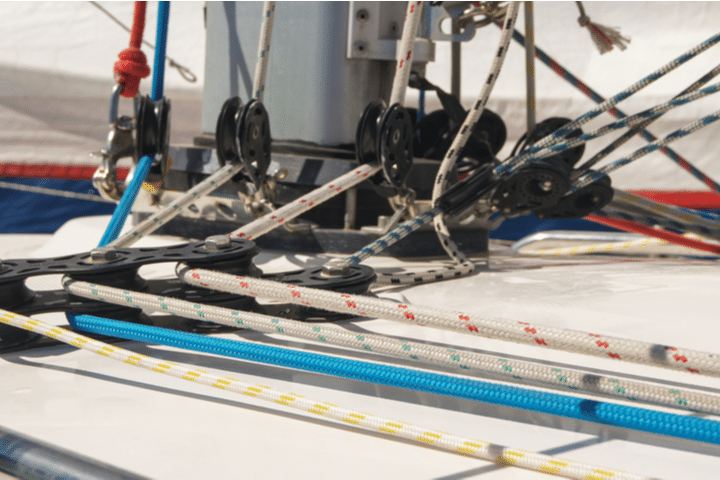
A Guide to the Different Parts of a Sailboat

Table of Contents
Last Updated on November 29, 2023 by Boatsetter Team
When you use Boatsetter, you have the opportunity to choose from a myriad of different sailboat rentals from all over the United States and beyond . A sailboat is a perfect way to relax on the water, either on a solo adventure or on an excursion with friends and family.
When you rent a sailboat with Boatsetter, you will have the option to book a captained sailboat to enjoy your day out on the water or book bareboat to hone your sailing skills. Either way, you may be interested in the intricacies of a sailboat and its different parts. If this sounds like you, you have come to the right place. In this article, we go in-depth about the different parts of a sailboat so that you can be more knowledgeable about whatever boat you may choose and come away from reading this feeling more confident about the whole sailing experience.
A basic sailboat is composed of at least 12 parts: the hull , the keel , the rudder , the mast, the mainsail, the boom, the kicking strap (boom vang), the topping lift, the jib, the spinnaker, the genoa, the backstay, and the forestay. Read all the way through for the definition of each sailboat part and to know how they work.
Explore sailboats for rent near you or wherever you want to go
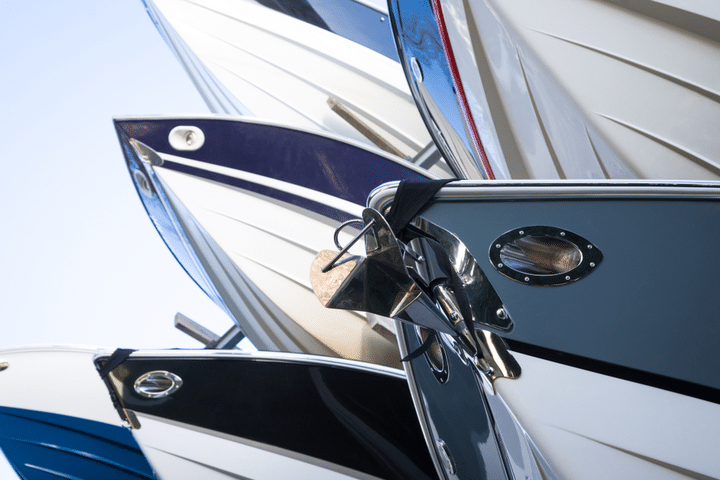
In short, the hull is the watertight body of the ship or boat. There are different types of hulls that a sailboat may have, and these different hulls will often affect the speed and stability of the boat.
Displacement Hulls
Most sailboats have displacement hulls , like round bottom hulls, which move through the water by pushing water aside and are designed to cut through the water with very little propulsion. The reason these are called displacement hulls is that if you lower the boat into the water, some of the water moves out of the way to adjust for the boat, and if you could weigh the displayed water, you would find that it equals the weight of the boat, and that weight is the boat’s displacement. One thing to know about displacement hulls is that boats with these hulls are usually limited to slower speeds.
Planing Hull
Another type of hull is a planing hull. These hulls are designed to rise and glide on top of the water when enough power is supplied. When there is not enough power behind the boat, these boats often act as displacement hulls, such as when a boat is at rest. However, they climb to the surface of the water as they begin to move faster. Unlike the round bottom displacement hulls, these planing hulls will often have flat or v-shaped bottoms. These are very common with motor-driven water vessels, such as pontoon boats, but they can also be found on smaller sailboats which allow them to glide quickly over the water.
Finally, sailboats can differ depending on the number of hulls that they have. There are three options: monohulls (one hull), catamarans (two hulls), and trimarans (three hulls).
Monohulls , which have only a single hull, will usually be the typical round bottom displacement hull or occasionally the flat bottomed or v-shaped planning hull. Catamarans have two hulls with a deck or a trampoline in between, with the extra hulls providing increased stability. Finally, trimarans have three hulls — a main hull in the middle and two side hulls used for stability. These trimarans have gained popularity because of their excellent stability and ability to go at high speeds.
When evaluating a sailboat , it is important to pay attention to the type of hull that the boat has because the type of hull a sailboat has can drastically change the sailing experience, especially when it comes to stability and speed.
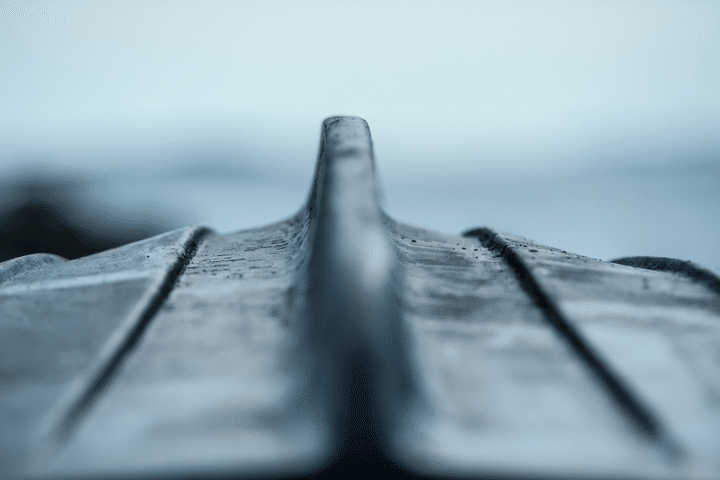
All sailboats have a keel, a flat blade sticking down into the water from the sailboat’s hull bottom. It has several functions: it provides counterbalance, life, controls sideways movement, holds the boat’s ballast , and helps prevent the boat from capsizing. When a boat leans from one side to the other, the keel and its ballast counteract the movement and prevent the boat from completely tipping over.
As with hulls, there are a number of different types of keels, though the two most common types of keels on recreational sailboats are the full keel or the fin keel. A full keel is larger than a fin keel and is much more stable. The full keel is generally half or more of the length of the sailboat. However, it is much slower than the fin keel. A fin keel, which is smaller than the full keel, offers less water resistance and therefore affords higher speeds.
A more recent feature on sailboats is the “winged keel,” which is short and shallow but carries a lot of weight in two “wings” that run sideways from the keel’s main part. Another more recent invention in sailing is the concept of the canting keels, which are designed to move the weight at the bottom of the sailboat to the upwind side. This invention allows the boat to carry more sails.
The Rudder
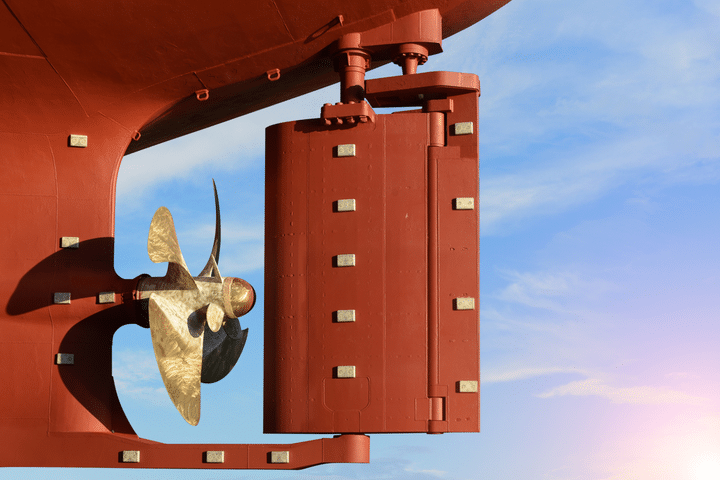
A rudder is the primary control surface used to steer a sailboat. A rudder is a vertical blade that is either attached to the flat surface of the boat’s stern (the back of the boat) or under the boat. The rudder works by deflecting water flow. When the person steering the boat turns the rudder, the water strikes it with increased force on one side and decreased force on the other, turning the boat in the direction of lower pressure.
On most smaller sailboats, the helmsman — the person steering the boat — uses a “ tiller ” to turn the rudder. The “tiller” is a stick made of wood or some type of metal attached to the top of the rudder. However, larger boats will generally use a wheel to steer the rudder since it provides greater leverage for turning the rudder, necessary for larger boats’ weight and water resistance.
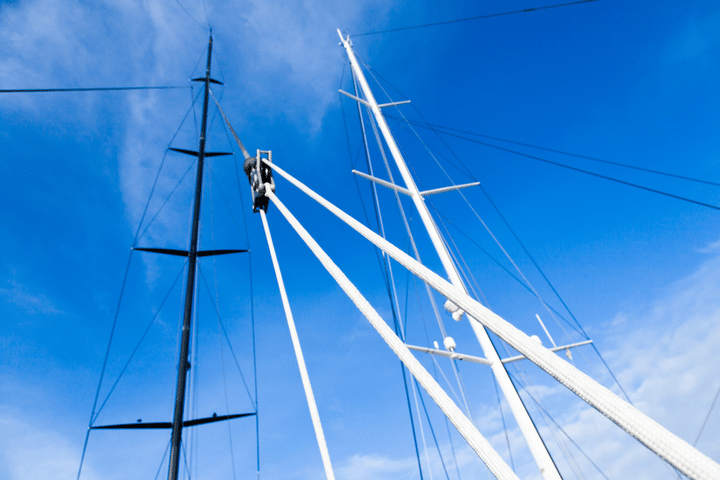
The mast of a sailboat is a tall vertical pole that supports the sails. Larger ships often have multiple masts. The different types of masts are as follows:
(1) The Foremast — This is the first mast near the bow (front) of the boat, and it is the mast that is before the mainmast.
(2) The Mainmast — This is the tallest mast, usually located near the ship’s center.
(3) The Mizzen mast — This is the third mast closest to the stern (back), immediately in the back of the mainmast. It is always shorter than the mainmast and is typically shorter than the foremast.
The Main Sail
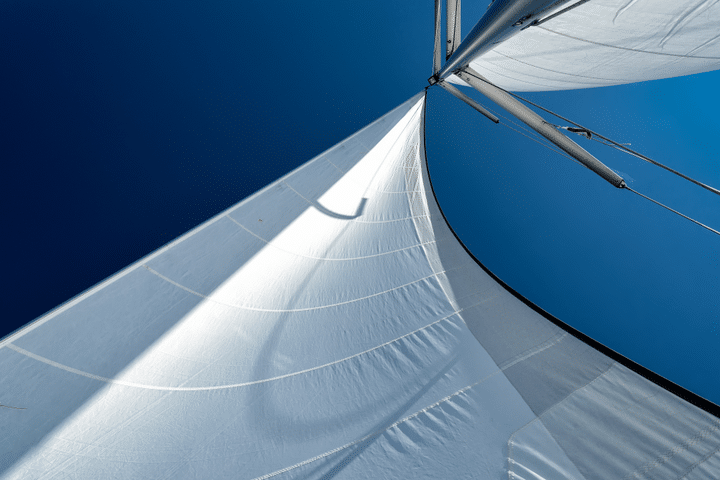
The mainsail is the principal sail on a sailboat, and it is set on the backside of the mainmast. It is the main source that propels the boat windward.
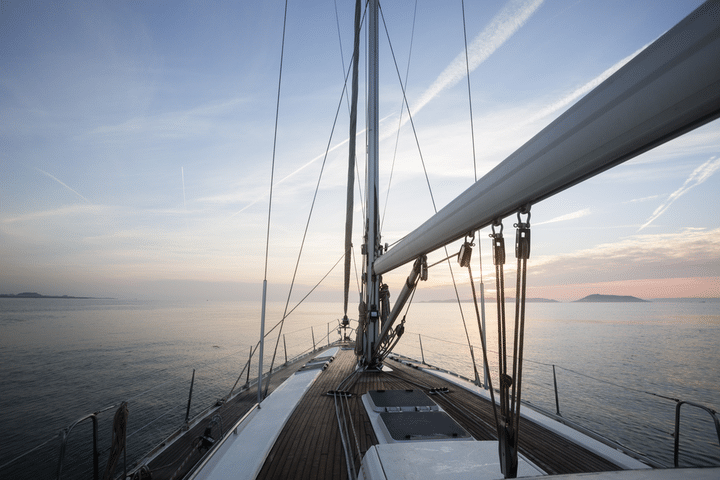
A boom is a spar (a pole made of wood or some other type of lightweight metal) along the bottom of a fore-and-aft rigged sail, which greatly improves the control of the angle and the shape of the sail, making it an indispensable tool for the navigation of the boat by controlling the sailes. The boom’s primary action is to keep the foot (bottom) of the sail flatter when the sail angle is away from the centerline of the sailboat.
The Kicking Strap (Boom Vang)
The boom vang is the line or piston system on a sailboat used to exert a downward force on the boom, enabling one to control the sail’s shape. The vang typically runs from the base of the mast to a point about a third of the way out the boom. It holds the boom down, enabling it to flatten the mainsail.
The Topping Lift
The topping lift is a line that is a part of the rigging on a sailboat, which applies an upward force on a spar (a pole) or a boom. Topping lifts are also used to hold a boom up when it’s sail is lowered. This line runs from the free end of the boom forward to the top of the mast. The line may run over a block at the top of the mast and down the deck to allow it to be adjusted.
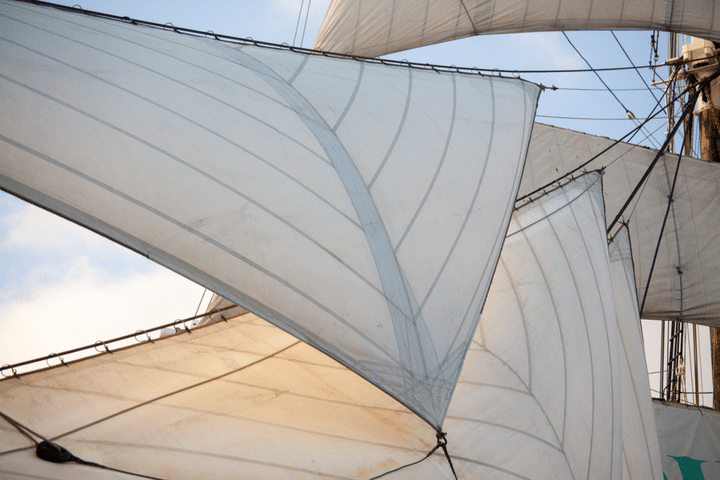
A jib is a triangular staysail set ahead of the foremost mast of a sailboat. Its tack is fixed to the bowsprit, the bow, or the deck between the bowsprit and the foremost mast. Jibs and spinnakers are the two main types of headsails on modern boats.
The Spinnaker
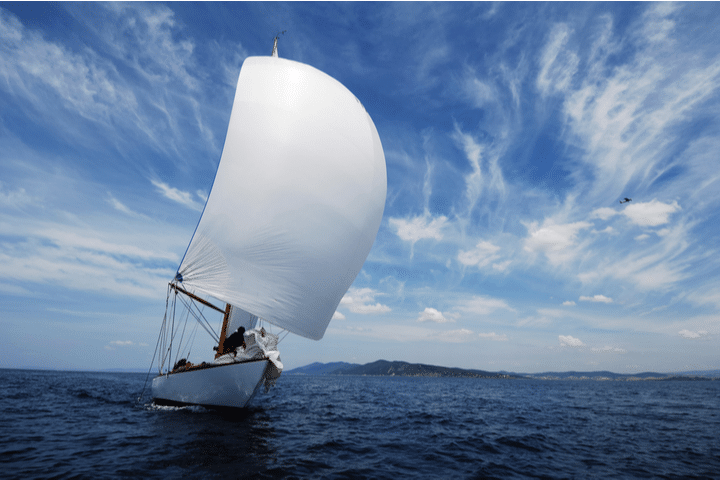
A spinnaker is a type of sail designed specifically for sailing off the wind from a reaching downwind course. The spinnaker fills up with wind and balloons out in front of the sailboat when it is deployed. This maneuver is called “flying.” The spinnaker is constructed of very lightweight material, such a nylon fabric and on many sailing vessels, it is very brightly colored.
Another name for the spinnaker is the “chute” because it often resembles a parachute, both in the material it is constructed from and its appearance when it is full of wind.
People often use the term genoa and jib as if they were the same thing, but there is a marked difference between these two types of sails. A job is no larger than a foretriangle, the triangular area formed by the mast, the deck or bowsprit, and the forestay. On the other hand, a genoa is larger than the jib, with part of the sail going past the mast and overlapping the mainsail. These two sails, however, serve very similar purposes.
The Backstay
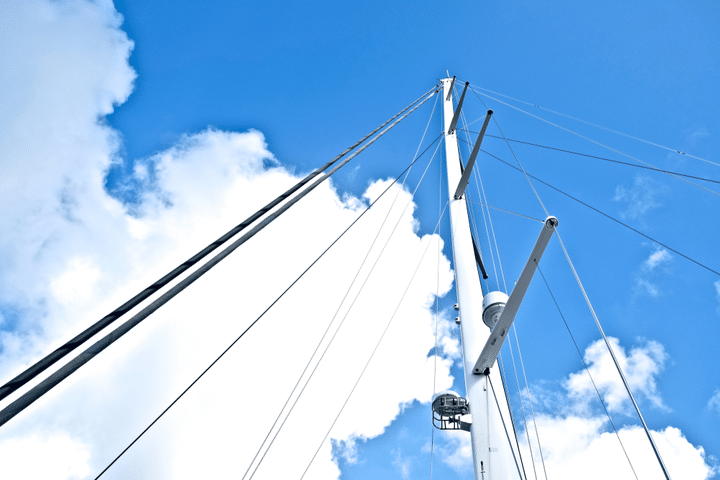
The backstay is a standing rigging that runs from the mast to the transom (the vertical section at the back of the boat), counteracting the forestay and the jib. The backstay is an important sail trip, control and directly affects the mainsail’s shape and the headsail.
There are two general categories of backstays:
1) A permanent backstay is attached to the top of the mast and may or may not be readily adjustable.
2) A running backstay is attached about two-thirds up the mast and sometimes at multiple locations along the mast. Most modern sailboats will have a permanent backstay, and some will have permanent backstays combined with a running backstay.
The Forestay
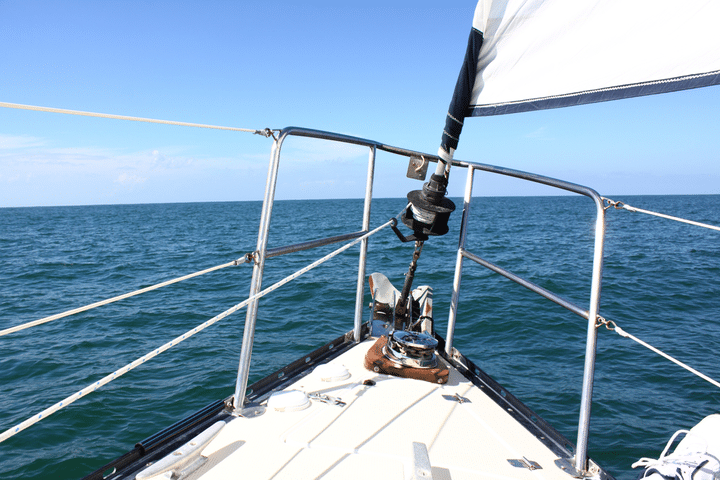
A forestay is a piece of standing rigging that keeps the mast from falling backward. It is attached at the very top of the mast, or at certain points near the top of the mast, with the other end of the forestay being attached to the bow (the front of the boat). Often a sail, such as a jib or a genoa, is attached to the forestay.
A forestay might be made from stainless steel wire, stainless steel rod or carbon rod, or galvanized wire or natural fibers.
Parts of a sail
Sails are vital for sailboats, made up of complex parts that improve performance and maneuverability. In this section, we’ll take a closer look at the different parts of that make up the sails.
Luff – The luff is a vertical sail part that maintains its shape and generates lift by interacting with the wind. It attaches securely with a bolt rope or luff tape for easy hoisting.
Leech – The leech controls air flow and reduces turbulence. Battens or leech lines are used to maintain shape and prevent fluttering.
Foot – The foot of a sail connects the luff and leech at the bottom edge. It helps define the sail’s shape and area. The outhaul is used to adjust its tension and shape.
Head – The sail’s head is where the luff and leech meet. It has a reinforced section for attaching the halyard to raise the sail.
Battens -The b attens are placed horizontally in sail pockets to maintain shape and optimize performance in varying wind conditions. They provide structural support from luff to leech.
Telltales – Sailors use telltales to adjust sail trim and ensure optimal performance.
Clew – The clew is important for shaping the sail and connecting the sheet, which regulates the angle and tension, producing energy. It’s located at the lower back corner of the sail.
Sailing is a favorite pastime for millions of Americans across the country. For some, there is nothing better than gliding across the water propelled by nothing more than the natural force of the wind alone. For both experienced and non-experienced sailors alike, Boatsetter is the perfect place to get your ideal sailboat rental from the mouthwatering Florida keys to the crystal blue waters of the Caribbean .
Smaller sailing boats are perfect for a single day out on the water, either by yourself or with friends and family. In comparison, larger sailing boats and sailing yachts can allow you days of luxury on longer excursions full of adventure and luxury.
Whatever your sailing dreams are, it is always good to know, for both the experienced sailor and the novice, all about the sailboat’s different parts. In this article, we learned all about the boat’s hull, the keel, the rudder, the mast, the mainsail, the boom, the kicking strap (boom vang), the topping lift, the jib, the spinnaker, the genoa, the backstay, and the forestay, which make up the basic parts of any sailboat you might find yourself on.
About us
Boatsetter is the go-to app for boat rentals and on-water experiences. Whatever the adventure, we’ve got a boat for that—Set sail , start the party , go yachting , make your trophy catch , and hone your watersports skills! Download the Boatsetter app ( App Store | Google Play ). Make sure to follow @boatsetter on Instagram, and tag us in all your boat day pictures for the chance to be featured.
Rent. List. Share—Only at Boatsetter

Boatsetter empowers people to explore with confidence by showing them a world of possibility on the water. Rent a boat, list your boat, or become a Boatsetter captain today.
Browse by experience

Explore articles
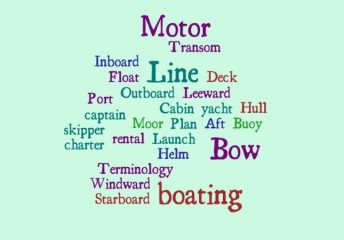
Boating Terms Every Boater Should Know
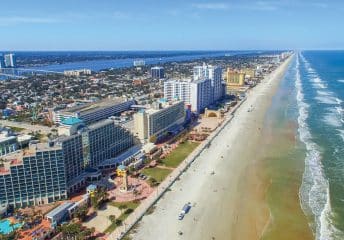
5 Best Fort Walton Beach Waterfront Restaurants
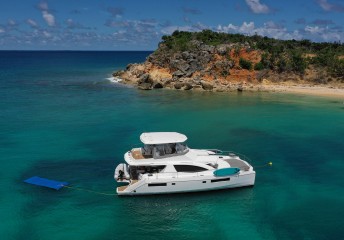
5 Reasons You Need to Island Hop the Caribbean this Fall

6 Best Restaurants on the Water in Canyon Lake, Texas
- Weekly Newsletter
California's Boating & Fishing News

Sailing 101: The Anatomy of the Sailboat
Ahoy sailors, welcome to the first article in a new series set on giving you a complete guide to the world of sailing. The Log will be compiling sailing information from experts so you will be well-versed in sailing in no time.
SOUTHERN CALIF.— There are many ways to learn to sail. You can jump in the boat with a friend and learn from experience, you can sign up for formal lessons, or if you can get your hands on a boat, you can try and teach yourself. No matter which method you prefer, it’s necessary to understand the boat and what it can do out on the water before you dive into your education.
The Basics of a Sailboat
Before setting sail, there is much you need to know. Gaining a basic knowledge of the boat’s anatomy will help the new sailor familiarize themselves with where and how the boat operates. Knowing the different parts of the sailboat is important for both safety and being able to sail your boat as flawlessly as possible.
- Block: This is the nautical term for a pulley.
- Boom: The horizontal support for the foot of the mainsail extends aft of the mast. Aft is the rear of the ship, at the direction of the ship’s stern. This is what you want to watch out for when changing directions in a sailboat. It can give you quite a bump on the head if it hits you.
- Bow: This is what the front of the boat is called.
- Centerboard: This is a (usually fiberglass) plate that pivots from the bottom of the keel (a flat blade sticking down into the water from the bottom of the sailboat) in some boats and balances the vessel when under sail.
- Cleat: Cleats are what lines (or ropes) get fastened to when they need to be kept tight.
- Halyard: Lines that raise or lower the sails. (Along with the sheets, aka running rigging.)
- Hull: The hull is the boat’s body and consists of everything below the deck.
- Jib: This is the sail at the bow of the boat. The jib helps propel the boat forward.
- Genoa: A foresail that is larger than a jib.
- Keel: The keel is what prevents a boat from sliding sideways (“making leeway”) in whatever way the wind is blowing and stabilizes the boat.
- Line: Lines are ropes. They are everywhere on boats. There is only one “rope” on a sailboat, the bolt rope that runs along the mainsail’s foot.
- Mainsail: It’s all in the name; this is the boat’s mainsail. It is the sail attached to the back of the mast.
- Mast: The mast is a large, vertical pole that holds the sails up. Some boats have more than one mast.
- Painter: This is a line positioned at the front of small boats. It is used to tie the boat to a dock or another boat.
- Rudder: The rudder is how the boat is steered. It is movable so that when you turn the wheel or tiller, the rudder directs the boat in the direction you would like to go.
- Sheets: The lines that control the sails, (also known as running rigging.)
- Spinnaker: The usually brightly colored sail used when sailing downwind or across the wind.
- Stays and Shrouds: Some wires ensure the mast stays upright, even in hefty winds, (also known as standing rigging.)
- Stern: The back of the boat.
- Tiller: The tiller is a stick attached to the rudder and controls the rudder.
- Transom: This can also be called the butt of the boat. It is the back part of the boat perpendicular to its centerline.
- Wheel: The wheel works the rudder, steering the boat.
- Winch: Winches help tighten the sheets and halyards. When these lines are wrapped around a winch (in a clockwise direction), a sailor can turn the winch with a winch handle, providing mechanical advantage, which makes it easier to bring in the lines.
Study these terms and distinguish where they are located on the boat. Retain that knowledge while the Log prepares for the next lesson in Sailing 101.
Share This:
- ← Blips on the Radar: Southern California oil spill
- Fast Facts: Red Light, Green Light →
One thought on “ Sailing 101: The Anatomy of the Sailboat ”
The timing of your article Sailing 101 turns out to be perfect for myself as I set a new course and plan to learn how to sail. After a lifetime of boating starting on the northeast coast and now in southern California, I have been fortunate to enjoy various types of power boats including trawlers. Now that my wife is done with boating I needed to find something to keep me on the water and stay young. Why not sailing? After a yearlong search for the “right boat” I commissioned the build of a 16′ Sandpiper Catsailboat built by Marshall Marine Corp, in Maine. With the boats ultra-wide beam of 7′ I felt it would offer the greatest stability for a beginner and its great classic looks add to its appeal. I look forward to following your article and learn as much as possible. Thank you
Comments Cancel reply
Your email address will not be published. Required fields are marked *
Your Thoughts are Appreciated
Save my name, email, and website in this browser for the next time I comment.

Basic Sailing Terminology: Sailboat Parts Explained
Sailing is a timeless activity that has captivated the hearts of adventurous souls for centuries. But, let’s face it, for beginners, sailing can be as intimidating as trying to navigate through a dark, labyrinthine maze with a blindfold on. The vast array of sailing terminology, sailboat parts and jargon can seem like a foreign language that only the most experienced seafarers can comprehend.
Fear not, intrepid sailor, for this comprehensive guide on basic sailing terminology for beginners will help you navigate the choppy waters of sailing jargon with ease. From learning the difference between the bow and stern to mastering the intricacies of sail trim, this article will equip you with all the knowledge you need to confidently take to the seas. So hoist the mainsail, batten down the hatches, and let’s set sail on this exciting journey of discovery!
Parts of a Sailboat
Before you can begin your sailing adventure, it’s important to familiarize yourself with the different parts of a sailboat. From the sleek bow to the sturdy keel, each component plays a vital role in keeping your vessel afloat and propelling you forward through the waves.

- Hull The main body of the boat that sits in the water and provides buoyancy and stability.
- Bow The front of the boat that meets the water and helps to determine its direction.
- Stern The rear of the boat where the rudder and motor are located.
- Deck The flat surface of the boat that you stand on, which can include various features such as seating, storage compartments, and hatches.
- Cockpit The recessed area of the deck where the skipper and crew sit or stand while sailing, which allows for easy access to the sail controls and provides protection from the wind and waves.
- Keel The long, fin-shaped structure beneath the waterline that helps to keep the boat stable and upright.
- Rudder The flat, vertical surface located at the stern of the boat that is used to steer and control the direction of the boat.
- Tiller or wheel The mechanism used to steer the boat, either in the form of a tiller (a handle attached to the rudder) or a wheel (similar to the steering wheel of a car).
- Mast The tall, vertical pole that supports the sails and allows you to catch the wind and move through the water.
- Boom The horizontal pole extending off the bottom of the mast that holds the bottom edge of the mainsail.
- Mainsail The large, triangular-shaped sail attached to the mast and boom that captures the wind’s power to propel the boat forward.
- Jib The smaller, triangular-shaped sail attached to the bow that helps to steer the boat and balance the force of the mainsail.
- Rigging The network of ropes and cables that hold the mast and sails in place and help control their movement.
Sail Terminology
Understanding the terminology associated with sails is critical to becoming a successful sailor. Here are 12 of the most important sail terms you should know, along with brief explanations for each:

- Luff The forward edge of a sail that is attached to the mast, allowing you to adjust the sail’s shape and angle to catch more wind.
- Leech The aft edge of a sail that is attached to the boom, which helps to control the sail’s shape and release the wind as needed.
- Foot The lower edge of a sail that is attached to the boom, which helps to control the sail’s shape and power.
- Head The top of a sail that is attached to the mast and controls the sail’s overall shape and angle.
- Battens The long, thin strips inserted into the pockets of a sail to help maintain its shape and stiffness.
- Clew The bottom corner of a sail that is attached to the boom or sheet, which helps to control the sail’s shape and power.
- Tack The bottom forward corner of a sail that is attached to the boat or a line, which helps to control the sail’s shape and power.
- Sail Area The total area of a sail, which is measured in square feet or meters.
- Sail Draft The curve or depth of a sail, which affects its performance and power.
- Sail Shape The overall form and contour of a sail, which is critical for catching the wind effectively.
- Reefing The process of reducing the sail area by partially lowering or folding the sail, which can be necessary in strong winds or heavy seas.
- Furling The process of rolling or folding a sail to reduce its size or stow it away, which is often used when entering or leaving port or in rough conditions.
Wind Direction and Sail Positioning
Understanding wind direction and sail positioning is crucial for successful sailing. Here are the key terms you need to know:
Types of Wind

- Apparent Wind The wind that is felt on the boat, which is a combination of the true wind and the wind generated by the boat’s movement.
- True Wind The actual direction and strength of the wind.
Points of Sail
You can find a detailed explanation of the points of sail here

- Close-Hauled Sailing as close to the wind as possible, with the sail set at a sharp angle to the boat.
- Beam Reach Sailing perpendicular to the wind, with the sail set at a right angle to the boat.
- Broad Reach Sailing with the wind at a diagonal angle behind the boat, with the sail angled away from the boat.
- Running Sailing directly downwind, with the sail on one side of the boat.
Other Terms
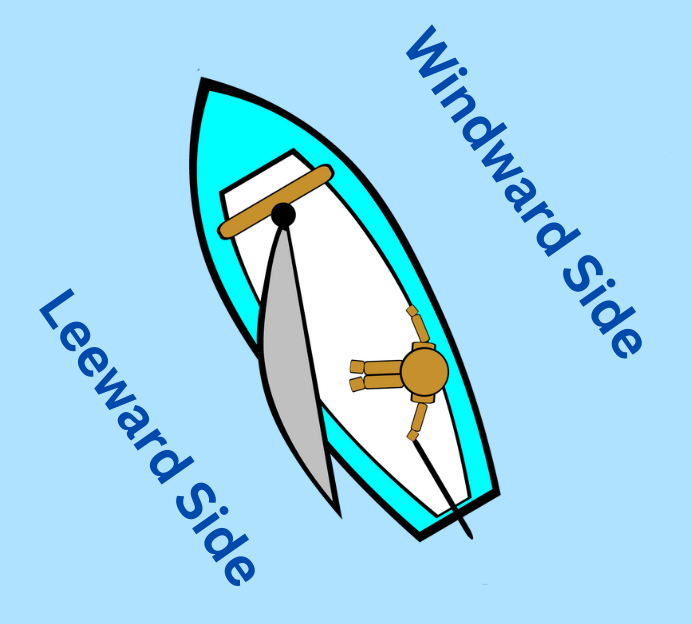
- Windward The side of the boat that is facing the wind.
- Leeward The side of the boat that is sheltered from the wind.
- Sail Trim Adjusting the sail and rigging to maximize the power and efficiency of the sailboat.
Navigation Terminology
Navigating a sailboat requires an understanding of a variety of nautical terms. Here are some of the most important terms you should know:
- Starboard Side The right side of a boat
- Port Side The left side of a boat
- Compass A device used for determining the boat’s heading or direction.
- Bearing The direction from the boat to a specific point on land or water.
- Chart A map or nautical publication that displays water depths, navigational aids, and other important information for safe navigation.
- Latitude The angular distance between the equator and a point on the earth’s surface, measured in degrees, minutes, and seconds.
- Longitude The angular distance between the prime meridian and a point on the earth’s surface, measured in degrees, minutes, and seconds.
- Course The direction in which the boat is traveling.
- Plotting The process of marking a course on a chart or map.
- Waypoint A specific point on a navigational chart or map that serves as a reference point for plotting a course.

- Tacking This maneuver involves turning the bow of the boat through the wind in order to change direction. To tack , the sailor will turn the helm towards the wind until the sails begin to luff, then quickly steer the boat in the opposite direction while adjusting the sails to catch the wind on the new tack.
- Jibing This maneuver is similar to tacking, but involves turning the stern of the boat through the wind. To jibe, the sailor will steer the boat downwind until the sails begin to luff, then quickly turn the stern of the boat in the opposite direction while adjusting the sails to catch the wind on the new tack.
- Heading up This maneuver involves turning the boat closer to the wind in order to sail upwind. To head up, the sailor will turn the helm towards the wind while simultaneously trimming the sails in to maintain speed and prevent the boat from stalling.
- Falling off This maneuver involves turning the boat away from the wind in order to sail downwind. To fall off, the sailor will steer the helm away from the wind while simultaneously easing the sails out to catch more wind and accelerate the boat.
- Docking This maneuver involves bringing the boat alongside a dock or other fixed object in order to moor or disembark. To dock, the sailor will typically approach the dock at a slow speed while using lines and fenders to control the boat’s position and prevent damage.
Knots and Lines
Learning the right knots and lines to use is essential for any sailor. Here are some of the most important knots and lines to know:
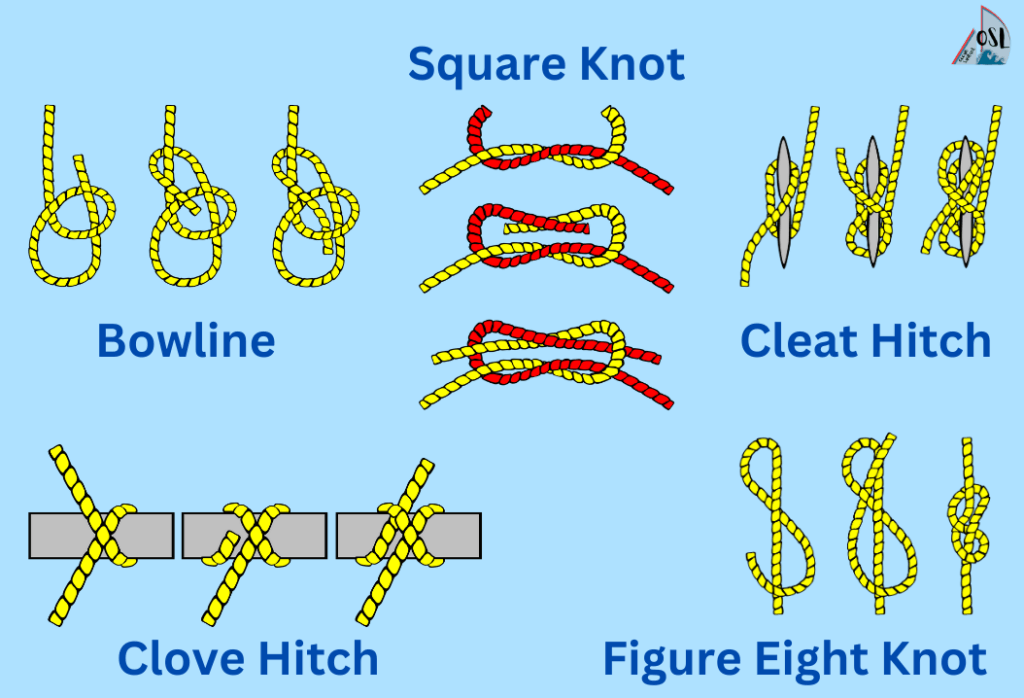
- Bowline This is a versatile knot used for many purposes, including attaching a line to a fixed object, such as a mooring or cleat.
- Square Knot A simple knot used to join two lines of the same diameter.
- Clove Hitch A quick and easy knot for attaching a line to a post or piling.
- Figure-Eight Knot A knot used to stop the end of a line from unraveling.
- Cleat Hitch A knot used to secure a line to a cleat.
- Sheet Bend A knot used to join two lines of different diameters.

- Main Halyard A line used to raise the mainsail.
- Jib Sheet A line used to control the angle of the jib.
- Mainsheet A line used to control the angle of the mainsail.
- Jib Furling Line A line used to furl the jib.
Sailing Safety
- Personal Flotation Devices (PFDs) These are the life jackets or vests that you must wear when on board to ensure your safety. Choose a PFD that fits you properly and is appropriate for your body weight.
- Tethers and Harnesses These are designed to keep you attached to the boat and prevent you from falling overboard. Make sure to clip yourself onto the boat when you’re on deck or going up to the mast.
- Man Overboard ( MOB ) Drill This is a critical safety procedure to practice with your crew. Learn how to quickly identify and recover someone who has fallen overboard.
- Emergency Position Indicating Radio Beacon (EPIRB) An EPIRB sends a distress signal and your location to rescue services in an emergency. Make sure it’s properly registered and in good working condition.
- Navigational Lights Ensure your boat has the required navigational lights and know how to use them properly. These lights help other boats see you in low-light conditions.
Remember that safety is always the top priority when sailing, and it’s essential to take it seriously.
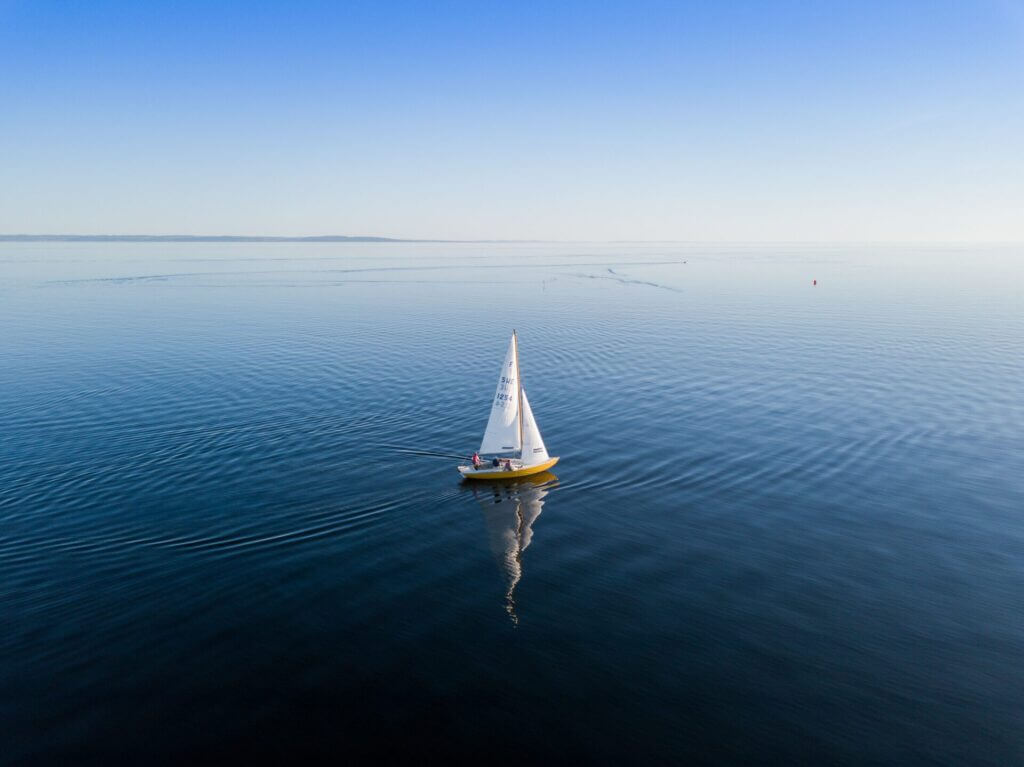
Sailing Terminology Conclusion
As we come to the end of our sailing terminology crash course, it’s important to remember that the world of sailing is vast and varied. Learning even the basics can be a daunting task, but with practice and perseverance, you’ll be able to hoist your sails and set a course for adventure.
Whether you’re a seasoned sailor or just starting out, understanding the terminology is crucial to ensure a safe and enjoyable voyage. From the parts of the boat to the knots and lines, each aspect plays a significant role in the overall sailing experience.
So, as you prepare to embark on your next sailing adventure, keep in mind the importance of safety, navigation, and proper etiquette on the water. And remember, when all else fails, just hoist the Jolly Roger and hope for the best! (Just kidding, don’t actually do that.) Happy sailing!
What is the difference between apparent wind and true wind?
Apparent wind is the wind felt by the sailor on the boat, while true wind is the wind direction and speed relative to the ground.
What are the points of sail?
The points of sail are the directions that a sailboat can travel in relation to the wind. They include upwind, close-hauled, beam reach, broad reach, and downwind.

What does it mean to be “on a reach”?
Being “on a reach” means sailing with the wind coming from the side of the boat, at a perpendicular angle to the boat’s direction.
What is tacking?
Tacking is the maneuver used to turn the boat’s bow through the wind, allowing the boat to change direction while still sailing upwind.
What is jibing?
Jibing is the maneuver used to turn the boat’s stern through the wind, allowing the boat to change direction while sailing downwind.
What is the difference between windward and leeward?
Windward is the side of the boat that is facing into the wind, while leeward is the side of the boat that is sheltered from the wind.
What is a boom vang?
A boom vang is a line used to control the position of the boom, which helps control the shape and position of the sail.
What is a cleat?
A cleat is a device used to secure a line to the boat, allowing the sailor to adjust the tension of the line without having to hold onto it constantly.
What is a winch?
A winch is a mechanical device used to control lines and adjust sails. It typically consists of a drum and handle that can be turned to wind or unwind a line.
Similar Posts
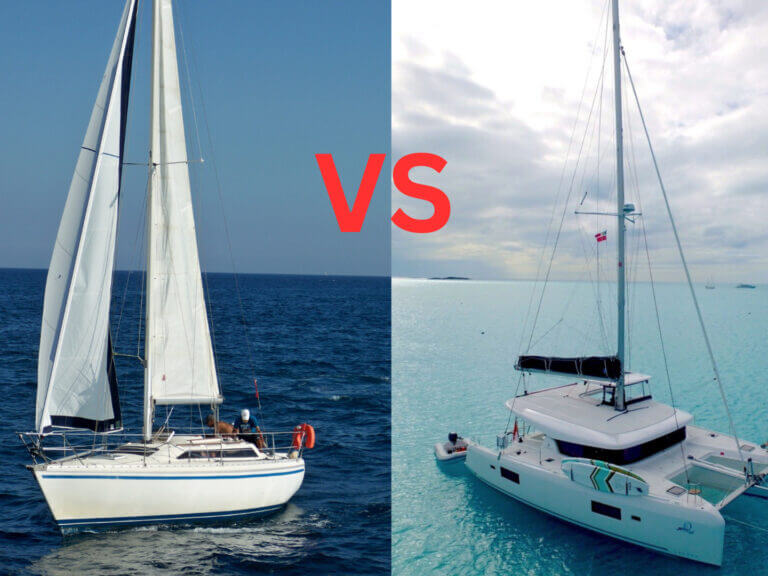
Monohulls vs. Catamarans: Which One is Best for You?
If you’re considering purchasing a sailboat, you might be wondering which type of vessel is best suited for your seafaring adventures. Fear not, for we’re here to help you weigh the differences between monohulls vs. catamarans to make an informed decision. Now, before we dive into the nitty-gritty details of hull design, sail handling, and…

Mainsail Furling Systems – Which one is right for you?
With the variety of options of mainsail furling systems available, including slab, in-boom, and in-mast systems, it can be challenging to determine which one best suits your needs. In this comprehensive guide, we will explore the pros and cons of each system, enabling you to make an informed decision that aligns with your sailing requirements….
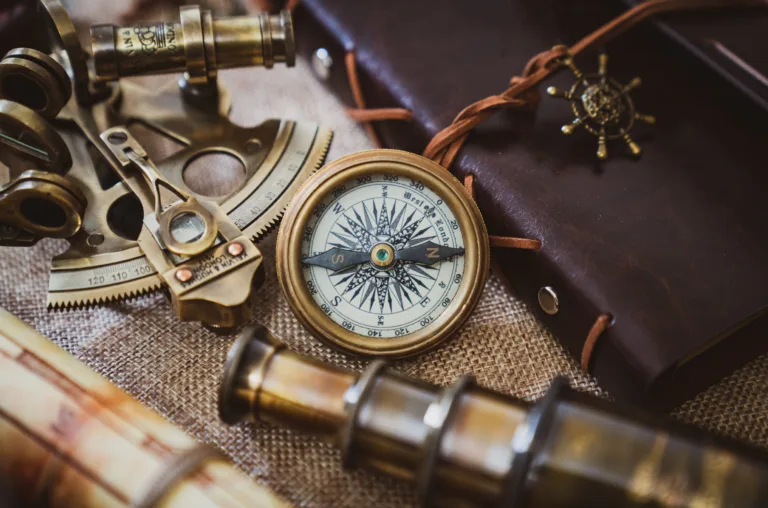
Sailboat Navigation: How to Navigate on Water
Mastering sailboat navigation is of paramount importance for sailors of all levels of experience. Whether you’re a seasoned sailor or a novice setting out on your first boating adventure, having a solid understanding of marine navigation is essential for your safety and confidence on the open waters. By honing your navigational skills, you can ensure…
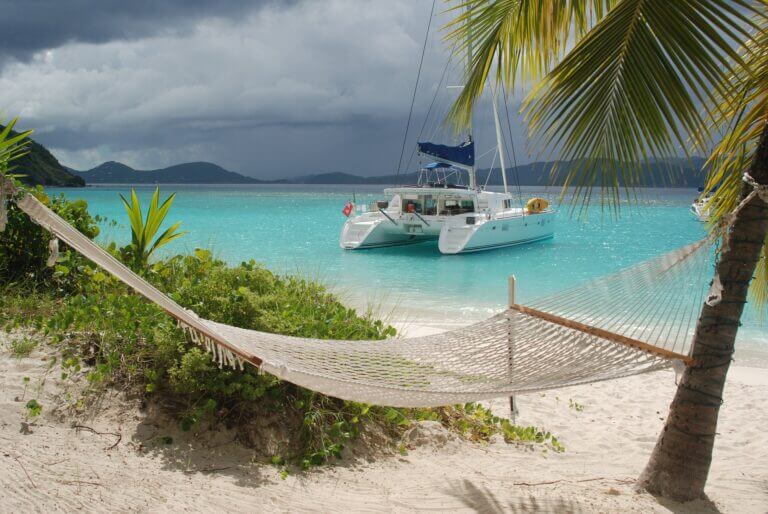
Advantages of Catamaran Sailboat Charter
A catamaran sailboat charter is an exciting way to explore the beauty of the sea. Whether you are an experienced sailor or a first-timer, booking a catamaran sailboat charter has a lot of advantages that you can enjoy. In this article, we will discuss the advantages of booking a catamaran sailboat charter, so that you…
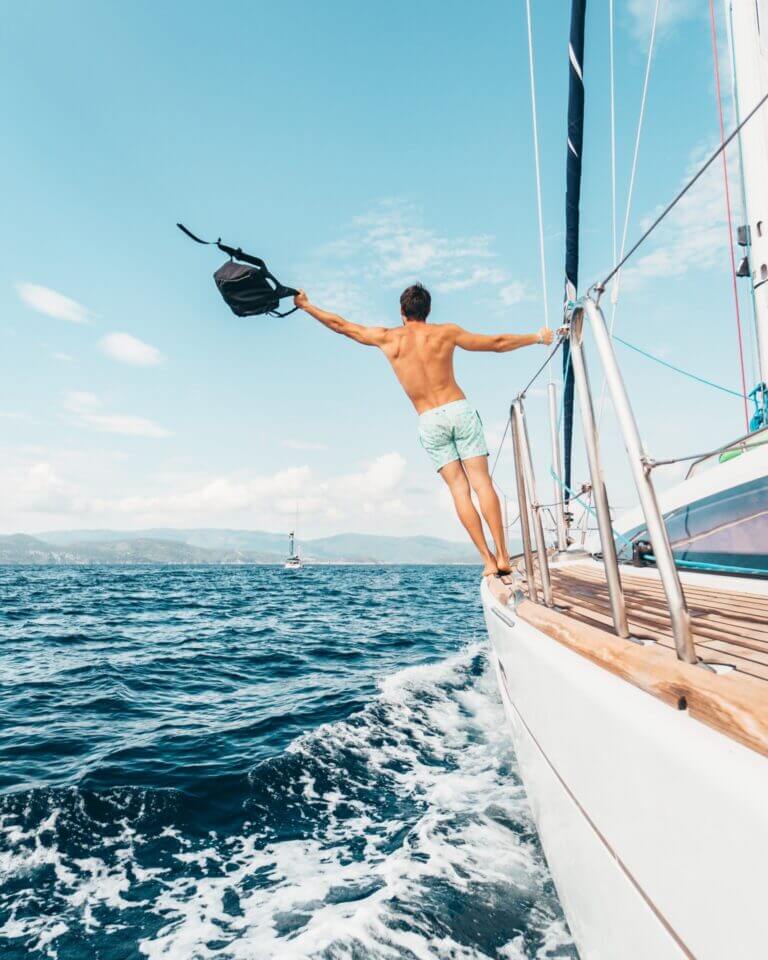
Navigating Life’s Storms: 7 Life Lessons from Sailing
Sailing is more than just a hobby; it is a lifestyle that can help you develop a wide range of skills and abilities. Whether you are a seasoned sailor or just starting, the 7 life lessons from sailing can be applied to various aspects of your life, from your personal relationships to your professional endeavors….

Anchoring Tips for Beginners
Are you ready to set sail on a journey to become anchoring aficionados? Anchoring a sailing yacht may seem like a simple task, but let me tell you, it’s no small feat. It requires a blend of nautical knowledge, careful planning, and a dash of luck (and a pinch of salt, if you ask any…

Understanding the Different Parts of a Sailboat
by boatshowhou | May 22, 2014 | Blog | 3 comments

Have you ever thought about learning how to sail? If so, then you should start by understanding the different parts of a sailboat if you want to sail your boat as efficiently as possible. Here they are in alphabetical order:
- Block: This is the nautical term for a pulley.
- Boom: The horizontal support for the foot of the mainsail which extends aft of the mast. This is what you want to watch out for when changing directions in a sailboat. It can give you quite a wallop on the head if it hits you.
- Bow: This is what the front of the boat is called.
- Centerboard: This is a (usually fibreglass) plate that pivots from the bottom of the keel in some boats and is used to balance the boat when under sail.
- Cleat: Cleats are what lines (or ropes) get fastened to when they need to be kept tight.
- Halyard: Lines that raise or lower the sails. (Along with the sheets, aka running rigging.)
- Hull: The hull is the body of the boat and consists of everything below the deck.
- Jib: This is the sail at the bow of the boat. The jib helps propel the boat forward.
- Genoa: A foresail which is larger in size than a jib.
- Keel: The keel is what prevents a boat from sliding sideways (“making leeway”) in whatever way the wind is blowing and stabilizes the boat.
- Line: Lines are ropes. They are everywhere on boats. There is only one “rope” on a sailboat, the bolt rope which runs along the foot of the mainsail.
- Mainsail: As the name implies, this is the main sail of the boat. It is the sail attached to the back of the mast.
- Mast: The mast is a large, vertical pole that holds the sails up. Some boats have more than one mast.
- Painter: This is a line positioned at the front of small boats. It is used to tie the boat to a dock or another boat.
- Rudder: The rudder is how the boat is steered. It is moveable so that when you turn the wheel or tiller, the rudder directs the boat in the direction you would like the boat to go.
- Sheets: The lines that control the sails. (aka running rigging.)
- Spinnaker: The usually brightly colored sail used when sailing downwind or across the wind.
- Stays and Shrouds: There are wires that make sure the mast stays upright, even in very heavy winds. (aka standing rigging.)
- Stern: This is the term for the back of the boat.
- Tiller: The tiller is a stick attached to the rudder and is used to control the rudder.
- Transom: This is what we would call the butt of the boat. It is the back part of the boat that is perpendicular to its centerline.
- Wheel: The wheel works the rudder, steering the boat.
- Winch: Winches help bring in the lines. When lines are wrapped around a winch, a sailor can turn the winch with a handle, which will make it easier to bring in the lines.
Ready to learn how to sail? There are great sailing classes that you can take right here close to home! One of them is in Seabrook called 3D Coast Captains – check them out – they’ll be at the June Boat Show along with other exhibitors !
Follow Us: Facebook – Foursquare – Twitter – YouTube – LinkedIn
What does the sails actually do on a sailboat
Sails are an air foil like an airplane wing in that the wind flowing over the front and under the back of the sail forms a low air pressure in front of the sail and a higher pressure area behind the sail. This pulls the sail and thus the boat forward through the water. The sails are also used to turn the boat and they can be eased or released to slow or stop the boat.
What does the sails on a sail boat do
Submit a Comment Cancel reply
Your email address will not be published. Required fields are marked *
Sailing Orlando
Sharing the Beauty of Sailing with Central Florida
- Sailing Blog
Introduction to Sailing: Parts of a Sailboat

Learning how to sail a boat, using only the wind as your “motor” – can be a liberating experience. For some, sailing is the ultimate sensation of freedom. It is the ability to travel on only the “fuel” of mother nature. For anyone interested in learning how to sail – this article is an introduction to the sport of sailing by learning the parts of a sailboat.
What Makes up a Typical Boat?
There are many different types of boats or watercraft. Whether you’re on a canoe or large sailing vessel, these main directional terms will apply.
- Bow : The front of the boat is known as the bow.
- Stern : The back is called the stern of the boat. Whether you’re on a 16 foot Canoe or a 50 foot sailboat, you steer a boat from its stern.
- Starboard : The right side of the boat when facing forward.
- Port : The left side of the boat when facing forward. A trick to remember starboard vs port is that “Port” is on the “Left” and both words have only 4 letters!

Other Basic Parts of a Typical Boat
Below are other terms used to describe basic parts that can be found on most watercraft.
- Hull : This is the bottom of the boat that sits in the water. The hull can be made of many different materials depending on the type of boat you’re looking at. Boats can have one hull, known as a “mono-hull”; or a “multi-hull” like a Catamaran.
- Deck: Located above the water, the top of the boat is often referred to as the “deck”.
- Cockpit: This is where the pilot of the boat or “helmsman” will steer the boat.
- Transom: Located at the stern, this is usually where a motor or auxiliary power source is located or where the rudder for steering (which we’ll cover later) is mounted.

What is a Keel?
Located under the boat is the keel. The purpose of the keel is to keep a sailboat from slipping sideways through the water when sailing towards the wind.
There are different variations of a keel on a sailboat.
- Fixed Keel: Permanent structure. Boats with a fixed keel are often more sturdy on the water but have to maintain diligent awareness of the depth of the water. In shallow water, if a keel hits the bottom (also known as running aground), it can be more difficult to get off the bottom than other keels.
- Centerboard: Large blade extending below the waterline, usually placed at the center of the vessel. Unlike a fixed keel, a centerboard can swing up and back inside of the hull.
- Dagger-board: Large blade that is lowered straight down from the cockpit.
What are the Parts of a Sailboat?
In addition to the basic boat parts listed above, a sailboat has a sailing rig and other parts that lay below the waterline. These parts work together with the wind to move the boat forward. There are different variations of sailing rigs. However many sailboats use what’s known as a sloop rig. Below are typical parts for a sloop rigged sailboat.

- Fore-stay: Wire or line connecting the mast to the bow.
- Halyard (Jib): Line used to raise and lower a sail. (Ropes on a sailboat are called “lines” or “sheets”)
- Head (Jib): Top corner of the sail that connects to the halyard which raises the sail.
- Leech (Jib) : The edge of the sail between the head and clew also known as the trailing edge.
- Luff (Jib) : The front edge of the sail between the head of the sail and tack.
- Head sail or Jib: Smaller sail located ahead or forward of the mainsail. It’s usually connected to the fore-stay. There are different types of head sails, but many boats use a sail called a jib.
- Clew (Jib) : Back corner of the sail.
- Foot (Jib) : Bottom edge of the sail that lays along the boom.
- Deck : Top surface of the boat.
- Bow : Front of the boat
- Keel : As described above, located under the hull.
- Jib Sheet: Line used to control the movement of the jib or head sail inward or away from the centerline of the sailboat.
- Hull : Bottom of the boat
- Main sheet : Line used to control the movement of the main sail inward or away from the centerline of the boat.
- Stern : Back of the boat.
- Rudder : Large blade connected to the rear of the vessel below the waterline, used to steer the boat.
- Tiller : Pole connected to the rudder used to control the rudder’s direction.
- Boom : Horizontal pole extending back from the mast.
- Out-haul : Line that connects to the corner (or “clew”) of the sail and pulls back to the rear of the boom
- Clew (Main) : Back corner of the sail.
- Tack : The lower corner just below the head of the sail that attaches where the boom and mast meet. This corner is often marked with the logo of the sail manufacturer.
- Shrouds : Wires or lines connecting the mast to the deck on both the starboard and port sides.
- Leech (Main) : The edge of the sail between the head and clew also known as the trailing edge.
- Luff (Main) : The front edge of the sail between the head of the sail and tack that aligns with the Mast.
- Mainsail : The large, usually triangle shaped cloth or other material used to catch the wind. The mainsail will be “aft”, or behind, the mast.
- Batten : Long thin plastic strips that support the sail.
- Head (Main) : Top corner of the sail that connects to the halyard which raises the sail.
- Halyard (Main) : The line used to raise and lower the mainsail.
- Mast : Large, vertical pole extending up from the deck.
Other Terms Used on a Typical Sail Boat
Below are other terms used to describe typical parts found on a sailboat.
- Gooseneck : Where the boom attaches to the mast.
- Topping Lift : Holds the boom up when the sails are not yet hoisted. This is helpful in rigging the sails but is not available on all sailboats.
- Back-stay : Wire or line connecting the mast to the stern.
- Halyard : Line used to raise and lower a sail.
- Boom Vang : Lines that connect from the bottom of the boom to base of the mast which controls the shape of the sail. .
- Helm : Term used to describe the tiller/rudder combination. To “take the helm” is to take over steering the boat. Larger boats can have a traditional steering wheel at the helm instead of a tiller.
- Clet : A metal fixture located in various positions on the deck. These fixtures are used to tie lines for various reasons. The can be used to secure a boat to the dock, change sail position or attach fenders to the side.
While this article covers most of what you will find on a sailboat, they come in various shapes and sizes with various types of rigging and parts. In the next articles we will cover how to rig a sailboat followed by the basics of wind detection and how the direction of the wind maneuvers the boat.
Tell us in the comments if you have any specific questions about sailing you want us to cover in future articles!
You may also like.

Top 5 Essential Sailing Knots
Recent posts.

The Yearling Trail: A hike through history

Best Lakes for Boating in Central Florida
Hi, this is a comment. To get started with moderating, editing, and deleting comments, please visit the Comments screen in the dashboard. Commenter avatars come from Gravatar .
Comments are closed.

The simplest entrance to the world of sailing
Parts of a Sailboat – A Practical Overview
Main parts of a sailboat are explained for a Bermuda rigged sloop. This is the most widespread modern type of sailing boat and it is the boat type considered in this blog, as well as in Your First Sailing Handbook . For overview of other sailboat types and their classification see our post: Types of Sailboats .
The sloop normally sails with two sails: one mainsail and one foresail that is called a jib. Larger boats use an inboard engine, while smaller boats (usually shorter than 25 feet) may have an outboard engine. The engine drives the propeller providing thrust when sails are not used.

A typical sloop is shown in the figures below. The front part of a boat is called the bow, while the rear part is called the stern. A cockpit is a working area, towards the stern of a boat, from which the boat is steered and controlled. A boat is steered by turning the tiller which results in turning the rudder, since these two are connected with a shaft. When the rudder is turned off the centerline it makes the boat turn left or right. On bigger boats a steering wheel is used instead of a tiller. Forestay, backstay and shrouds are steel wires or rods that support the mast (collectively called standing rigging).
Some important lines are drawn in various colors in the figures below (see the legend where colors tell you which line is which). Halyards and topping lift are led to the top of the mast, then down through the mast; they exit the mast near the deck and are then directed to the cockpit as shown in the figures. Similarly, outhaul is led from the rear end of the boom, through the boom towards the mast and then to the cockpit. The main halyard and outhaul are used to stretch the mainsail, while the jib halyard is used for hoisting the jib. The topping lift supports the boom when the mainsail is not hoisted and it is run in the same way as the main halyard.
Mainsheet and vang are used to control the boom and the mainsail during sailing. Traveler and jib car are adjustable blocks running along tracks, through which sheets (mainsheet and jib sheets) are attached to the deck. Jib sheets are used to control the jib during sailing. All the above mentioned lines are collectively called running rigging.
Remark: The term rig comprises mast, boom, sails and rigging (both standing and running). A Bermuda rigged sloop may have different rig configurations.

All the lines running from the mast to the cockpit are led through the system of blocks and then through rope clutches, so that they can be put on the winches. Each line has its own clutch and each clutch has two positions: opened and closed. When the clutch is opened, the line can move freely in both directions. When the clutch is closed, the line can be pulled in only one direction (towards the cockpit), while the other direction is blocked. For example, pulling a halyard from the cockpit results in a sail being hoisted (a clutch is normally closed). To lower a sail, halyard must be eased (a clutch must be opened).
Winches facilitate tightening of the lines when they are under tension. Lines must always be put on the winch in the clockwise direction with a suitable number of turns. The stronger the force on the line, the more turns should be put on the winch. When the tension in the line becomes too strong to be pulled by hand, a handle is used.
Winches can be standard or self-tailing. They are both operated in the same way, except when using a handle. In this case, standard winches are best operated by two persons, i.e. one is tailing (pulling the free end of the line) while the other is turning the handle. On the other hand, self-tailing winches allow simple one-person operation, since they have self-tailing jaws. After the line has been put in these jaws, it is tailed automatically as the handle is being turned.

Vedran Bobanac
Vedran Bobanac has been sailing since the age of 10, while he has been working as a skipper and as a sailing instructor for almost 20 years now. He also holds PhD degree in electrical engineering and he enjoys using his technical knowledge, as well as pedagogical skills to teach sailing and publish sailing handbooks .

- Find A School
- Certifications
- North U Sail Trim
- Inside Sailing with Peter Isler
- Docking Made Easy
- Study Quizzes
- Bite-sized Lessons
- Fun Quizzes
- Sailing Challenge

The Anatomy of a Boat
By: Zeke Quezada, ASA Equipment , Learn To Sail , Sailboats
Do You Know the Parts of a Boat
Learning to sail is not just about feeling the wind in your sails. You also become familiar with the vessel that will be part of your new lifelong adventure. A sailboat can seem daunting with all its moving parts, but it is quite simple.
I recently learned the term Keel Hauling, and I was a bit shocked at not knowing the reference. When you sail, you take on an entirely new language of words, sayings, and jargon. A few of us sailors even embrace the same Jimmy Buffet songs as part of our perennial sailing playlist. (that is another story for a different time)
My wife, who has sailed for over 20 years, is competent under most conditions at sail and knows her way around our vessel, but I was surprised that she didn’t know some of the simple terms that we sailors use daily. There are some fundamental terms that all sailors learn as they begin their sailing career and the rest of the information follows along as you spend more time on the water.
When you embark on a sailing education in ASA 101 Basic Keelboat Sailing, you learn about the anatomy of a boat. These are part of the fundamentals of sailing. While these few terms are interchangeable among boats, they certainly are not the only terms you’ll learn, but they are the beginning of a new language when you become an ASA certified sailor.

This is a keelboat. It is different from a dinghy in that it is larger than 20 feet and has a keel. Keelboats start at around 20 feet with no upper limit in length. A 200-foot megayacht is considered a keelboat.
Sailboat Terminology

Dinghy – A small sailboat usually under 20 feet long and open for most of its length.

Keel – A fixed appendage on the bottom of the hull that provides sideways resistance needed to counter the force of the wind on the sails. The keel also carries ballast , usually iron or lead, the weight of which counteracts the force of the wind that causes a sailboat to heel , or lean over.
Hull – The watertight structural shell of a boat.
Bow – The forward part of a boat
Stern – The aft part of the boat.
Transom – The more or less flat surface that closes the hull at the stern
Rudder – The sailboat is steered by a fin-shaped appendage attached beneath the boat toward the stern which can be rotated to change the angle at which the water strikes it. Water must flow past the rudder in order fo rit to work so it will not turn the boat while at rest.
The rudder is controlled by a wheel or a tiller at the helm of the boat. The person steering the boat is the helmsman .
Cockpit – The area of the boat, usually recessed into the deck , from which the boat is steered and sailed.
Deck – The generally horizontal surface that encloses the top of the hull.
Companionway – The entrance from the cockpit or deck to the cabin.
Stanchion – A metal post that supports lifelines .
Lifeline – A wire supported on stanchions around the perimeter of the deck to prevent crew from falling overboard.
Pulpit – A guardrail at the bow or stern of a boat to which (usually) the lifelines are connected.
Learning to Sail
- ASA 101: What You’ll Learn ASA 101 is your introduction to Basic Keelboat Sailboat and is your key to a lifetime of sailing.
- How To Sail Sailing a boat is part art and part skill but few activities offer such a variety of pleasures as sailing. Something special occurs when you cast off the lines and leave your cares at the dock.
- 7 Tips For The Beginning Sailor There are the obvious things you need when you go sailing, sunscreen, a hat, a windbreaker, non-skid shoes, and wind. However, what do you really need to be ready to head out on the water?
- How To Learn To Sail You won’t have to buy a boat or learn a new language or buy a new wardrobe to get a taste for sailing. You can dictate how much you want to experience.
- Learning To Sail Is Just The Beginning Sailing means different things to different people. At ASA we understand that learning to sail is just the beginning of a relationship with a lifestyle that is infectious. Where will sailing take you? We have a few ideas but how you view sailing is the most important.
- What Is Your Role on a Boat? What type of sailor are you and what role do you take on the boat? Your ASA sailing education will prepare you to be a skipper on a sailing vessel and with that comes the responsibility of keeping your crew safe and ensuring the safety of the vessel you are sailing.
Related Posts:

- Learn To Sail
- Mobile Apps
- Online Courses
- Upcoming Courses
- Sailor Resources
- ASA Log Book
- Bite Sized Lessons
- Knots Made Easy
- Catamaran Challenge
- Sailing Vacations
- Sailing Cruises
- Charter Resources
- International Proficiency Certificate
- Find A Charter
- All Articles
- Sailing Tips
- Sailing Terms
- Destinations
- Environmental
- Initiatives
- Instructor Resources
- Become An Instructor
- Become An ASA School
- Member / Instructor Login
- Affiliate Login
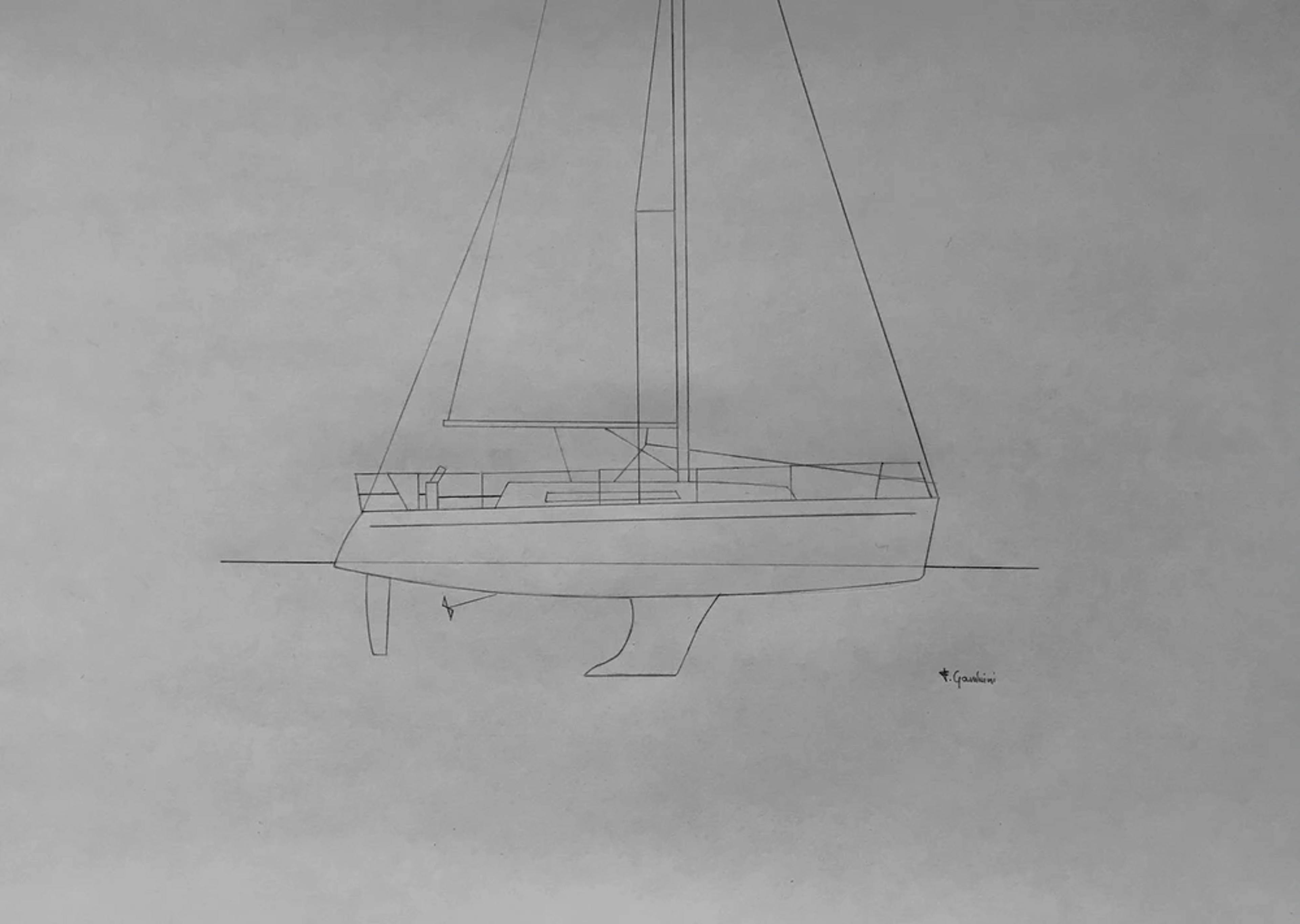
- Parts of a sailing boat: What's their use and can you locate them onboard?
From the bow to the stern
A sailing holiday is a holiday at sea... with a vitamin boost!
In fact, a sailing boat (I'm talking about a sailing boat, but what I've said is also valid for catamarans). Even if the size can feel relatively small, sailing boats hide lots of well-thought and organized spaces, each with its own peculiarities that we will discover during our holiday.
We will (soon) realize that some places are perfect for certain activities, while in others we will enjoy other moments of the day.
The sailing boat is a privileged point of view for a holiday at sea because it allows us to experience the sea... from the sea! This is no small detail...
Yacht charter: book your sailing holiday with us!
Let's start with the basics: what are the parts of a sailing boat .
A sailboat has a tapered shape. The front part is called the bow, whilst the back part is the stern.
Sailboats of the type we will be referring to here are called cabin boats because they have a living space inside the hull - namely, the cabin. Another aspect that identifies cabin boats is the keel's presence: a heavy ballast that ensures that it cannot tip over under any conditions. A cabin boat is clearly divided into an upper and lower section.
Above and below what? Above and below deck. The deck, otherwise known as the bridge, is the boat's outer surface, the one we walk on when we are outside. If we want to compare this space to your home, above you'll find the living area, and below, you'll have the sleeping area. It is above that we will spend most of our day on holiday, including meals.
The exterior and the cockpit
The external area is divided into three or four parts: Starting from the stern (we generally enter the boat from the rear, so this is in a sense our front door), we have the cockpit, which is the heart of the boat, this is where we will live most of our day, especially in summer. Bounded at the stern by the little beach and at the bow by the hatch, the opening that allows you to go below deck, the cockpit is a kind of living room of 4/6 square meters.
The cockpit, bordered by benches with soft cushions, features a helm wheel with all the nautical instruments and a superbly equipped table with lights, cup holders, and storage space for drinks and snacks.
You'll also find everything you might need to have at hand while sailing (sunglasses, hats, sun cream). The cockpit is naturally sheltered by the protected position, partially inserted inside the hull. The awning, also known as the bimini, shelters the cockpit from the sun (and rain). The canopy, also known as the sprayhood, shelters it from wind and water splashes. There is a central area in the middle of the boat with two walkways at the sides, mainly occupied by sail rigging but perfect for sunbathing as it is flat and a triangular area in the bow.
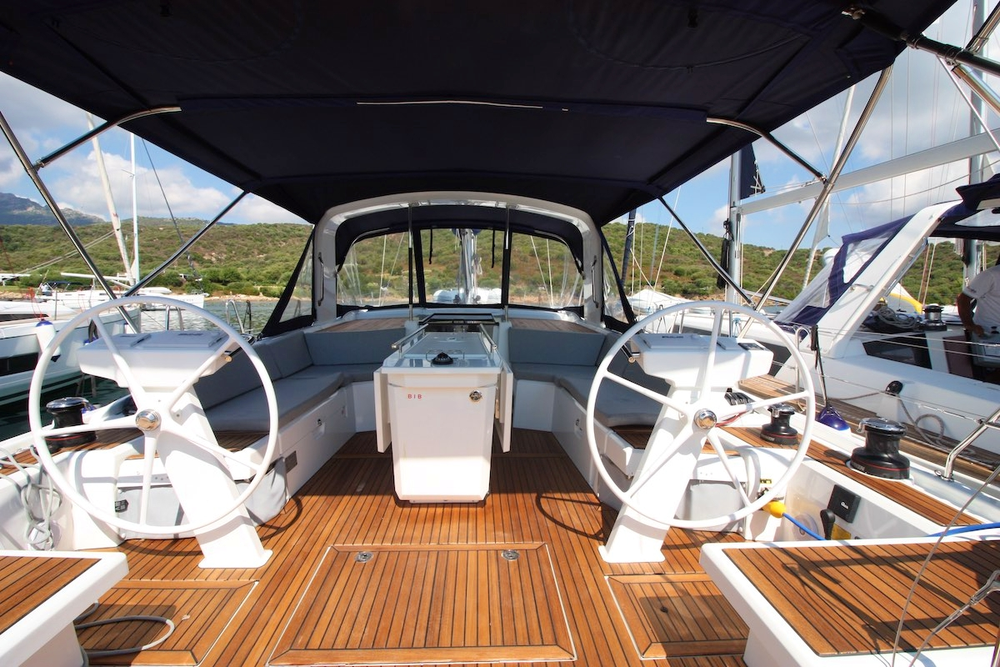
Exterior and the cockpit of a Beneteau Oceanis 46.1
Interior and dinette
After getting off, we will have the dinette, a sort of multifunctional living area with a small but well-equipped kitchen (two gas burners, two sinks, fresh and seawater at will, an under-sink fridge with a mini freezer).
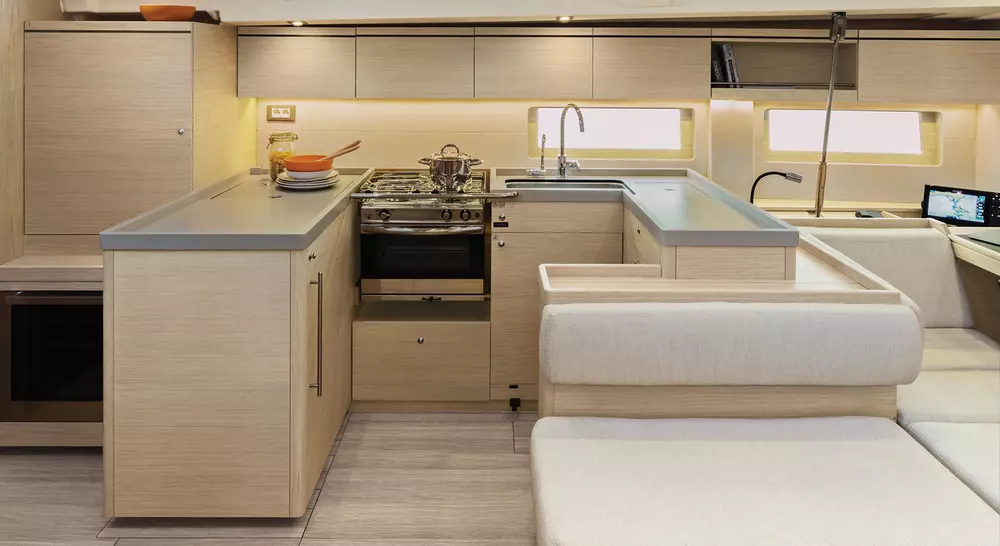
Interior and dinette of a Beneteau Oceanis 51.1
As in every house in every dinette, there is a table and chairs. Often the table is foldable to obtain two additional beds for friends passing through. On modern boats, this area, once the skipper's kingdom, is increasingly becoming the boat's technological heart, from all the monitoring takes place: the position of the boat, the battery charge, the water and fuel level, the switching on of all on-board equipment. For us, it's also where we charge our mobile phones.
This space is overlooked by the cabins and one or more bathrooms, small but very functional, in some cases with a separate shower. A sailboat, as the name implies, is characterised by the presence of sails. Sails are kept in position by the mast, which is made of aluminium. The mast is supported by strong steel cables: the one by the bow is called the forestay (to which the sail is wrapped around to form a soft sausage). The one at the stern, the forestay, often splits to facilitate boarding.
It is also excellent support for not one but two points of support.
On the right and left sides, the mast, which can be more than 15 metres high and is subjected to considerable strain, is supported by shrouds, one or more on each side, which reach right up to the outer side of the boat and are perfect for supporting it as it passes from stern to bow. In this article, I would like to point out two parts of the boat that I am sure you will appreciate to the fullest on your next sailing holiday. The first is the calling card of every holiday sailing boat, the stern platform, which can often be folded down. It is a platform on the surface of the water almost as wide as the boat itself, and its depth varies. Still, it is always enough to get in and out of the water and do all your favourite activities: yoga, diving, a snack, a nice shower or simply enjoy the moment with your feet underwater...
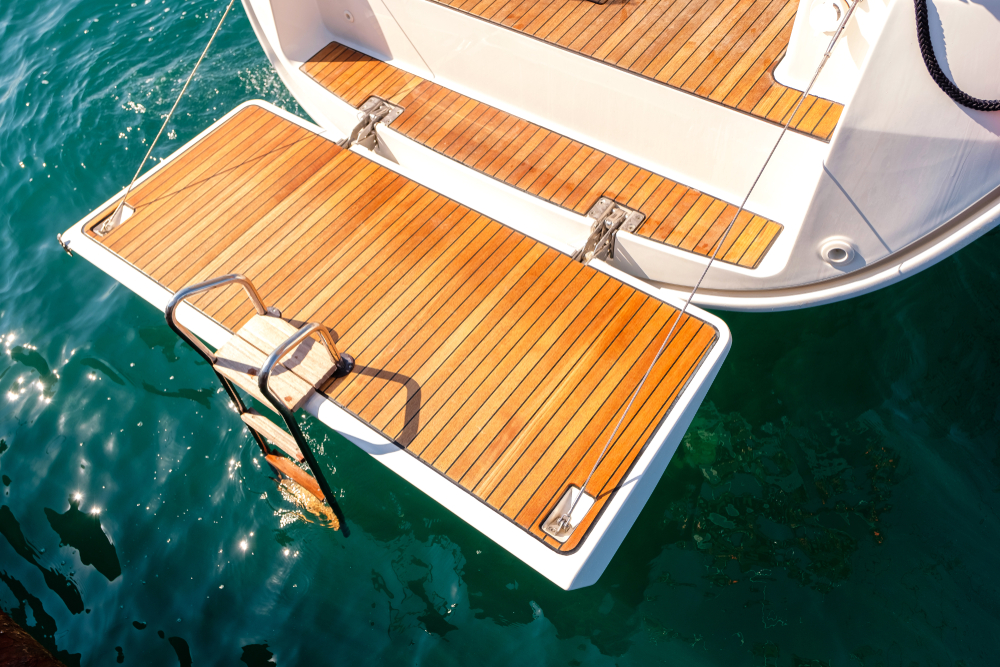
Deck of the sailing yacht from above
This delightful little balcony overlooking the sea also allows easy access on board in all conditions. The second is the bow of the boat itself, where the anchor winch is located. This area is often enhanced by a seat where we can sit back and watch the landscape change, "it's something I really like to do, especially on long motorboats," says Caterina, who has just returned from the Cyclades.
Yacht charter: book your sailing holiday with Sailogy
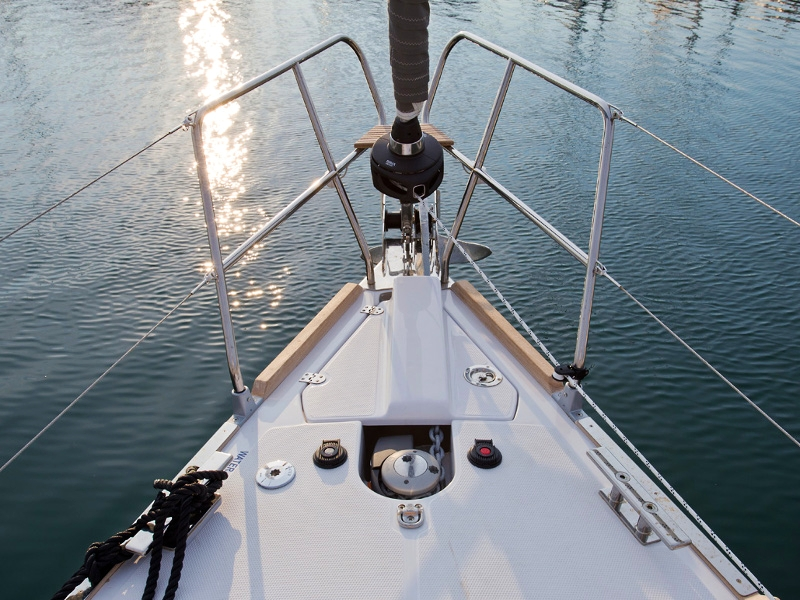
Elan Impression 45
Keep in mind while you're comfortably sitting on the bow and enjoying the scenery, not to end up in the water. You don't need to hold on with your hands. A good way is to put your legs on opposite sides of a candlestick.
A candlestick?!
Our boat is surrounded by a sort of safety railing: Let's see what it looks like: First of all, it is made up of rigid parts consisting of sturdy steel tube railings generally present at the bow and stern (pulpit) and flexible parts consisting of a set of vertical steel tubes firmly fixed to the deck of the boat (the stanchions) joined together by horizontal stainless steel cables (the dragnets).
A fine-meshed safety net can often be attached to these, which is advisable if there are children on board. What about you? What are your favourite parts of the boat?
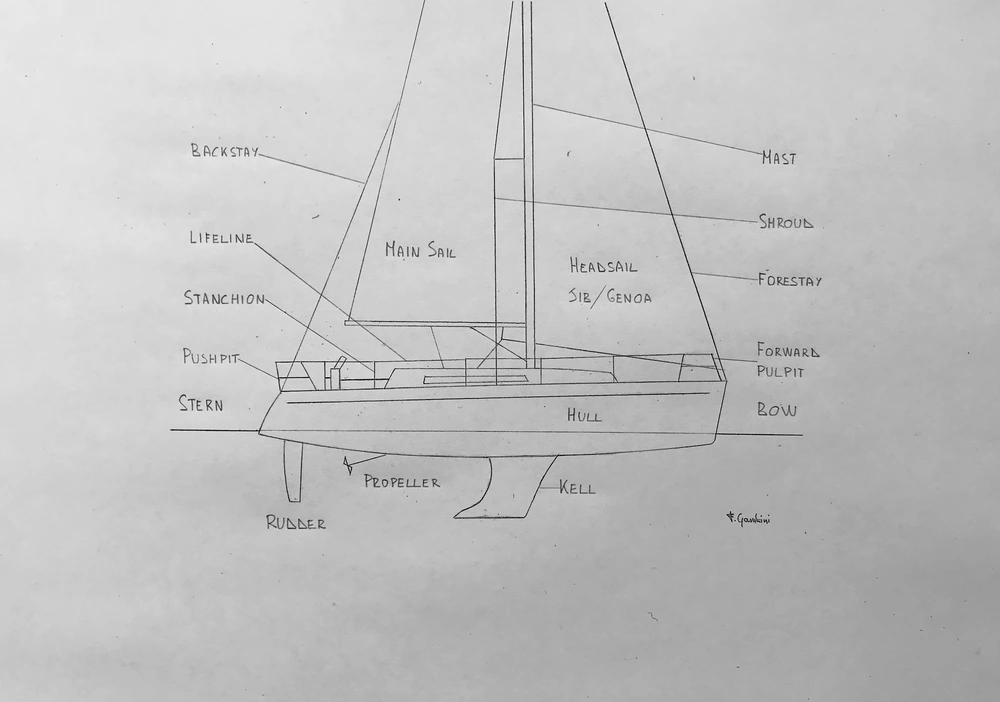
Discover our favorite yachts
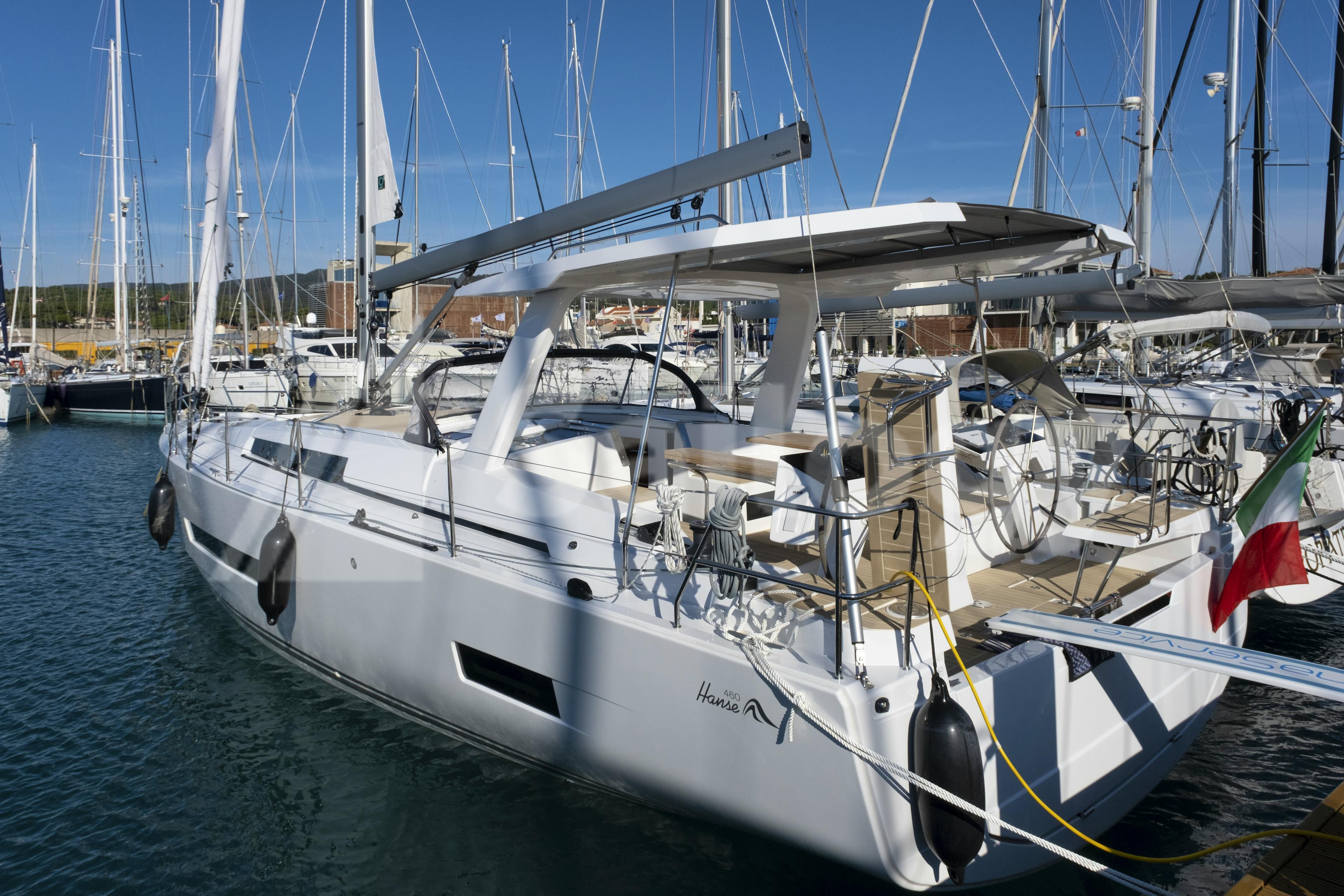
- Sailing boat
Castiglioncello, Tuscany
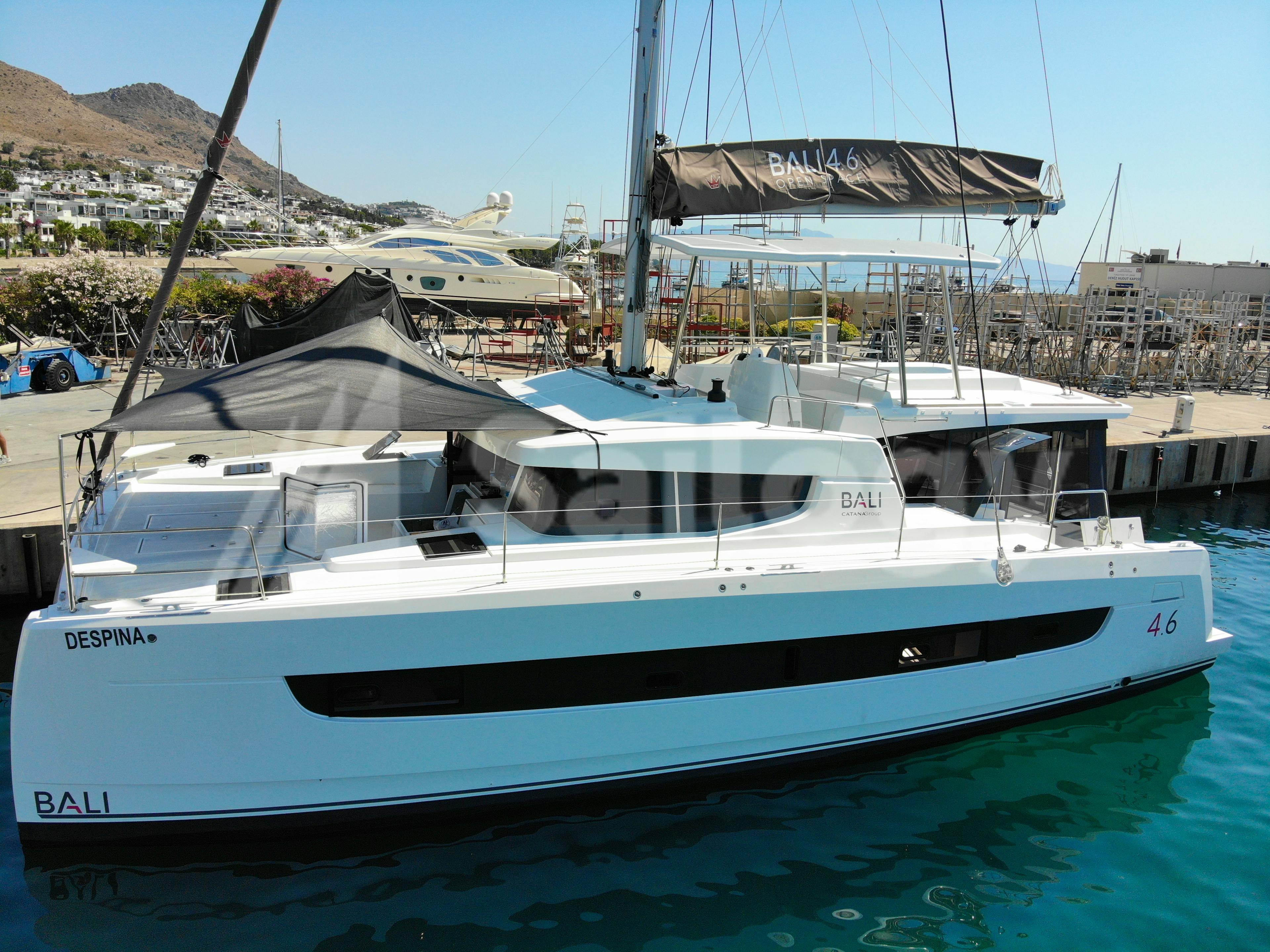
Gocek, Turkish Coast
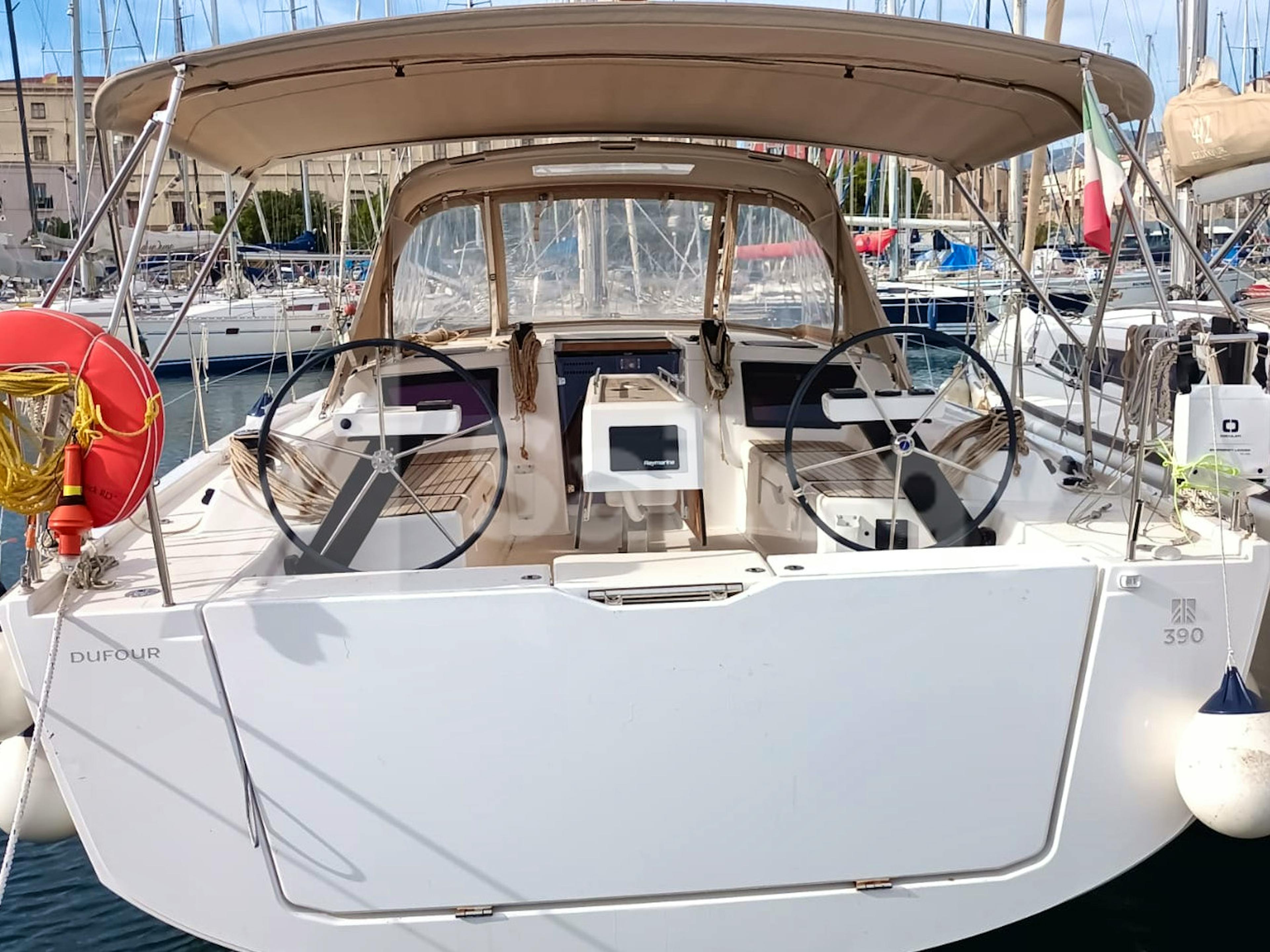
Dufour 390 Grand Large
Palermo, sicily.
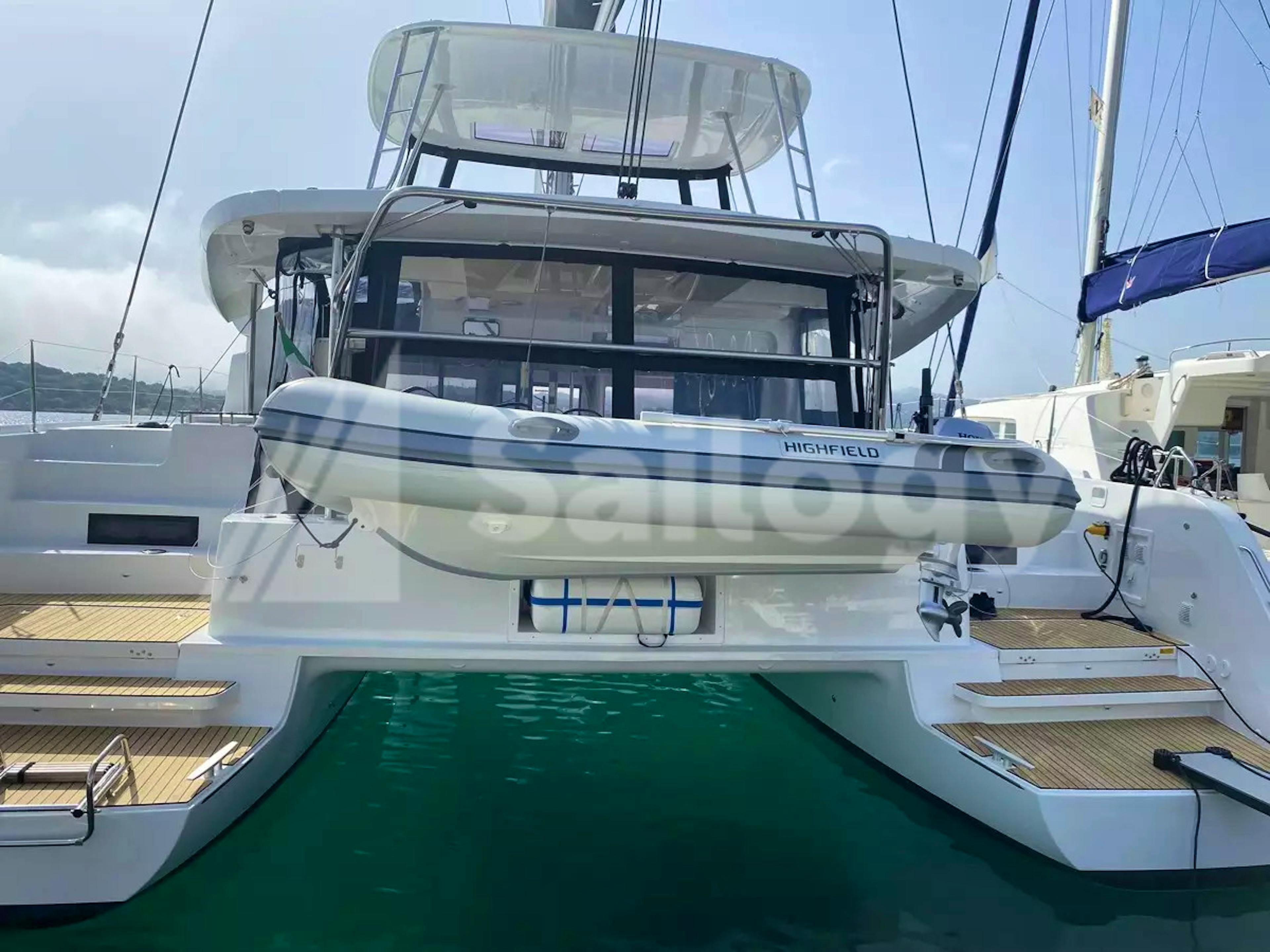
Portisco, Costa Smeralda
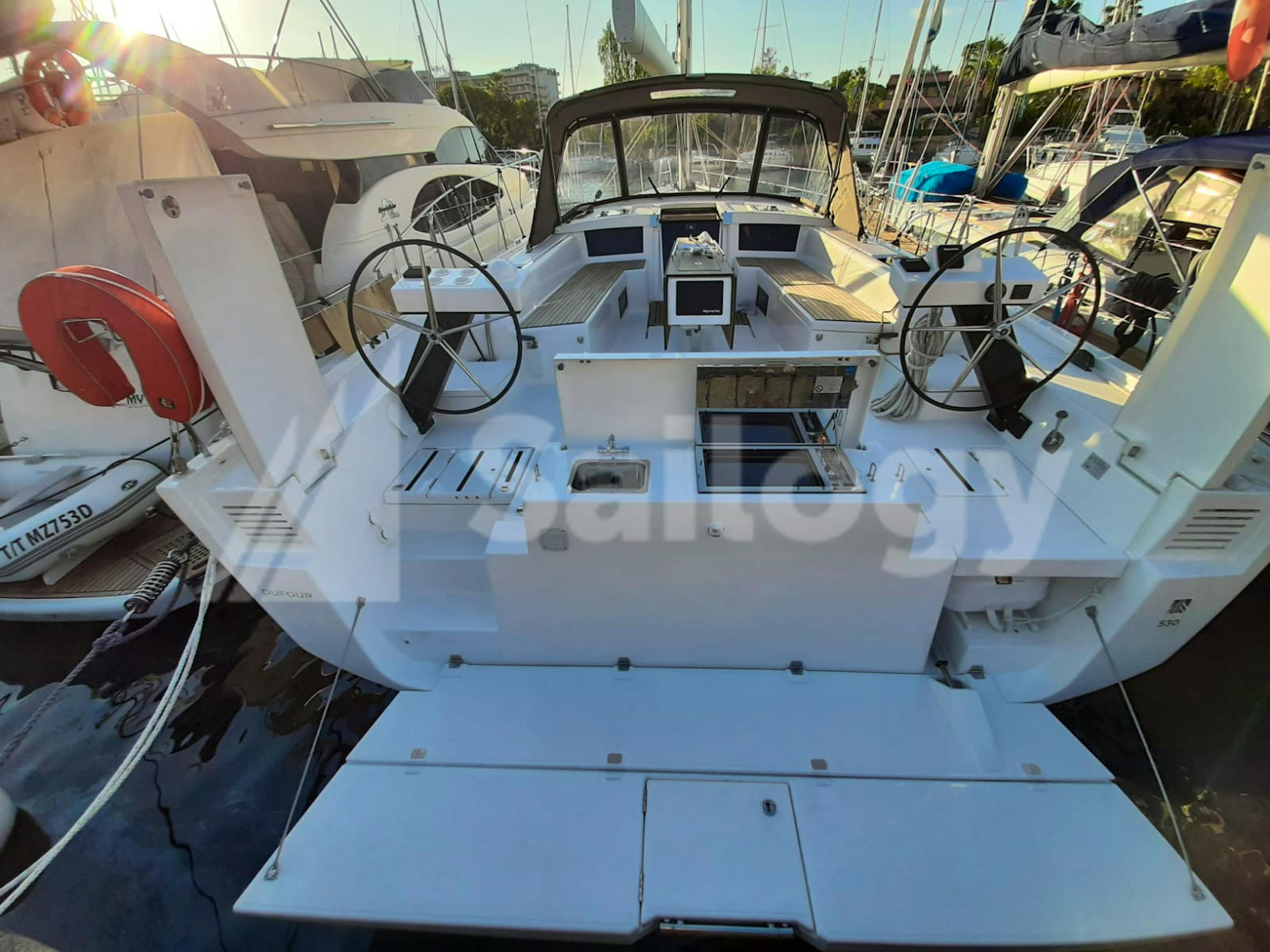
Portorosa, Aeolian Islands
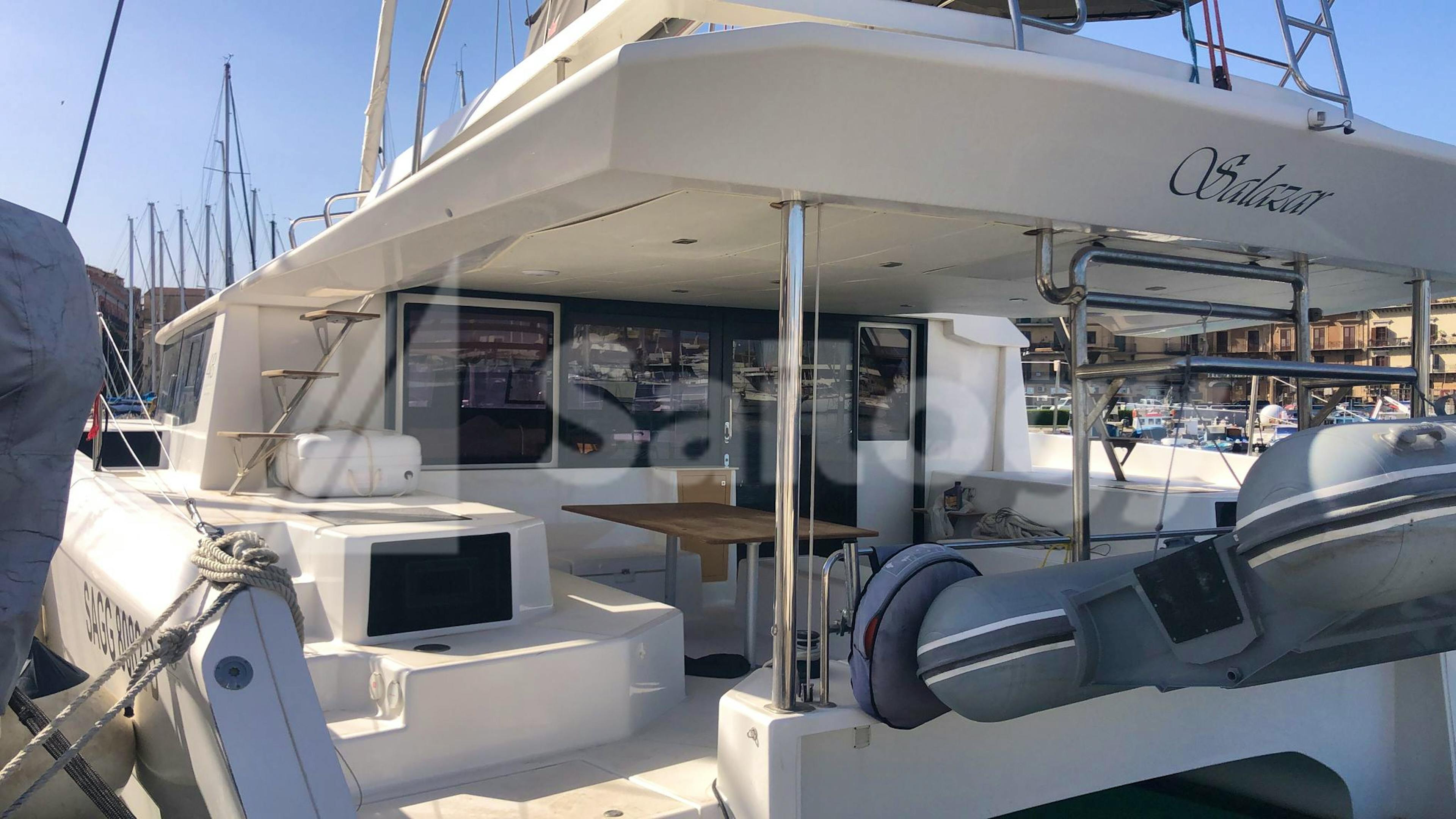
Dufour 430 Grand Large
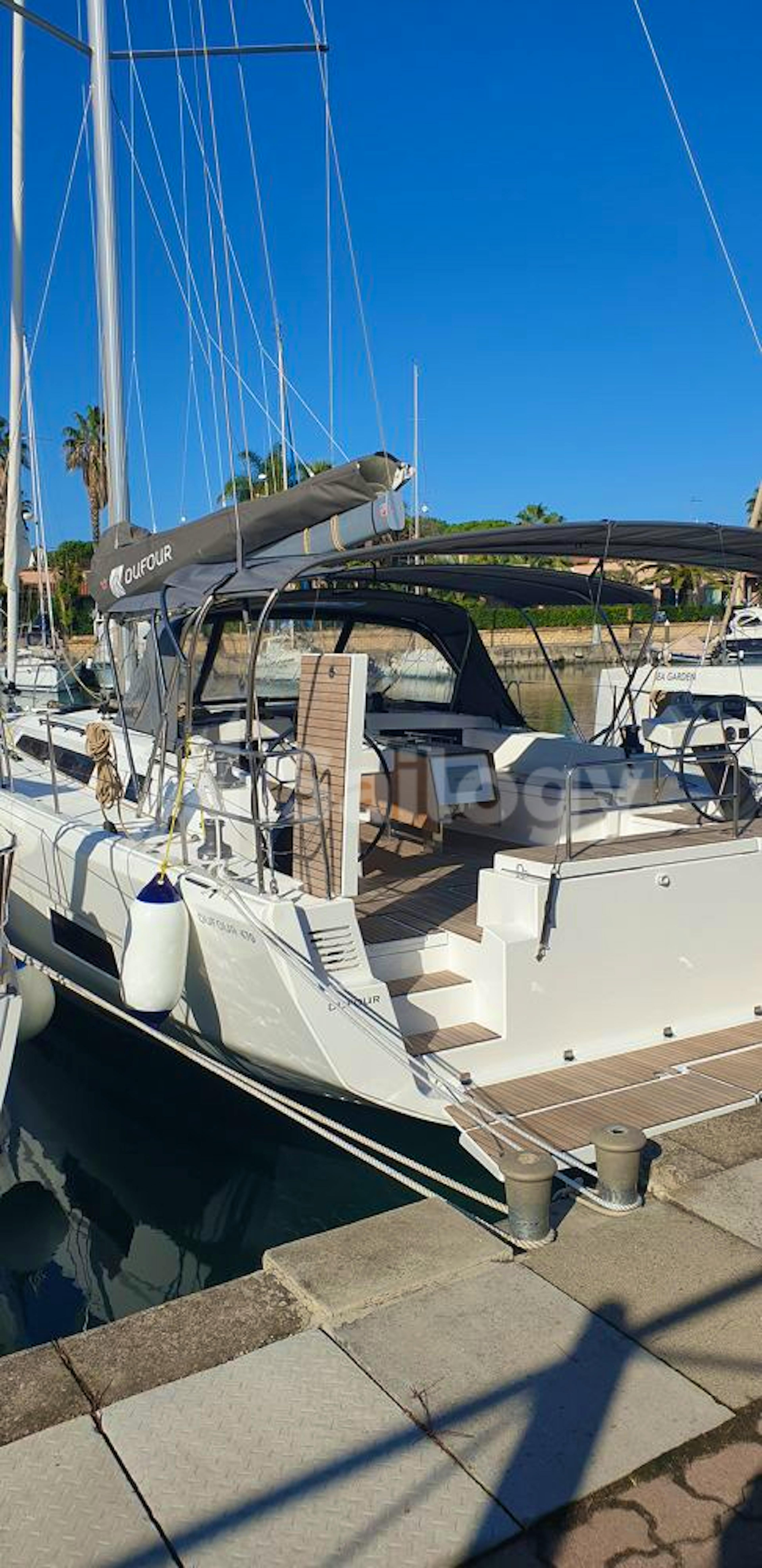
Other articles

7-day Sailing Itinerary in the Dodecanese Islands

What To Bring On a Boat

Kornati Islands Sailing: Best Spots To Visit By Boat
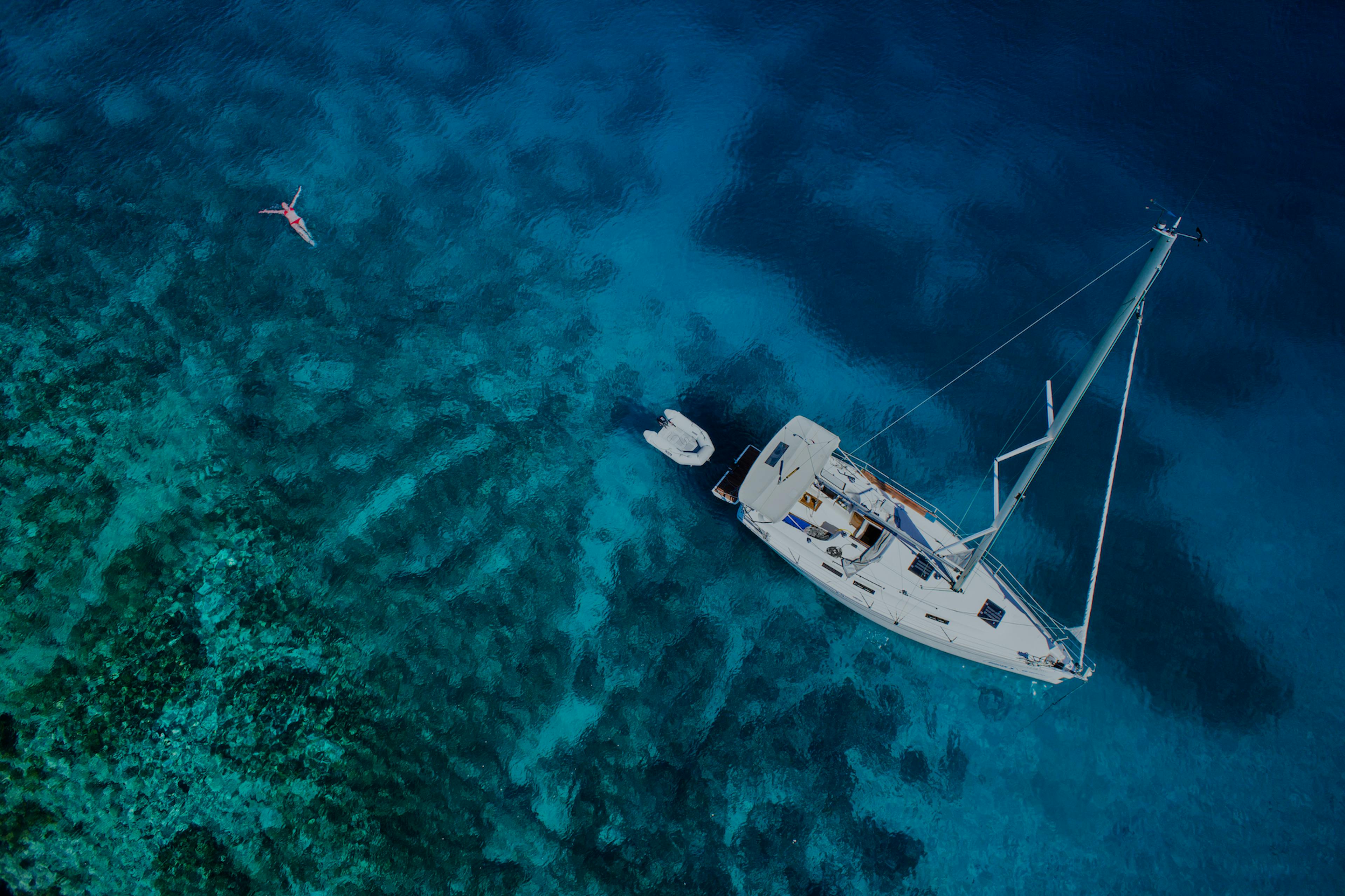
Stay in touch
New sailing magazine out now.
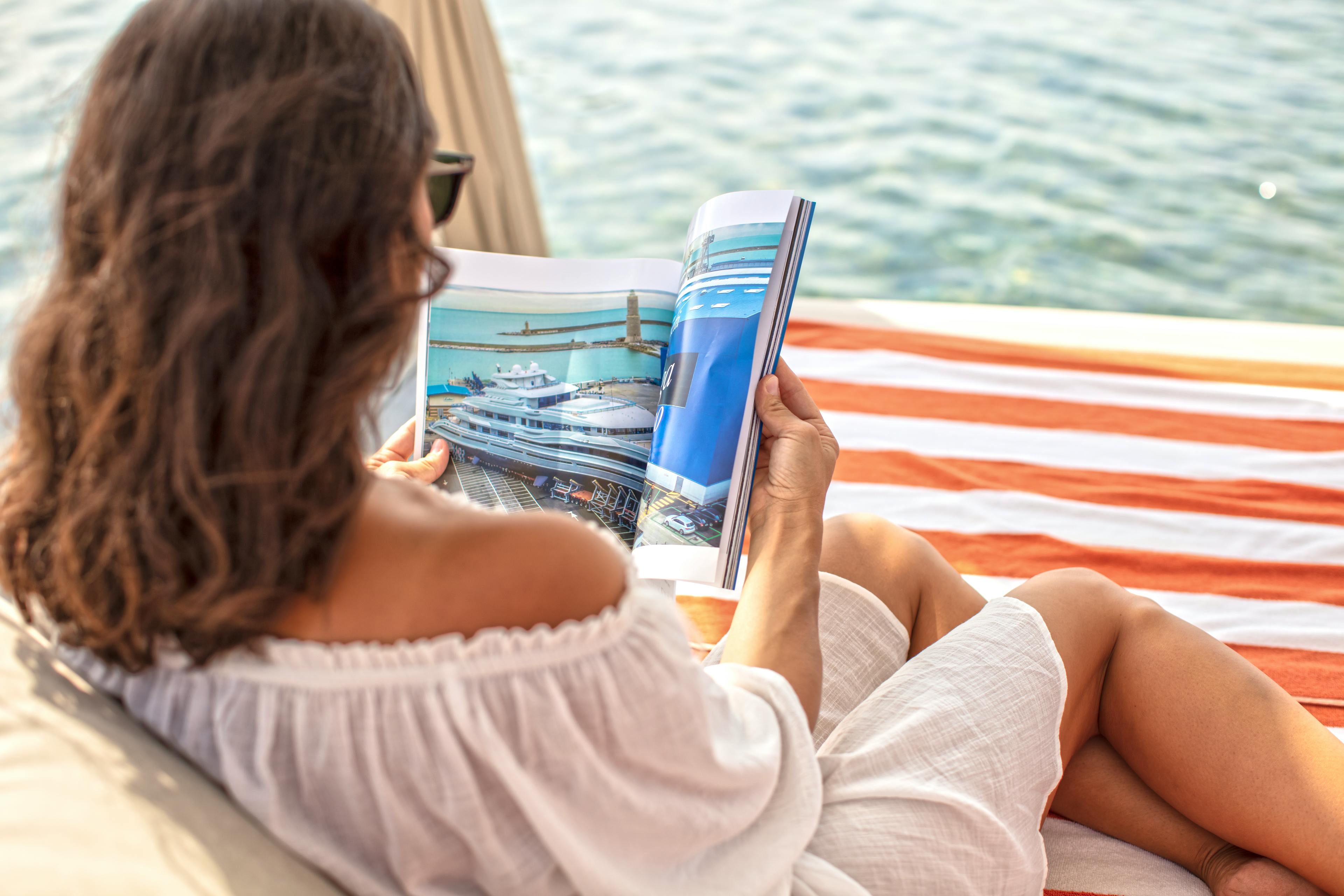
Sailing Basics: 10 Nautical and Sailing Terms To Learn

If you’re learning how to sail—or if you’re thinking about purchasing a sailboat of your own—these handy terms can provide a helpful overview of sailing basics you need to become familiar with.
Explore Sailboat Brands & Manufacturers
10 Nautical and Sailing Terms Everyone Should Know
1. aft .
The back of a ship. If something is located aft, it is at the back of the sailboat. The aft is also known as the stern.
2. Bow
The front of the ship is called the bow. Knowing the location of the bow of the boat is important for defining two of the other most common sailing terms: port (left of the bow) and starboard side (right of the bow).
3. Port
Port is always the left-hand side of the boat when you are facing the bow. Because “right” and “left” can become confusing sailing terms when used out in the open waters, port defines the left side of the boat as it relates to the bow or front.
Read Next: Beginner Sailing Tips
4. Starboard
Starboard is always the right-hand side of the boat when you are facing the bow. Because “right” and “left” can become confusing sailing terms when used out in the open waters, starboard defines the right-hand side of the boat as it relates to the bow or front.
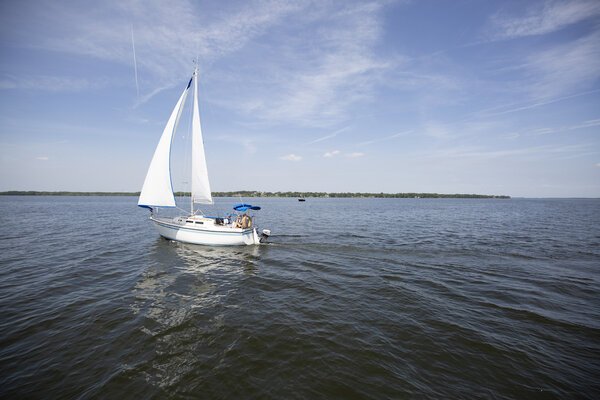
5. Leeward
Also known as lee, leeward is the opposite direction of the wind blowing (windward).
6. Windward
The direction in which the wind is currently blowing. Windward is the opposite of leeward (the opposite direction of the wind). Sailboats tend to move with the wind, making the windward direction an important sailing term to know.
7. Boom
The boom is the horizontal pole extending from the mast’s bottom. The sailboat can harness wind power to move forward or backward. This is done by adjusting the boom towards the direction of the wind.
8. Rudder
Located beneath the boat, the rudder is a flat piece of wood, fiberglass, or metal used to steer the boat. Larger sailboats control the rudder via a wheel, while smaller boats will have a steering mechanism directly aft.
9. Tacking
The opposite of jibing, this basic sailing maneuver refers to turning the boat’s bow through the wind so that the wind changes from one side of the boat to the other. The boom of a boat will constantly shift from one side to the other when performing a tack or a jibe.
10. Jibing
The opposite of tacking, this basic sailing maneuver refers to turning the stern of the boat through the wind so that the wind changes from one side of the boat to the other. The boom of a boat will always shift from one side to the other when performing a tack or a jibe. Jibing is a less common technique than tacking since it involves turning a boat directly into the wind.
Conclusion: Learn Nautical Terms Before Setting Sail!
In conclusion, knowing sailing terms and phrases is an essential skill for anyone who wants to take up sailing as a hobby. It enables sailors to communicate effectively with each other and understand the different parts of the boat and their functions. It also enhances safety and reduces the risk of accidents on the water.
Therefore, whether you are a seasoned sailor or a beginner, learning these sailing terms can enhance your enjoyment of this exciting and rewarding sport!
Editor’s Note: This article was updated in April 2023.
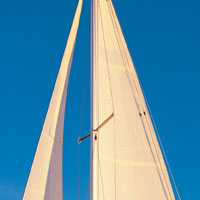
Join Our Newsletter!
Get community news, buying bargains, and how-to guides at your fingertips.
Sailing Basics: 10 Nautical and Sailing Terms to Learn
Sailing offers a unique blend of adventure, relaxation, and skill, but for beginners, the terminology can be a bit daunting. Whether you’re just getting started or looking to brush up on your sailing vocabulary, knowing these key terms will help you feel more confident on the water. In this guide, we’ll cover 10 essential nautical and sailing terms that every new sailor should know, along with some insights into the types of boats and equipment you might encounter, including price ranges and specs for beginner-friendly options.
1. Port and Starboard
One of the most fundamental terms to understand is the difference between port and starboard .
- Port refers to the left side of the boat when you’re facing forward, toward the bow (front).
- Starboard refers to the right side of the boat under the same conditions.
These terms are essential for clear communication, especially in navigation and safety situations. Knowing which side of the boat you’re talking about is crucial when maneuvering, docking, or giving way to other vessels.
Price & Specs
Many starter sailboats, like the Catalina 22 Sport, which is popular among beginner sailors, come equipped with navigational aids that indicate port and starboard with colored lights. A new Catalina 22 Sport can range from $25,000 to $30,000 depending on customization, with a length of 22 feet and a beam (width) of 7.67 feet.
2. Bow and Stern
The bow refers to the front of the boat, while the stern refers to the back. This is another critical term to understand, especially when docking or communicating with crew members.
Entry-level sailboats like the Beneteau First 14 have well-defined bow and stern areas, with sleek designs aimed at enhancing speed and maneuverability. Priced around $10,000 , this 14-foot boat is perfect for those learning the ropes of sailing and offers a stable platform for training.
The boom is the horizontal pole that extends from the bottom of the mast, attached to the foot of the mainsail. The boom is critical in controlling the angle and shape of the sail, allowing you to harness the wind’s power efficiently.
A common beginner mistake is not paying attention to the boom’s movement when tacking or jibing (changing direction). The boom can swing rapidly across the deck, posing a hazard if you’re not aware of its position.
For beginner boats like the Hobie 16, the boom is lightweight and easy to control. This catamaran-style boat starts at around $12,000 , making it an accessible choice for new sailors. It has a length of 16 feet and a beam of 7.92 feet.
4. Mainsail and Jib
A sailboat typically has two main sails: the mainsail and the jib .
- The mainsail is the large sail that is attached to the mast and boom, providing the bulk of the boat’s propulsion.
- The jib is a smaller sail that is positioned forward of the mainsail, attached to the headstay (a cable running from the bow to the top of the mast).
Understanding how to trim (adjust) these sails to maximize wind efficiency is key to sailing effectively.
A sailboat like the Hunter 15 features a well-balanced mainsail and jib system, ideal for beginners learning sail trimming techniques. Priced around $13,000 , the Hunter 15 has a mainsail area of 108 sq. ft. and a jib area of 34 sq. ft., making it manageable for new sailors.
5. Tacking and Jibing
Tacking and jibing are two essential sailing maneuvers used to change the boat’s direction relative to the wind.
- Tacking involves turning the bow through the wind, typically when sailing upwind.
- Jibing is turning the stern through the wind, usually when sailing downwind.
Mastering these turns is crucial for safely navigating different wind conditions.
Learning to tack and jibe is easier on boats like the RS Zest, a compact sailboat priced around $6,000 . With a length of 11.48 feet and a sail area of 71.3 sq. ft., it’s lightweight and designed for training purposes.
The helm is the steering mechanism of the boat, usually a wheel or tiller, depending on the boat’s size. When someone is “at the helm,” they are in charge of steering the boat.
The Laser Performance Bahia, which is perfect for beginner sailors, features a simple tiller-based helm system. This 15-foot boat costs around $12,000 and offers a stable ride, allowing newcomers to focus on steering without worrying about complex controls.
The keel is the structure at the bottom of the boat that provides stability by lowering the boat’s center of gravity and preventing it from tipping over. It also helps the boat sail efficiently by cutting through the water.
Boats like the Catalina 275 Sport feature a fixed keel, providing extra stability for new sailors. Priced around $85,000 , this 27-foot boat is designed for easy handling, with a keel that offers stability in various wind conditions.
8. Sheet and Halyard
The sheet is the rope used to control the angle of the sails, while the halyard is the rope used to hoist or lower sails.
- The mainsheet controls the mainsail.
- The jib sheet controls the jib sail.
- The halyard raises the sail up the mast.
Learning how to adjust the sheets and halyards properly allows you to control the sail shape and boat speed.
Sailboats like the Sunfish come with simple sheet and halyard setups, making it ideal for beginners. With a price tag of $4,500 to $6,000 , it’s one of the most affordable starter sailboats, offering a straightforward rigging system.
9. Windward and Leeward
- Windward refers to the side of the boat facing the wind.
- Leeward is the side sheltered from the wind.
Understanding these terms is crucial when adjusting your sails or when navigating in close proximity to other boats, as it helps you determine the wind’s impact on your vessel.
The RS Quest, priced around $10,000 , is designed with wind awareness in mind. With a length of 14 feet and a sail area of 130 sq. ft., this boat is easy to handle, helping beginners get a feel for windward and leeward sailing.
A cleat is a metal or plastic fitting on a boat used to secure ropes. Cleats are essential for tying off the sails, docking, or anchoring. Knowing how to properly tie knots around cleats is a basic sailing skill.
Most beginner-friendly sailboats, such as the Precision 165, come with multiple cleats for securing lines. This model, priced around $18,000 , is designed with user-friendly cleats for easy line management, helping new sailors get comfortable with the process.
Learning the basic nautical and sailing terms is an important step in becoming a confident sailor. As you become more familiar with the terminology, you’ll gain a better understanding of how your boat interacts with the wind and water, making your time on the water safer and more enjoyable. Whether you’re practicing on a compact boat like the Sunfish or progressing to larger models like the Catalina 275 Sport, knowing these terms will help you sail with skill and confidence.
Happy Boating!
Share Sailing Basics: 10 Nautical and Sailing Terms to Learn with your friends and leave a comment below with your thoughts.
Read Four Reasons to Sign Up for Boating Lessons (And Where to Find Them) until we meet in the next article.
Similar Posts
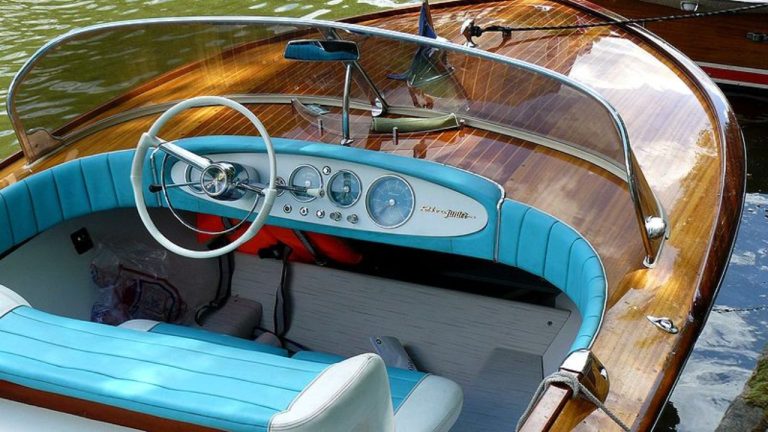
10 Custom Boat Upholstery Ideas to Increase Look
Boating enthusiasts know that comfort and style go hand in hand when it comes to enjoying life on the water. Your boat’s upholstery plays a pivotal role in transforming your vessel into a comfortable and visually appealing haven. Whether you’re cruising, fishing, or simply soaking up the sun, custom boat upholstery can elevate your experience…

Boat Sales in Australia: Setting Sail on Savings Guide
Australia’s vast coastline beckons with promises of adventure, relaxation, and stunning scenery. What better way to experience it all than from the comfort of your own boat? But before you set off on your aquatic odyssey, navigating the world of boat sales in Australia requires some careful planning. This guide will equip you with the…

Why Do Boats Porpoise: Causes and Solutions Guide
Boating enthusiasts are often familiar with the phenomenon known as “porpoising,” which can significantly impact the performance and comfort of a boat while underway. Porpoising refers to the bouncing or oscillating motion of a boat’s bow, resembling the playful leaps of a porpoise in the water. Understanding the causes and solutions for porpoising is crucial…
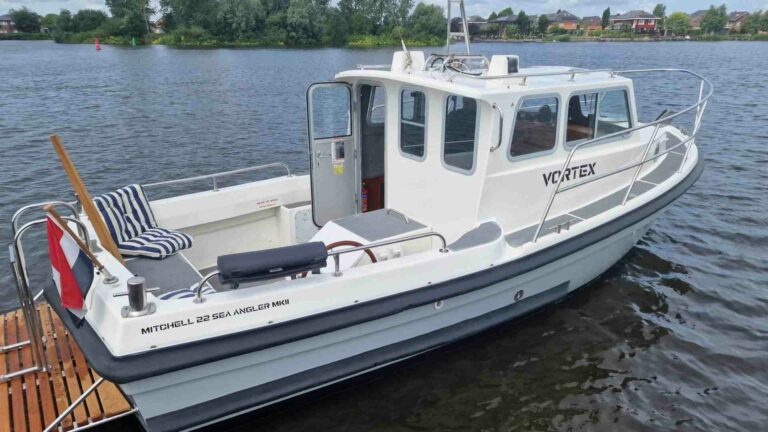
Unveiling the Legacy: A Look at Mitchell Boats
For boat enthusiasts, particularly those drawn to classic wooden vessels, Mitchell Boats hold a special place in nautical history. This blog post delves into the heritage of Mitchell Boats, exploring their rise to prominence, design philosophy, and the enduring legacy they left behind. A Storied Past: The Birth of Mitchell Boats Founded in 1940 by…

The Ins and Outs of V-Drive Transmissions: A Extensive Guide
V-drive transmissions play a crucial role in marine propulsion systems, offering numerous benefits and applications in a variety of watercraft. Understanding the inner workings and advantages of V-drive transmissions is essential for boating enthusiasts and professionals alike. This article delves into the world of V-drive transmissions, exploring their significance and explaining why they are favored…

Setting Sail on Paper: A Beginner’s Guide to Boat Drawing
The image of a majestic boat gliding across a calm sea or a playful sailboat dancing on waves has captured imaginations for centuries. But before these vessels take to real water, they often come to life on the artist’s canvas or sketchbook page. This blog post is your guide to boat drawing, offering step-by-step instructions,…
The Only 50 Sailing Terms You'll Need To Know (With Pictures)
Ever get confused by all those odd sailing terms? Starboard, tack, jib… Well, no worries. In this article, I'll go over the most important sailing terms for beginners.
This is a great resource for beginning sailors that need an overview of the most important sailing terms without drowning in it . For a comprehensive list, check out this Wikipedia glossary of nautical terms . There are A LOT of nautical terms there. But no one in his or her right mind will read through that entire page (it has 48.434 words!). There are a lot of obscure words listed that no one really uses anyways. So in this article, I've filtered out the most important ones to get you up to speed quickly. I've also added pictures so you'll know what we're talking about.
Let's jump straight in. For the sake of good manners, I have categorized them by topic. If you are looking for a specific term, just ctrl+f your way directly to it.
Here are the only 50 sailing terms you'll need to know:
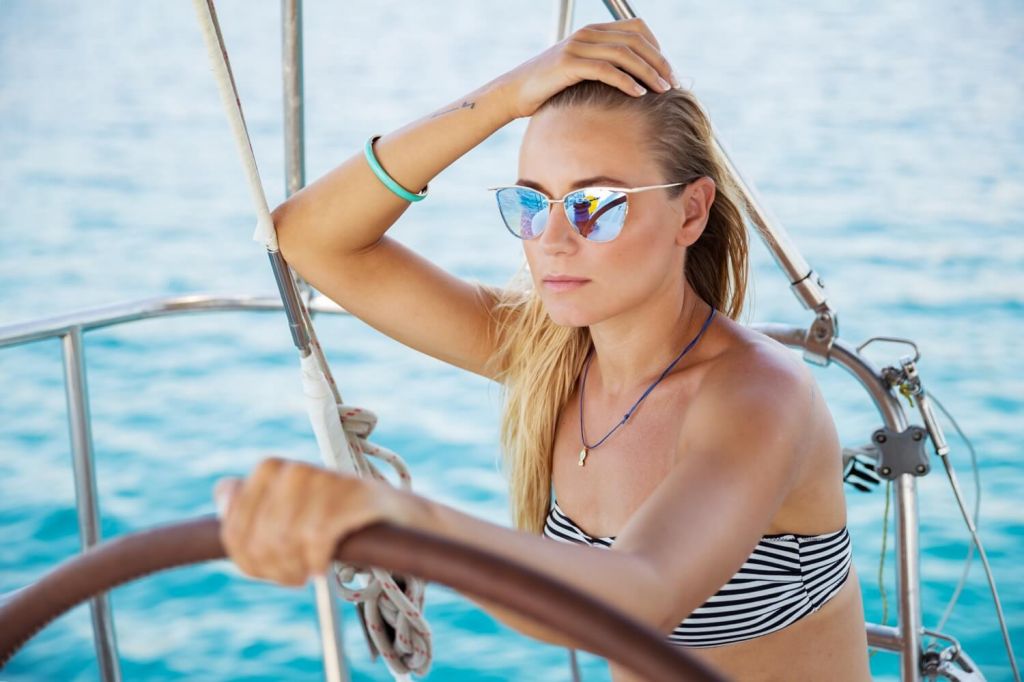
Orientation
Parts of the boat, parts related to sails, other terms.
...because it isn't as easy as 'left', 'right', 'front' and 'back'. No, no.
Port is the left side of the boat. It's as simple as that. I'm not entirely sure why don't they just call it 'left' these days. The name came to existence because centuries ago, you always docked your big boat with the harbor (port) being on the left side. And the word stuck with us till today.

Starboard is the right side of the boat. If in a car, you say 'look to your right', on a boat, you say 'look to the starboard'. Again, you might as well just call it 'right'. Oh, wait… you wouldn't seem as cool if you did. Alright, let's keep calling it starboard.
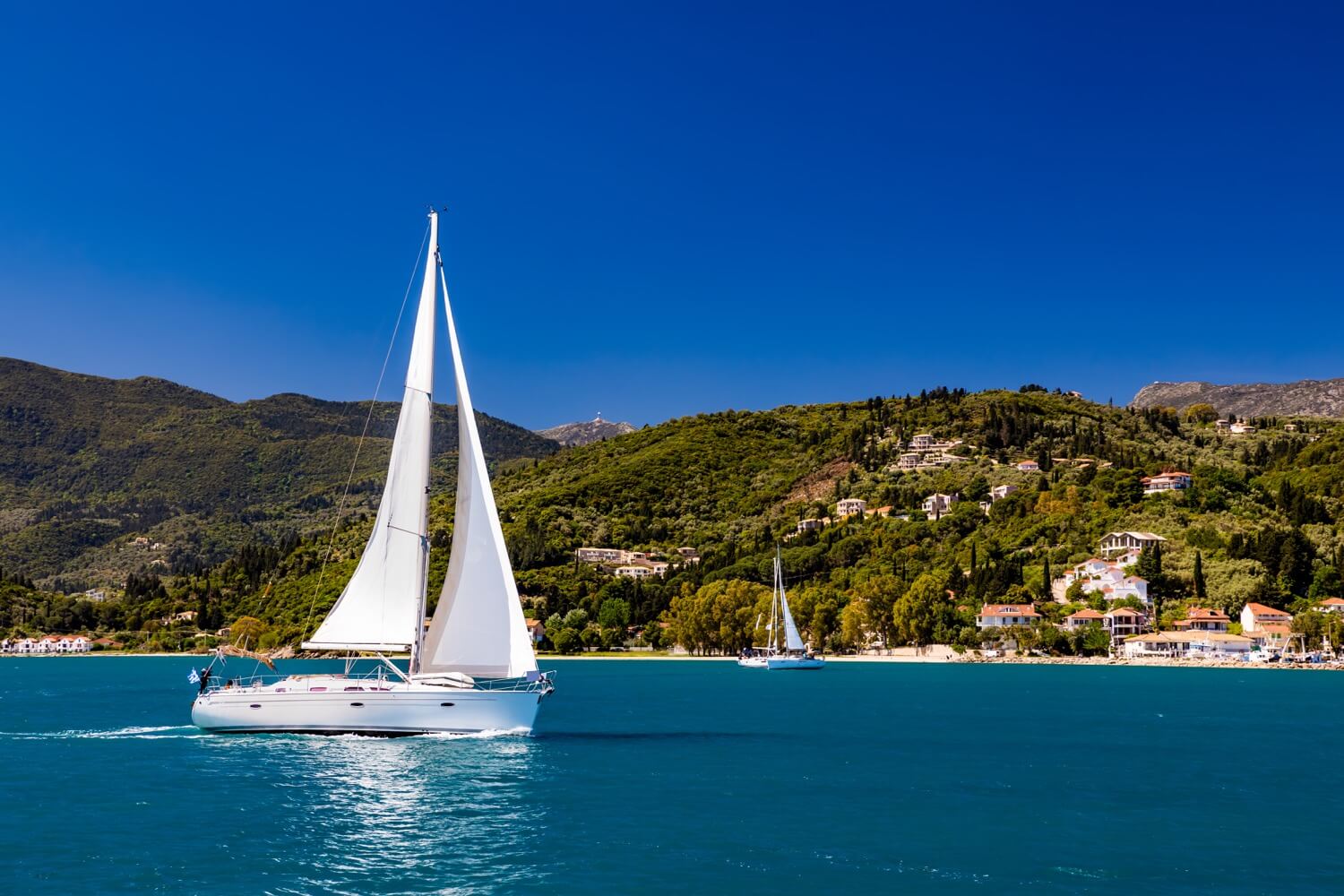
The bow is the front of the boat. The word likely comes from the Middle Dutch 'boech' (nowadays spelled 'boeg'). If you call it 'front' instead, you will get your message across just as well. But it won't get you the admiring looks from those around you.

Stern is the back of the boat. That is where you, as a captain, will spend most of your time. Whether you will force your crew to call it 'stern' or let them use the word 'back', like the dry land creatures they are, is up to you. After all, you are the captain.

The windward side of the boat is the side facing into the wind. So if the wind is coming from the right side, the windward side is on the right. Unlike some of the previous ones, this term actually makes sense - at times you need to talk about a direction not fixed in relation to the boat, but rather relative to the direction of the wind.
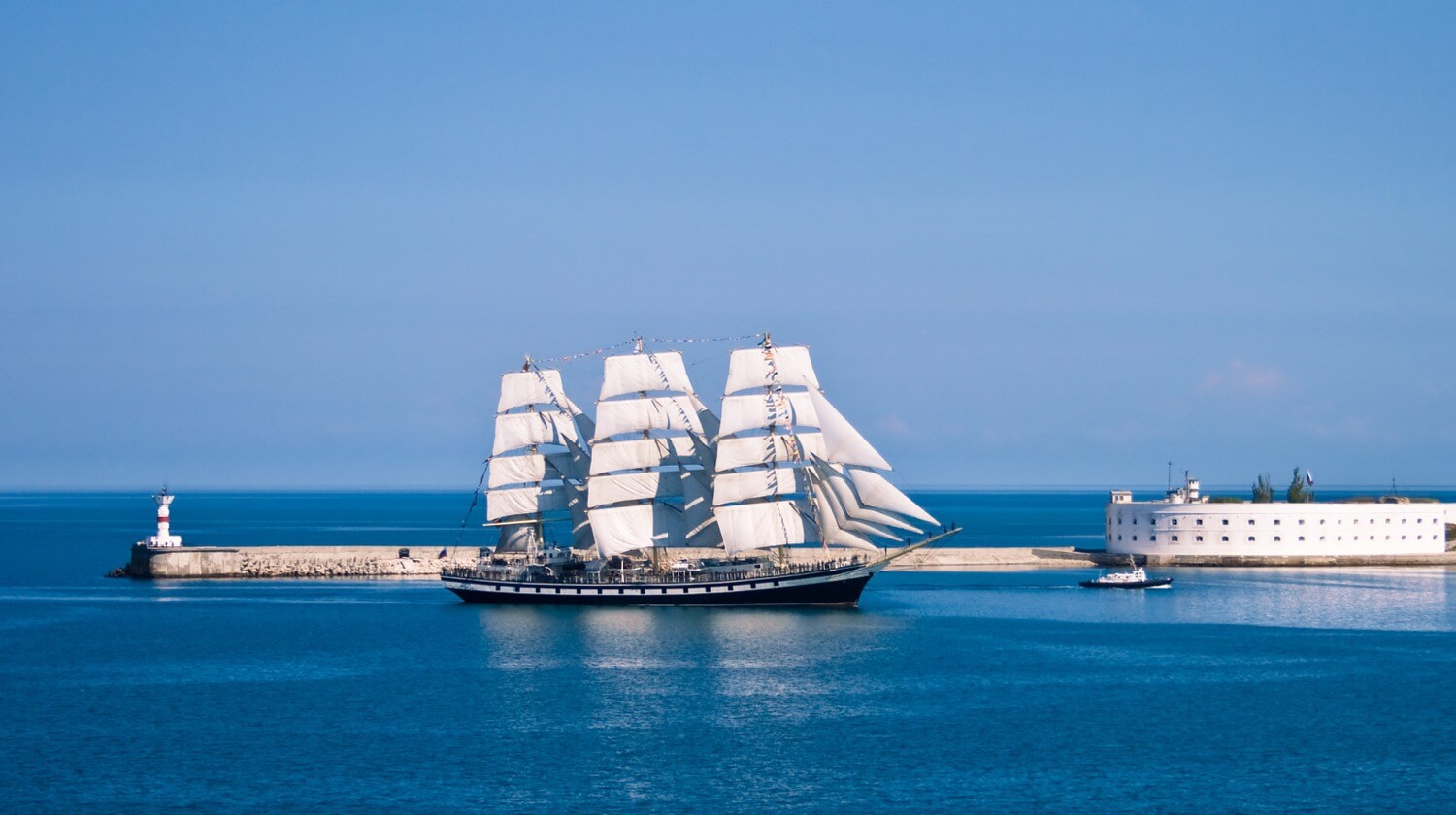
Leeward side of the boat is the lee side. If the wind is coming from the right side, the leeward side is on the left. Note that neither windward nor leeward specify the angle of the wind. Thus even if the wind was coming 20 degrees right off of the direction of the boat, so almost from the front, left would still be considered the leeward side.
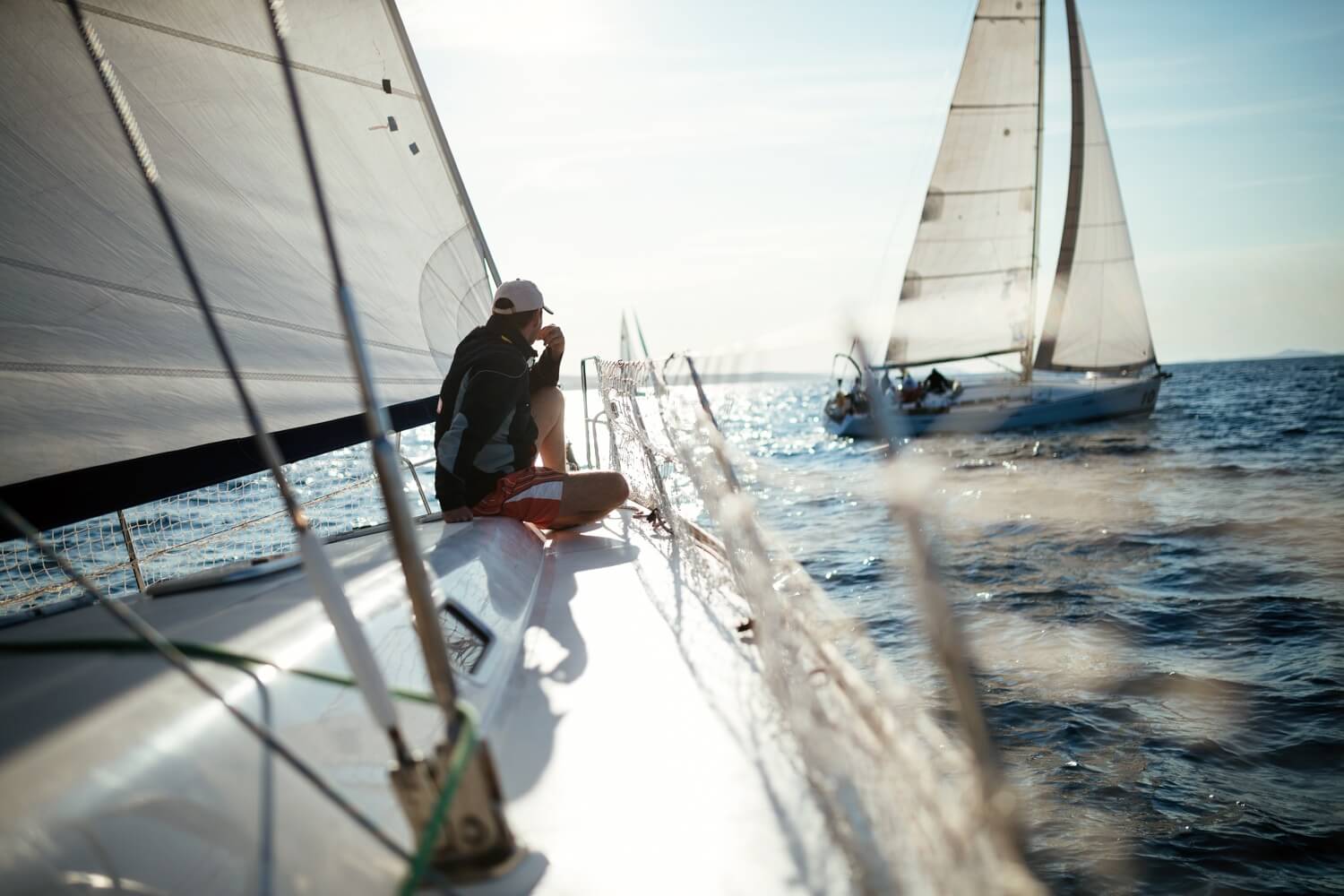
Since there are gadgets and parts on the boat that you won't see anywhere else, it only makes sense they all have their own special name. You want to know these because unlike the direction terms where you can do with 'left' and 'right', you don't want to call a tiller 'that stick thing back there'.
Helm is the boat's steering wheel. In this case, I forgive those who came up with this name, since it is shorter than 'steering wheel' and thus saves valuable time that we can spend on sailing. Though I doubt linguistic economy was the reason.

Tiller is the long stick that operates your boat's rudder. A steering stick, if you will. It has the same function as a helm does, but it is usually used on smaller boats, where a helm would take up too much space. Or by people who prefer it to a helm, since a tiller offers a bit more in terms of response.
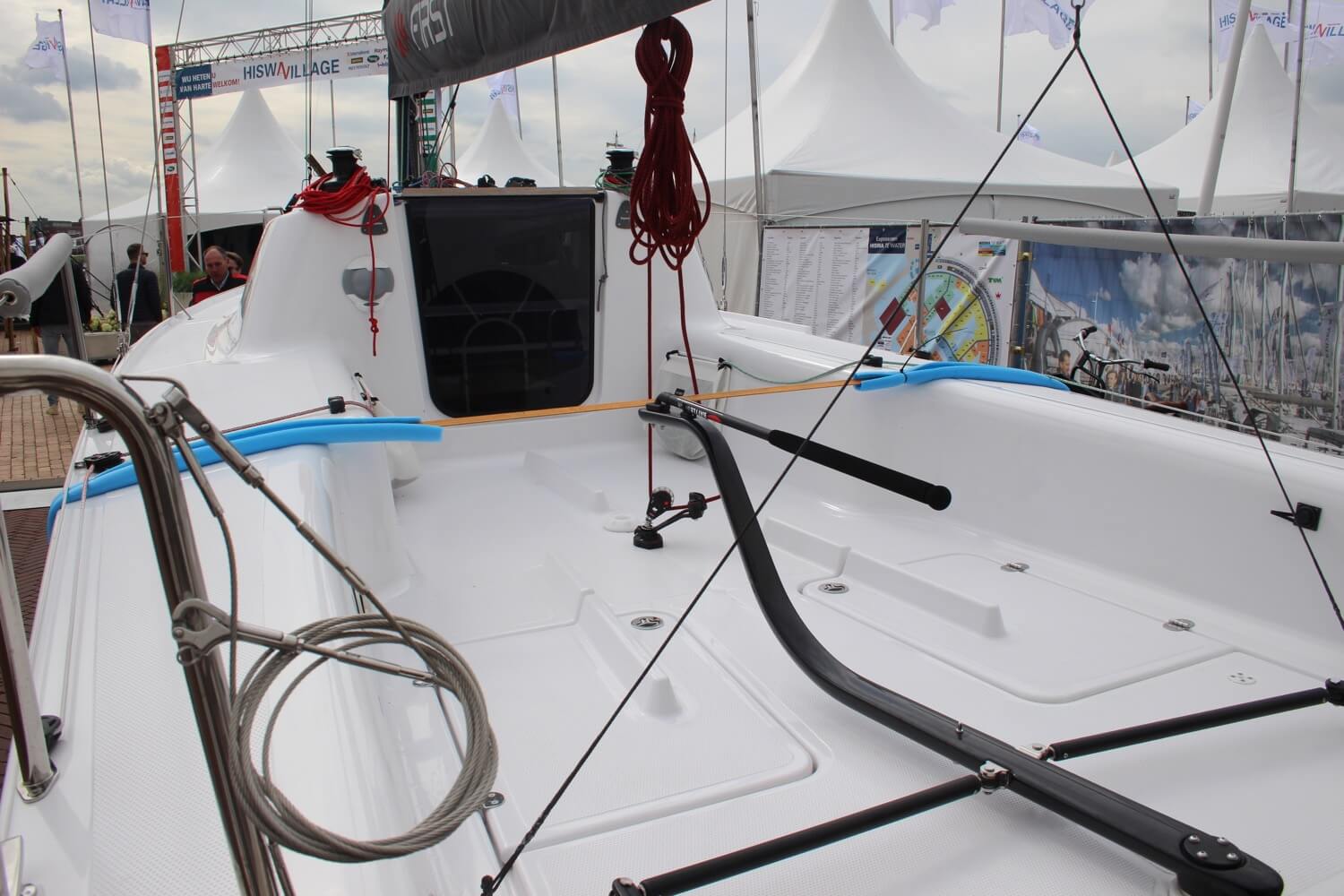
The rudder is the long, flat piece of metal or wood that sits underwater below the back of your boat. Connected to a tiller or a helm, it is used to control the direction of your exciting voyage. By the way, since aerodynamics and hydrodynamics work in similar ways, a plane is also operated by a rudder. Though that one isn't underwater. Hopefully.

Hull is the boat's body. Whatever the shape or size, whether opened on top (like a dinghy) or closed by a deck, (like a traditional sailboat) it's all called a hull. Structures sitting on top of the deck, like a deck salon or cabins, aren't considered a part of the hull anymore.

The keel is an underwater fin below the boat's belly. The sizes and shapes vary, sometimes it is relatively short and goes deep, (fin keel) sometimes it runs from the front all the way to the back (full keel or ballast keel). It is there mainly for stability and to help maintain forward direction when sailing.
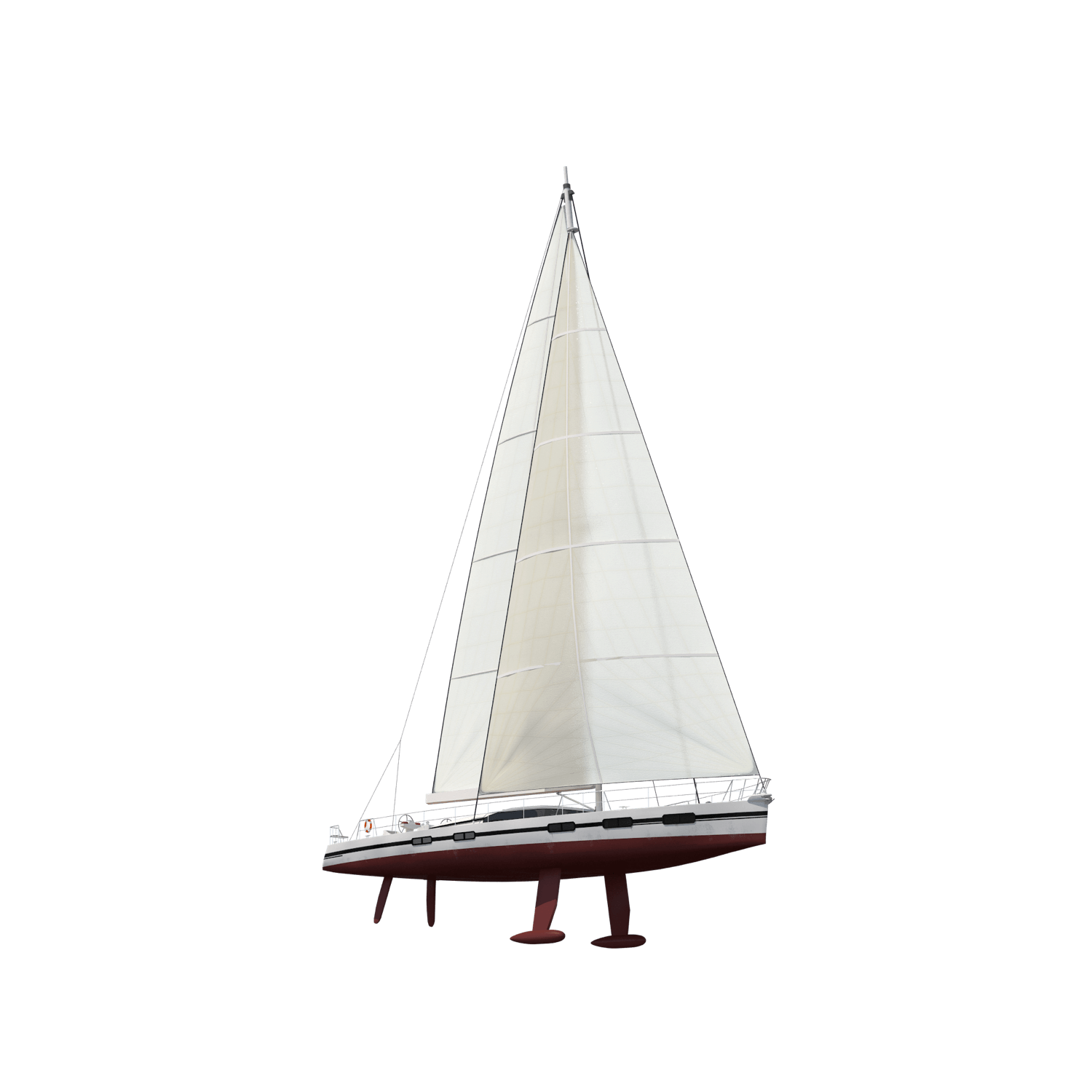
The cockpit is the area where a boat is operated from. On sailboats, it is usually in the back and it is an open area without a roof, though this varies. You will find the rudder control and winches there. In 'smaller' (below 70 ft or so) sailboats this area oftentimes doubles as a deck dining place with a table and seating.

The bimini is a sun roof or shade that is covers the cockpit, and is generally attached to a steel frame which runs over the cockpit.
This is where things tend to get confusing. There are a whole lot of parts and a whole lot of names for them. It pays off for you and your crew to know them though, as during the stormier moments, you all want to be on the same boat (ha, ha) linguistically, as every second counts.
Lines are ropes. Not much more to add here. I suppose a 'line' sounds a bit fancier than a 'rope'. One thing this article will teach you is that if there is the slightest crack in the wall of your boat, linguistic elitism will leak its way in.

This one is quite self-explanatory. The mainsail is the main, largest sail of the boat, attached to the mast on the side and the boom at the bottom. It has a triangular shape and serves as the most important sail, the first one you should get acquainted with if you are just starting out.
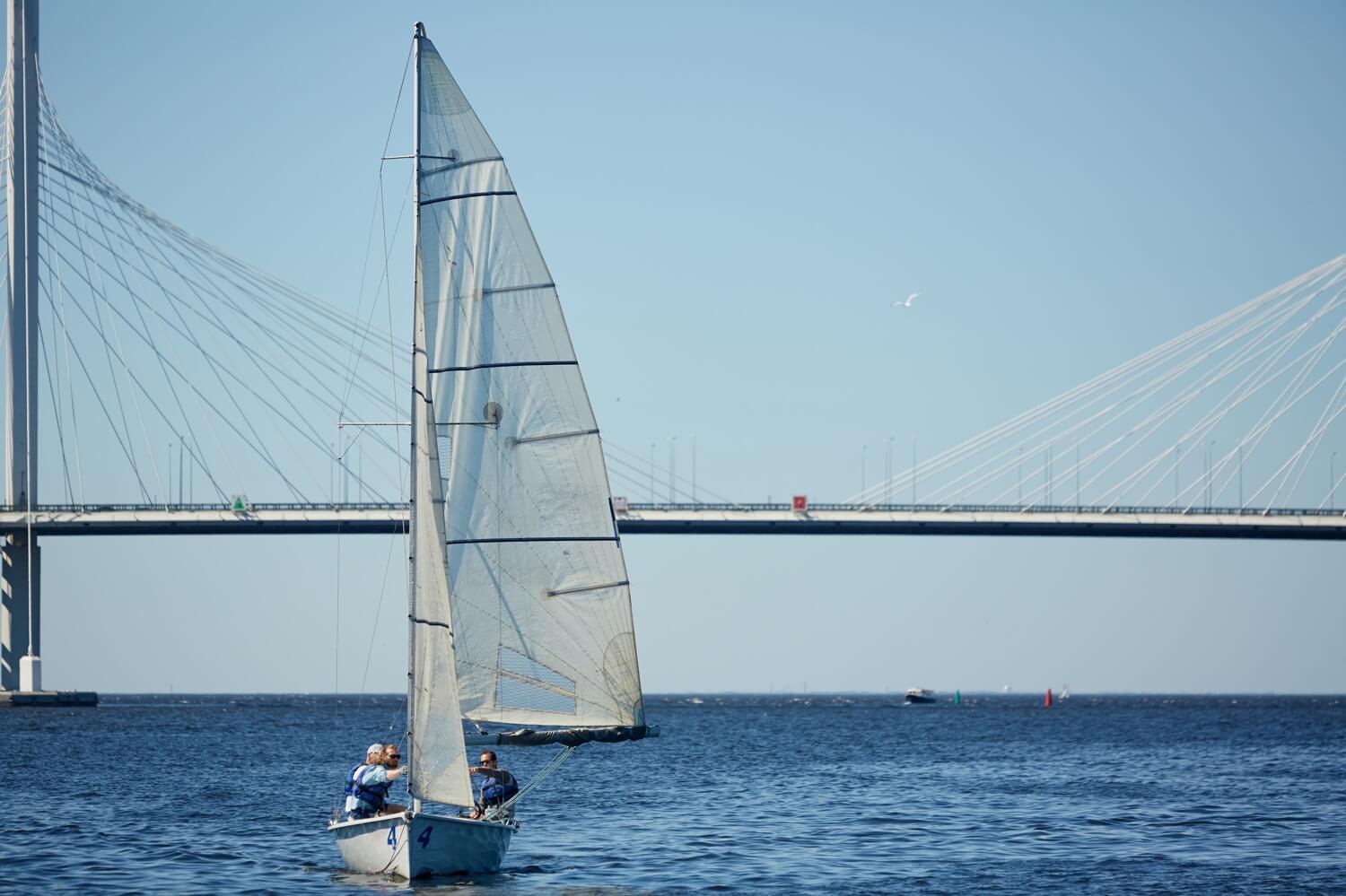
The jib is the front sail of your boat, sometimes also called the genoa. That is as long as you are sailing on the traditional sloop - the classical two sail setup you see the most often. The jib is wrapped around the line that goes from the top of your mast to the boat's bow.

Spinnaker is the third type of sail you are the most likely to encounter on your travels. It goes in front of your boat and has a half balloon or kite-like shape. This is because it is constructed specifically for sailing downwind. Its purpose is to grab as much backwind as it can and drag your boat forward. It is not attached to the boat most of the time like the mainsail or the jib, instead, it is stored separately and used only when needed.

The mast is the tall, vertical pole that goes from the floor of your salon, through the deck, meters above your boat. All the sails are attached to it, also radars and lights, giving sailboats radio and visual visibility far greater than that of equally sized motorboats. Take that, ya noisy stinkies!

The boom is the horizontal pole right above the deck, attached to the mast at the right angle. The bottom of the mainsail is attached to it, it is used to determine its shape and direction. It is also where the mainsail is often stored, folded and covered with a protective sheet. The boom is also among the top causes of injuries on a sailboat, as in certain winds it tends to swing with force powerful enough to knock a few grown men overboard. Stay away from its reach at all times when under sail.

The forestay is the cable going from the top of the mast to the very front of the bow. It is there to hold the mast in place. Sometimes you will find people refer to it as the 'headstay'. It is often made of steel, so it is safe to hold on to it when you are pretending to be Jack on the bow of the Titanic's, the boat hits a wave and you lose your balance.

This diagram is from our guide on sailboat parts , which I really recommend for beginners. It walks you through all the most important sailboat parts in normal words.
The backstay is the cable going from the top of the mast to the very back of the boat. In many cases it is doubled at the bottom, each end attached to one corner of the back of the boat so that they don't interfere with space and provide more stability for the mast. Just as with forestay, these are made of steel.
Shrouds are the cables going from the top of the mast to the left and right side of the boat. Sometimes there are four, two on each side. Together with forestay and backstay, they make sure your mast withstands all the forces exerted on it when the wind pushes the sails.
The foot of a sail is its bottom edge. If you imagine a sail as a triangle, the base is called the foot. You probably won't use this term while sailing, but when researching proper sail trim, it is likely you will stumble upon it.
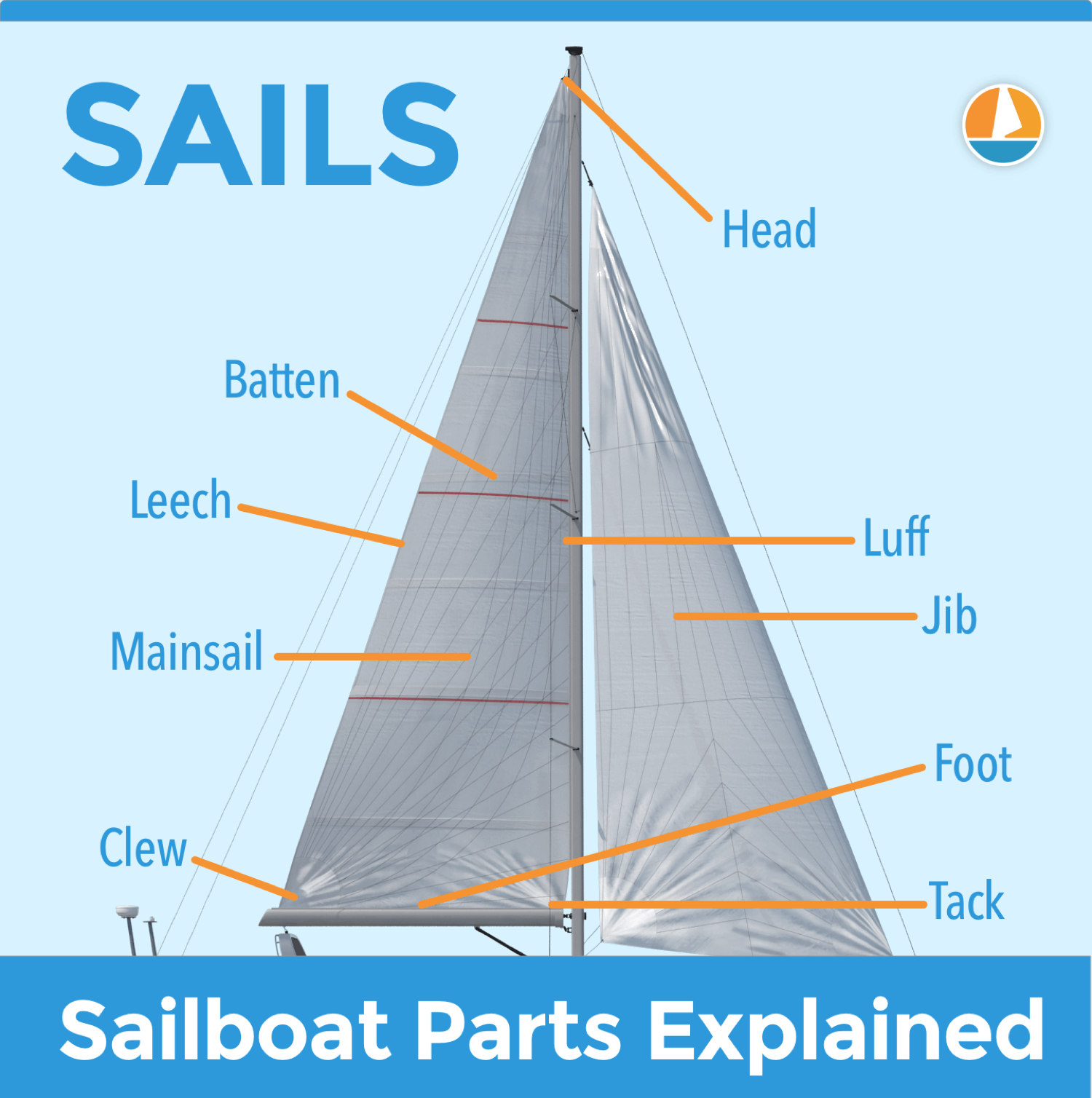
This diagram is again from our guide on sailboat parts , which I really recommend for beginners. If you're looking for a good starting point to learn your sailboat ins and outs, this article is perfect for you.
Leech of a sail is its back side edge. Thus it is the part closest to you when you are standing at the helm. Just as with the foot, this is a term quite often used when describing sail trimming techniques, since the shape of the leech determines the shape of the whole sail.
Luff of a sail is its front side edge. Thus the part the furthest from you when you are standing at the helm. For mainsail, it is the edge that is right next to the mast, for the foresail it is the edge right next to the forestay. Just as with foot and leech, the shape of these edges determines the overall shape of the sail so you will most likely encounter these terms in trimming lessons and tutorials.
The head of a sail is its top corner. On a traditional sloop, you will have the 'main head' and the 'jib head'. There is usually a reinforcing patch of some kind on these corners, as you will find a hole in them to which a line is attached.
It's also something else entirely, but more on that later ...
Halyard is the line attached to the sail head. On your boat, you will most likely have two. The 'main halyard' which is what you use to hoist your mainsail if it is folded on the boom, and the 'jib halyard' which holds the jib head up.
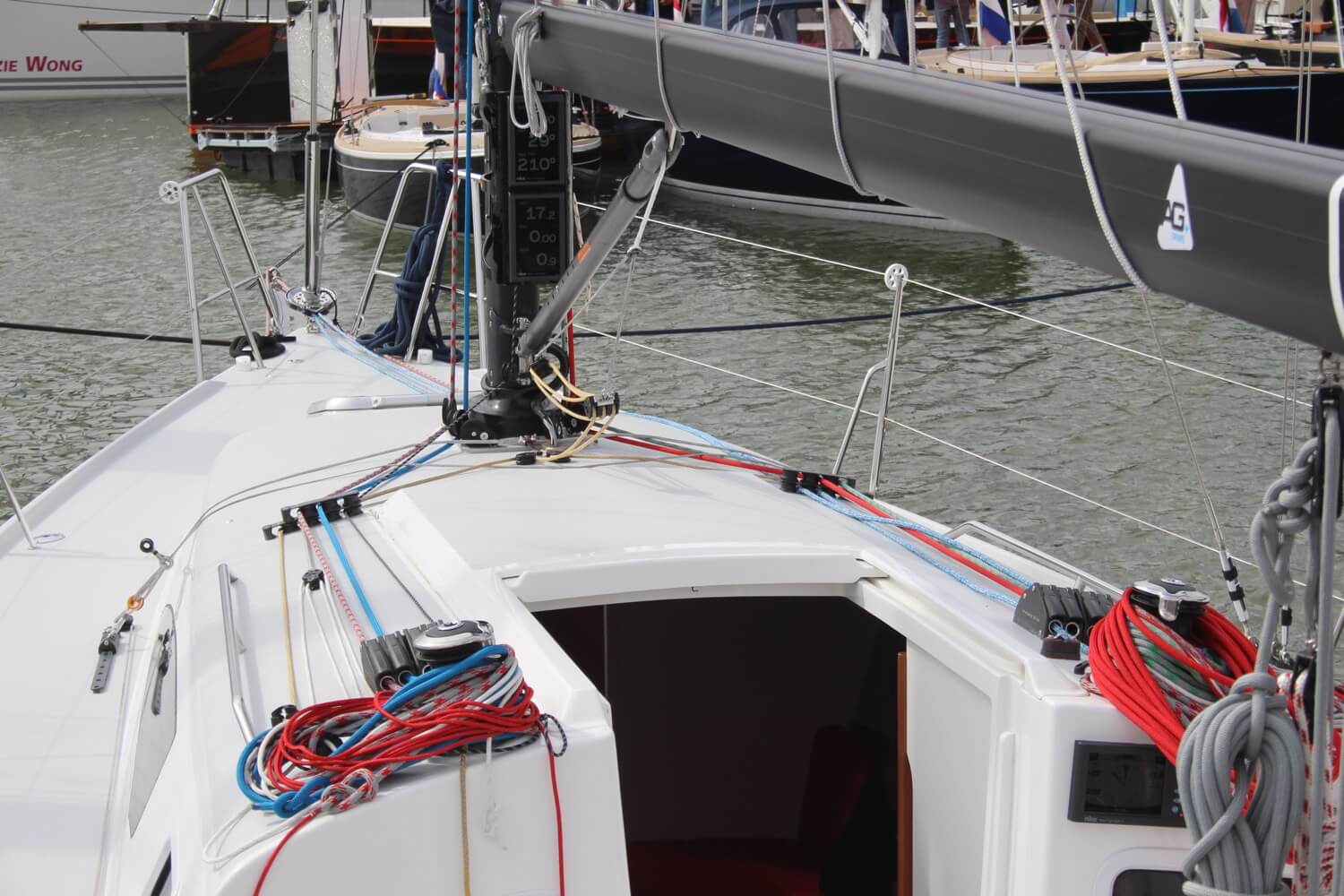
Clew of a sail is its back corner. The line attached to the 'main clew' will be used to hoist your mainsail if it is wrapped inside of the mast. The line attached to the 'jib clew' will be used to open the jib on most sailboats since jibs are most often wrapped around the luff.
Telltales are light, usually cotton or wool pieces of ropes attached to a sail, showing you the airflow around it. These are important because they help you determine if your trim is effective or not. Because of the material they are made of, you might sometimes encounter them being called 'woolies'.
Vang, or a 'boom vang' is a device pulling the boom down. This is important because it controls the tension of the mainsail, influencing its shape greatly. You won't find it on every boat though. Holiday cruisers often don't have it, as it is a piece of equipment focused on performance and thus not necessary for your average trip.
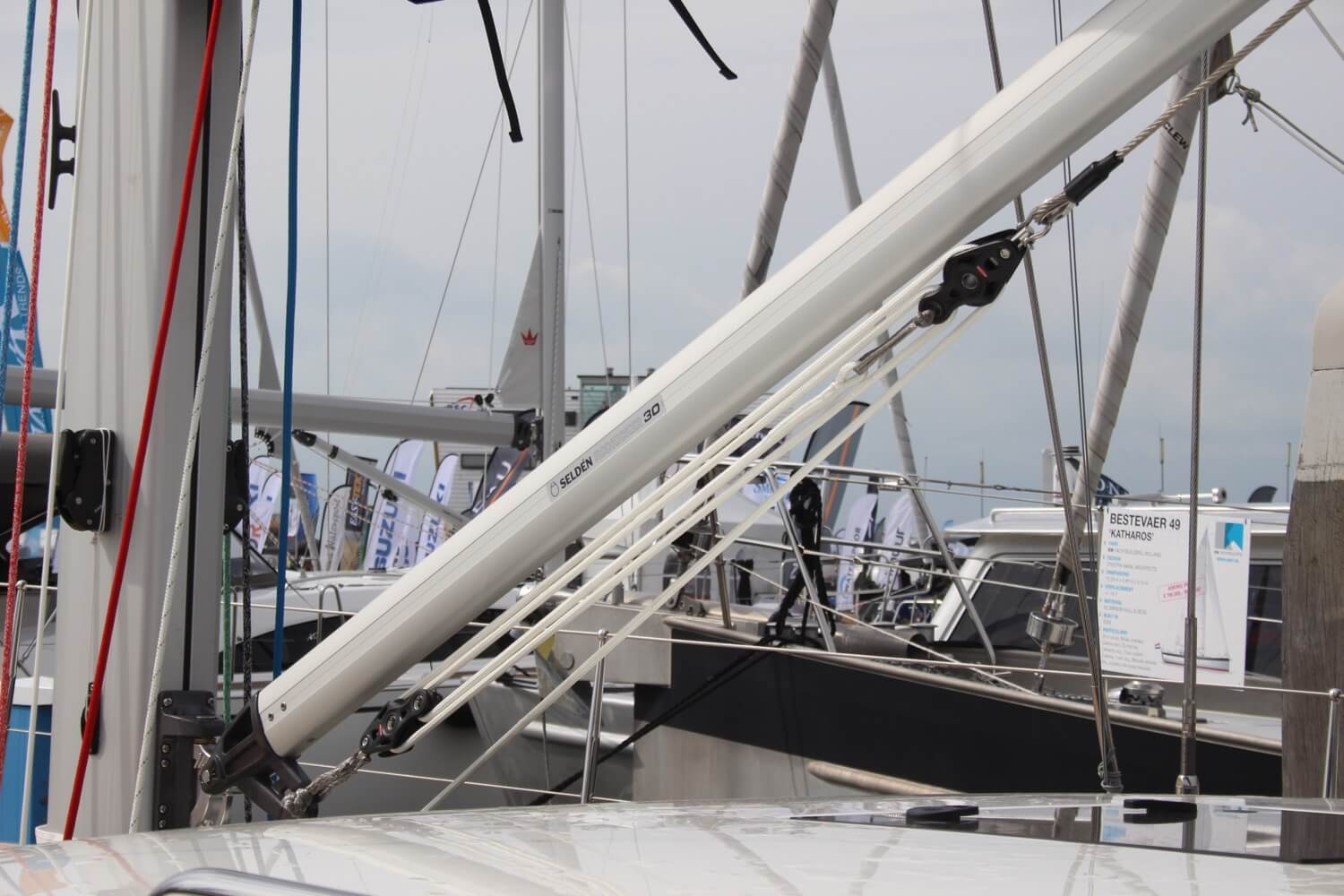
Topping Lift
The topping lift is a line that is attached to the aft (back) end of the boom and runs to the top of the mast. It supports the boom whenever you take down the mainsail.
Also referred to as a 'horse', the traveler is a side to side track to which the boom is attached, allowing the control of the extent to which the boom goes off the centerline. This is important especially if the wind is blowing from behind and you need to control the angle of the mainsheet.

Outhaul is the line attached to the mainsail or the jib clew, allowing the control of the foot tension. This is important for determining the sail shape - for instance in stronger winds, you want the foot to be more tense to achieve a more effective airflow as opposed to slower winds where you can allow the foot to arch more.
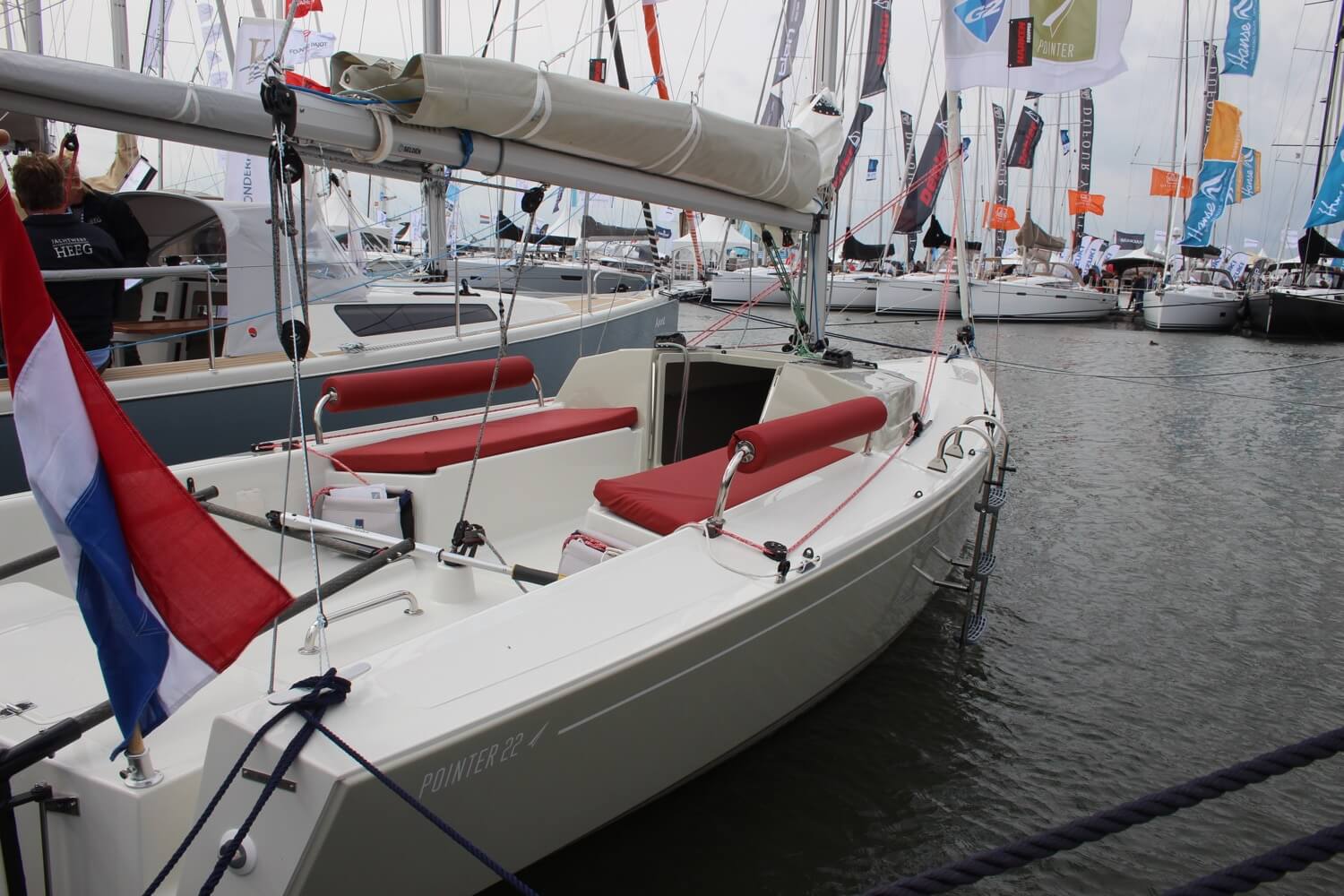
Reefing is reducing the sail area to lessen the power exerted on it by the wind. You may want to reef if the wind is getting too strong for your boat, or if it is changing too rapidly, as an overpowered boat is difficult to control. Fun fact: they say that when you feel you need to reef because the wind got too strong, it is already too late to reef.
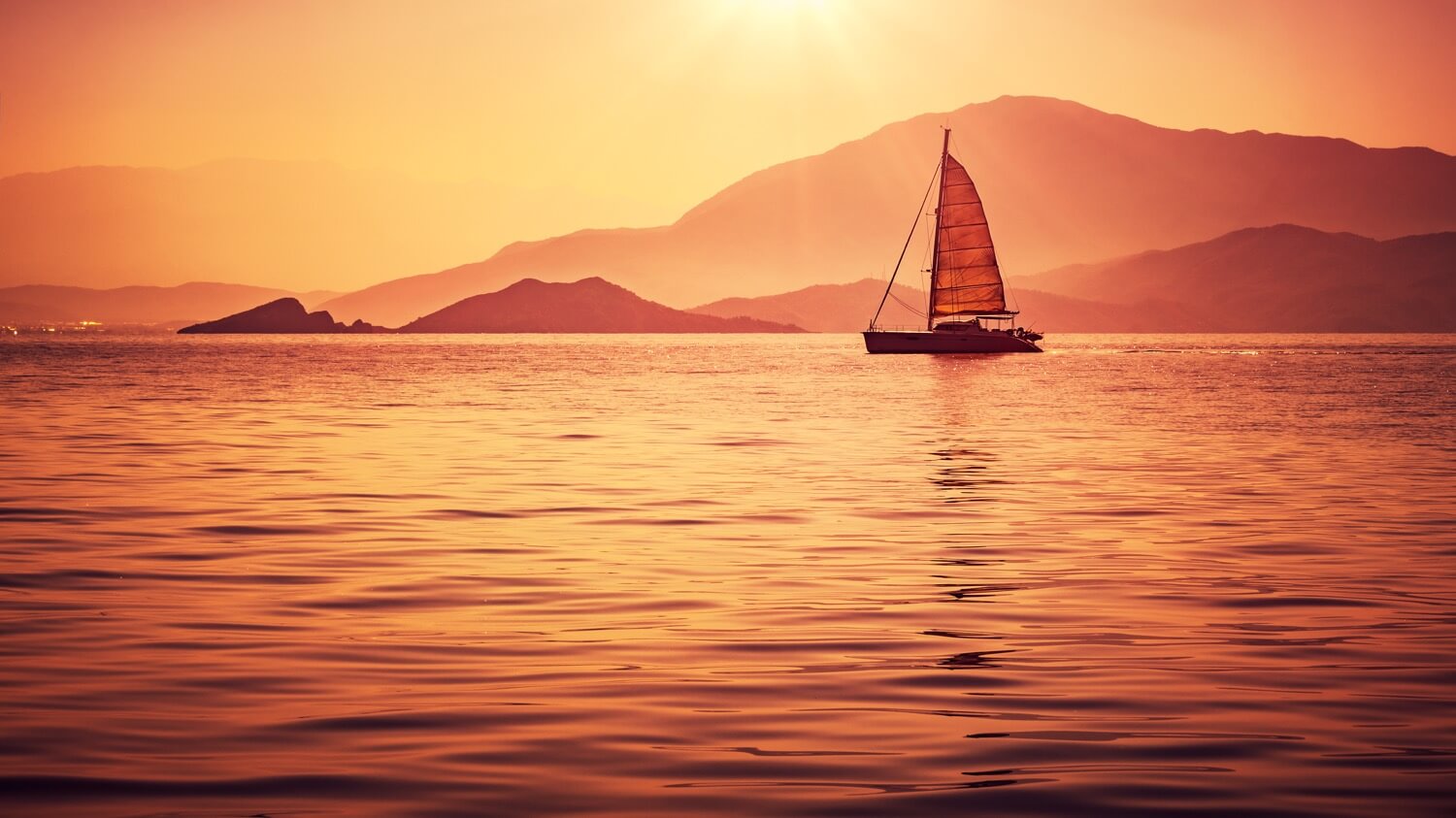
A batten is a slat placed horizontally in the body of the sail to support its shape. You will not find them on all sailboats, it is a performance-enhancing element that many cruisers lack. It helps tremendously as without it, sails tend to belly out and lose their shape under certain conditions.
The cleat is a piece of fitting where a line can be secured and immobilized, even if under great tension. It usually consists of two cogwheel-like pieces fastened close to each other, in the middle of which the rope is placed, unable to move thanks to friction. This type is great as it allows for a quick release. Sometimes though, it is a simple piece of metal or plastic where the rope is tied.
...and then there are all those things that just float around you when sailing, those little things that are the reason for you having to carry a dictionary in your pocket.
Fenders are bumpers allowing some contact with other boats or piers while docked, without scraping the paint. They are often balloon-shaped, made of rubber or some relatively soft material. They are usually attached to the boat's railing and you move them around as you need.

The beam is the width of the boat. Could be just called width, I know. The word comes from the fact that there are transverse reinforcing beams in the boat hull and deck. Next time you are choosing your charter boat for holidays, you will know what this attribute means.
True wind is the actual direction and speed of the wind. This is different than the apparent wind, which is wind direction and speed relative to the boat. Apparent wind is a combination of the true wind and the headwind, which is the wind the boat experiences solely by being in motion.
The berth is a sleeping space on a boat. Thus if a boat has eight berths, it means eight people can comfortably sleep on it. Note that this often includes the salon couches, so a berth is not necessarily a space in an actual bed for one person.
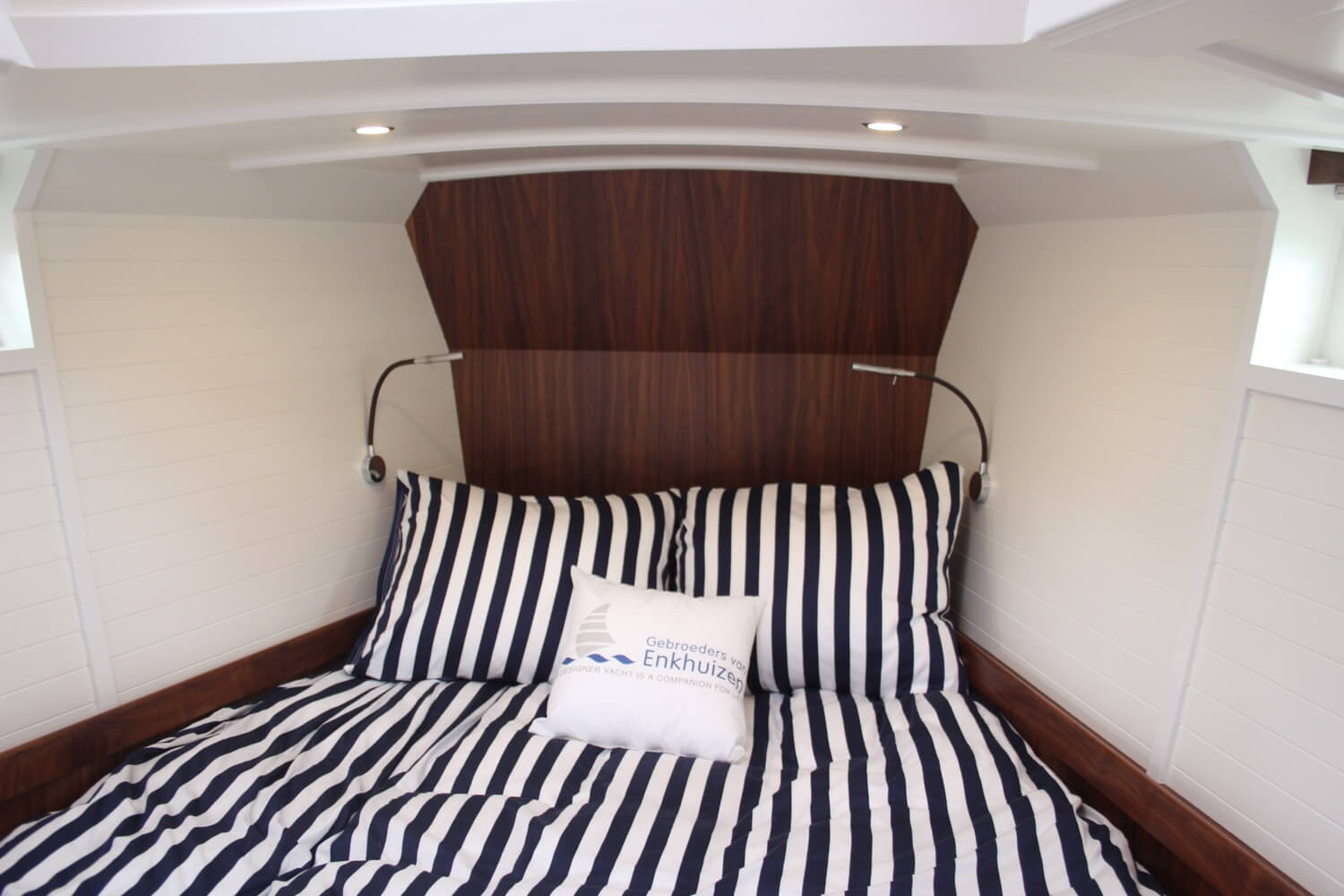
Boat's draft is the distance from the water surface to the deepest point of the boat. In other words, the draft is the minimum water depth you can go to and not scrape your hull or keel. Better double this number when sailing, just to be safe, as hitting the seabed can have disastrous consequences.
Tacking is zig-zagging towards your destination. It is necessary in case your destination is in the direction of the wind since sailboats can not go directly into it. Since the closest to the wind direction you can sail is around 45 degrees, you have to change direction left and right from your desired course.
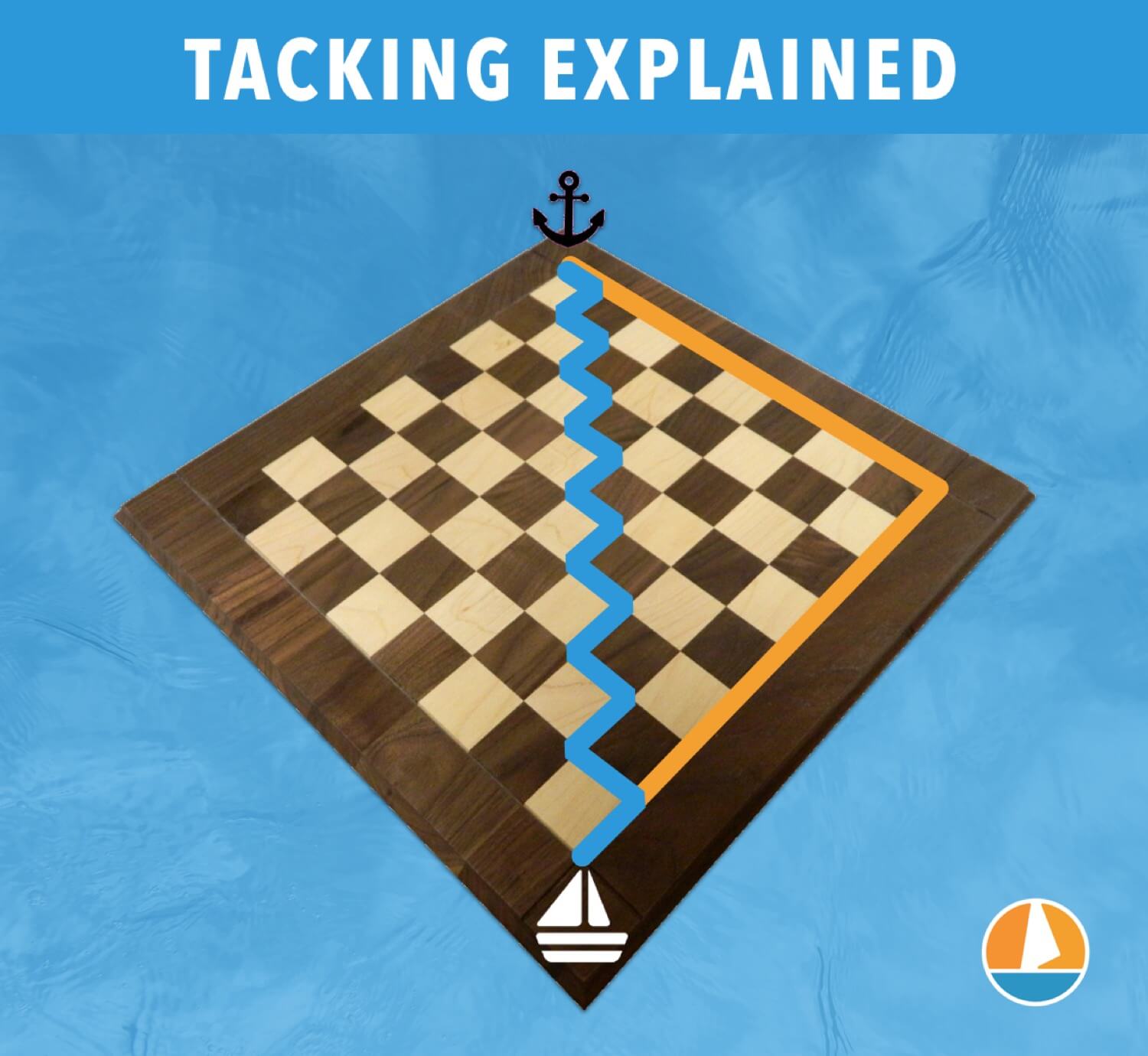
This diagram is from our guide on sailing into the wind for beginners , which explains in 7 simple steps how to get good upwind sailing performance.
Bareboat is a boat without a skipper. You will encounter this term in boat charters and it means you rent the boat without any crew, thus you need to operate it yourself. It is the best way to sail unless you enjoy living in close proximity to a sea wolf who you also have to feed.
The chart is a nautical map. It differs from classical maps as it depicts information relevant for a sailor - water depth, navigational hazards, seabed material, anchorages and so on. Formerly made of paper, these days made of ones and zeros. As is everything in this digital world.
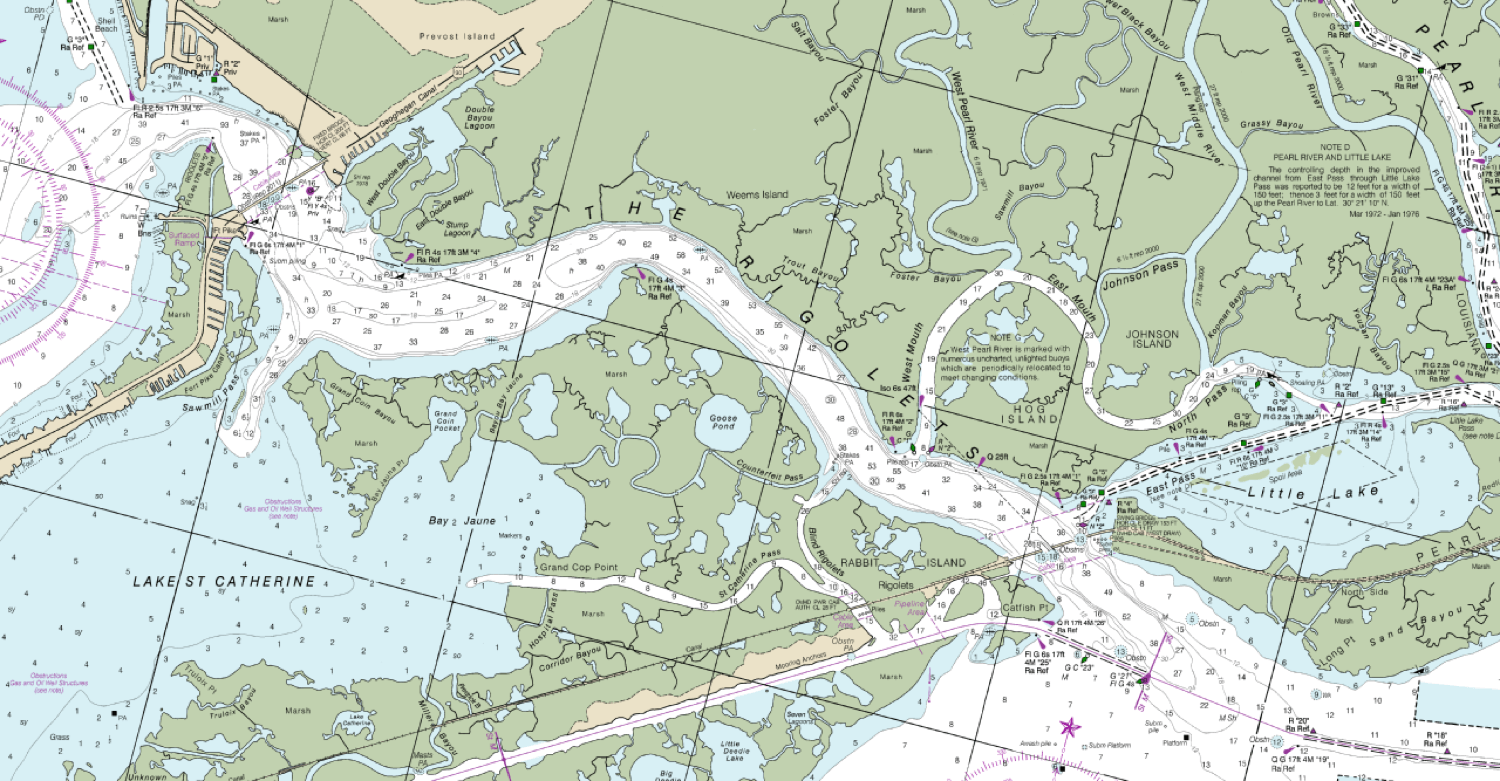
We have a guide that explains all the different chart types clearly for beginners - read it here .
Galley on a boat is its kitchen. Also a medieval warship, but if you find this term in a boat's description, war is not likely what they have in mind.

Heads on a boat is the bathroom. Though in all my years of sailing I have never ever heard anybody use this term instead of a 'bathroom'. I suppose saying that you are going to use the heads just sounds odd.

A knot is the unit of speed of boats. It is equal to one nautical mile per hour. That is 1.852 kilometers per hour or 1.5078 miles per hour. Though a bit confusing and annoying at times, you will have to get used to this, since most of your boat's instruments will use this unit. It dates all the way back to the seventeenth century when boat's speed was measured with a rope with knots tied on it.

Mooring is attaching the boat to a buoy that is anchored to the seabed. This is usually a cheaper option to docking in a marina. It also means larger space between the boats anchored in the same area, thus more privacy. Though you will have to use your dinghy to get to shore instead of just stepping on the pier directly from your deck.

A salon on a boat is its living room. On smaller boats, it is usually in the same room as the boat's kitchen and the captain's corner with navigation instruments.

A skipper is the captain of a sailboat. If you ask me, the word 'captain' is much better than a skipper, which to me sounds like a small boy who sits on the shore the whole day, skipping stones. But hey, who am I to talk.
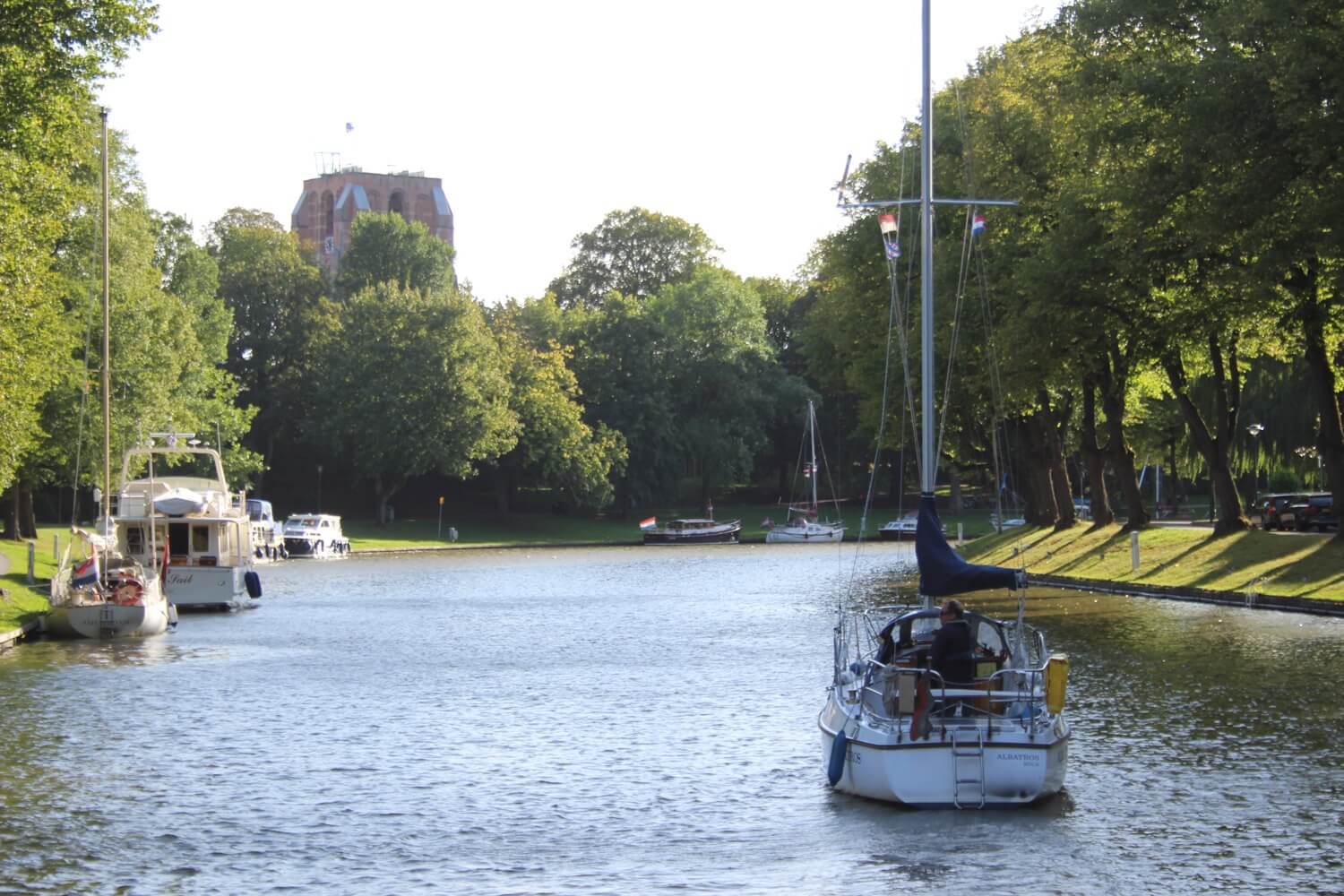
A monohull is a classical boat with a single hull. A boat with two hulls is called a catamaran, or a 'cat'. Although rare, there are also trimarans, boats with three hulls. Multihulls with four or more hulls do happen but they are an unnecessary freak of nature.
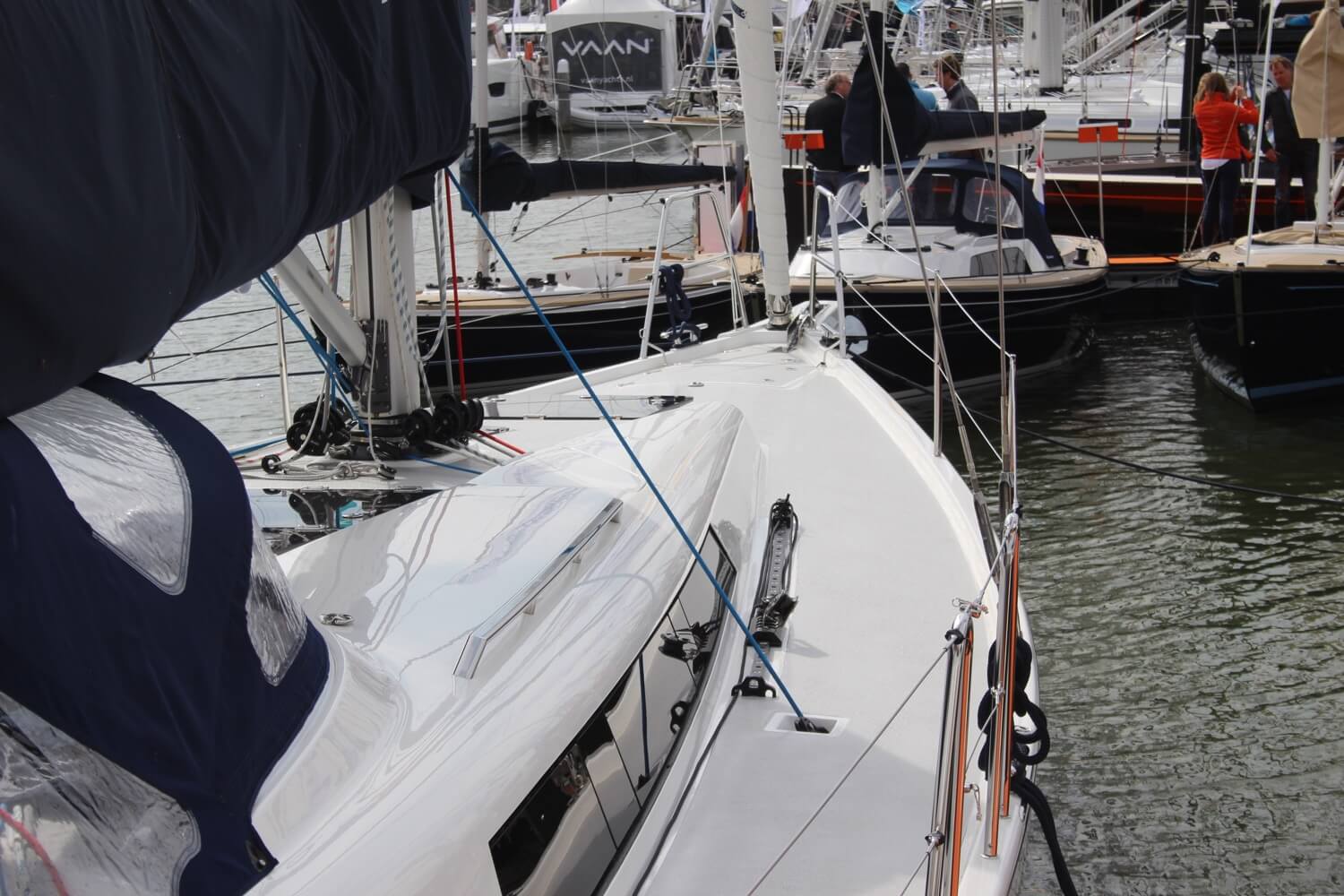
So there you have it. Fifty sailing terms you will encounter the most when traveling or learning. I know you might think some of them are a bit unnecessary since they have a perfectly fine 'real world' equivalent. I agree. But until the tradition changes, you might want to get some of these under your skin.
A boat's freeboard is the distance from the upper deck to the waterline. Classic yachts have low freeboards, so they appear to lay deeper in the water, as opposed to more modern yachts, which have a higher freeboard. It literally means 'free-board' : the amount of visible board.
The lunch hook is a light anchor setup that is used to moor small yachts temporarily. It typically uses a lightweight anchor on a short scope that takes little effort to set. The lunch hook is only used when the crew is on board and will be monitoring the anchor.
In naval architecture and ship design: “Head” = WC = Bathroom. A toilet is still a toilet. The toilet is in the head. In olden day, the toilet was a hole in the head.
Hi Rich, you’re absolutely right. I’ve corrected the error. Thanks for pointing it out.
A nautical mile is one minute of a degree, so if you travel 60 nautical miles that means you have gone 1 degree around the “globe”. (Note: arc length not actual length.) This is the original definition. As such the average was agreed upon and the lengths given a standardization. Which you mentioned.
As such 1 knot is to travel one nautical mile in an hour.
Also 1.5078. I think you made a mistake as it should be 1.1508 miles to a nautical mile.
Thanks for the information. Sorry about being a pedantic mathematics teacher.
So, where is the “nautical mile” calculated from, the equator or one of the tropic lines?
Just to clarify a nautical mile. If you draw an imaginary line from the North Pole or South Pole to the center of the Earth and draw another line from the center of the Earth to any point on the equator, it forms a right angle, which is 90 degrees. This equates to latitude. The equator is 0 degrees and the poles are 90 degrees. Your latitude is the angle that you are north or south of the equator. Each degree of latitude is divided into 60 minutes. A minute of latitude is the same distance matter where you are on Earth. It is 6,076 feet. This is the length of a nautical mile. A statute mile is 5,280 feet, so a nautical mile is 1.1508 statute miles.
Thank you very clear and well explained. Hopefully I’ll remember The Fifty
KöhnSharkösz
Really? No gunwale? No transom? Those or basic terms to the Washington State Boater Education Card required to operate watercraft here. Definitely more of a “need to know” than bimini.
Thank you, those definitions and explanations were clear, thorough, and helpful. I’m really glad I found my way (somehow) to your webpage.
Leave a comment
You may also like, 17 sailboat types explained: how to recognize them.
Ever wondered what type of sailboat you're looking at? Identifying sailboats isn't hard, you just have to know what to look for. In this article, I'll help you.

How Much Sailboats Cost On Average (380+ Prices Compared)

The Ultimate Guide to Sail Types and Rigs (with Pictures)
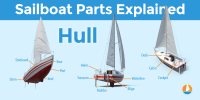
Sailboat Parts Explained: Illustrated Guide (with Diagrams)

How To Live On a Boat For Free: How I'd Do It
- Search Please fill out this field.
- Newsletters
- Water Sports
Learn the Parts of a Sailboat and How to Communicate Them
Essential Words You Need to Know
Pierre-Yves Babelon/Getty Images
The following are terms related to sailboats and their equipment , including the parts of the boat and how to communicate on one. Enjoy our list of all things nautical.
- Auxiliary - A sailboat's engine, or a sailboat with an engine
- Backstay - The cable, usually made of wire, running from the stern to the masthead that helps support the mast
- Ballast - The weight in a sailboat's keel (sometimes in a centerboard) that helps keep the boat from leaning too much
- Batten - A slat, typically made of plastic, placed in a pocket in the mainsail to help it maintain good shape
- Beam - The width of the boat at its widest point
- Bitter end - The free end of a line
- Block - A pulley-like device used on a boat, with a sheave around which a line runs
- Boom - The spar, which is usually horizontal, back from the mast to which the foot of a sail is attached
- Boom vang - A device that prevents the boom from rising and, in some types, lowering
- Bow - The front section of the boat
- Cat rig - A sailboat designed for using a mainsail only, with the mast usually located more forward than in a sloop
- Centerboard - A thin, keel-like structure that can be raised (usually rotated on a hinge up into a centerboard trunk in the hull) that's present on many sailboats without a fixed keel to prevent the boat from being blown sideways
- Chock - A type of fairlead fitting through which an anchor rode or dock line passes to reduce chafing
- Cleat - A fitting around which a line is secured
- Companionway - The entrance area and steps from the cockpit into a sailboat's cabin
- Clew - The lower rear corner of a sail
- Daggerboard - Like a centerboard, but raised and lowered vertically instead of rotating on a hinge
- Daysailer - Generally a small sailboat without a cabin large enough for comfortable overnight cruising
- Dinghy - A type of small sailboat or a small row or powered craft typically taken along when cruising in a larger sailboat
- Displacement - The weight of a boat, equal to the weight of water the boat displaces
- Dodger - A spray shield often made of foldable or removable fabric at the front of the cockpit
- Draft - The distance from a boat's waterline to the lowest part of its keel
- Fender - A bumper generally made of rubber hung alongside the boat to prevent the hull from rubbing against a dock or other structure
- Foot - The bottom edge of a sail (compare to leach and luff, below)
- Forestay - A cable usually made of wire running from the bow to the masthead that helps support the mast
- Forward - Toward the bow
- Freeboard - The height of the deck above the water (the topsides section of the hull)
- Gate - An opening in the lifelines for boarding the boat, also called gangway
- Genoa - A large jib sail (the clew extends aft of the mast)
- Gooseneck - The fitting that attaches the boom to the mast
- Ground tackle - The collective term for a boat's anchor and anchor rode
- Gunwale (sometimes gunnel) - The outer edge of the boat's deck and cockpit, also called the rail
- Halyard - Line or wire used to hoist a sail
- Hank on - To attach a jib sail to the forestay with small snap hooks called hanks
- Head - The bathroom of a boat and also the top corner of a sail
- Helm - The means by which the sailboat is steered: the tiller or wheel
- Jackline - A line, strap, or wire secured over the deck as an attachment point for the tether of a safety harness
- Jib - The triangular sail attached to the forestay
- Keel - The lower section of a sailboat's hull that's usually permanent and counteracts sideways movement and typically contains ballast
- Ketch - A type of sailboat with two masts
- Lanyard - A short cord or line, often used to secure a piece of gear (knife, whistle, etc.) that might be dropped
- Leech - The back edge of a jib or mainsail (compare to foot and luff, above and below)
- Lifeline - A line or wire (often vinyl coated) all around the boat that's held up with stanchions to prevent falling overboard
- Line - Any piece of rope used on a boat
- Luff - The leading edge of a jib or mainsail (compare to foot and leech, above)
- Mainmast - The mast, or the tallest mast of a sailboat with multiple masts
- Mainsail - The sail affixed to and behind the mainmast
- Mast - A tall vertical pole on a sailboat to support sails and rigging
- Mast step - The support structure for the bottom of the mast
- Mizzen - The smaller aft mast on a ketch or yawl; the mizzensail is affixed to and behind the mizzenmast
- Multihull - A catamaran (two hulls) or trimaran (three hulls)
- Outhaul - A fitting to adjust the tension of the foot of the mainsail on the boom
- Padeye - A fitting usually made of metal with a loop or hoop to which other gear is attached
- Pendant (sometimes pennant) - A short line attaching the bow of a boat to a mooring, or a short wire attached to a sail or halyard as an extension
- PFD - A personal flotation device such as a lifejacket or an inflatable PFD
- Port - The left side of the boat when facing forward; the opposite of starboard
- Preventer - A-Line or other device used to prevent the boom from accidentally swinging from one side to the other
- Pulpit - A rail generally made of stainless steel around the bow or stern typically at the height of the lifelines
- Rail - the outer edge of the boat's deck and cockpit; also called the gunwale
- Rig (or rigging) - The mast, boom, and associated equipment including stays, shrouds, sheets, and halyards
- Rode - The line or chain between an anchor and the boat
- Roller furler - A device by which a sail is rolled up, such as the jib rolling around a rotating forestay fitting
- Rudder - An appendage below or on the boat's stern that is rotated by moving the tiller or wheel to steer the boat
- Safety harness - Personal gear, either a separate harness or one built into a PFD, that attaches to a tether to keep the person on board
- Sail ties - Short straps or pieces of line used to tie a lowered mainsail to the boom or secure a sail on deck
- Schooner - A type of sailboat with two or more masts, the forward one being shorter than the main mast
- Seacock - A valve fitting for closing an opening through the boat's hull (drains, water pipes, etc.)
- Shackle - A fitting typically made of metal that secures two things together, such as a halyard shackle connecting to a sail
- Sheet - The line used to let out or trim in a sail; on a sloop, a mainsheet and two jib sheets
- Shroud - Wire or line stay from the deck or hull supporting the mast on each side
- Sloop - A type of sailboat with one mast and two triangular sails (main and jib)
- Sole - The floor of the cockpit or cabin
- Spinnaker - A lightweight sail used downwind, often ballooning in front of the boat
- Spreaders - Metal struts on the mast that hold the shrouds out from the mast for a better support angle
- Stanchions - Short metal poles around the boat's perimeter that support the lifelines
- Starboard - The right side of the boat (when facing forward); opposite of port
- Stay - Wire or line from the deck or hull to support the mast; stays include the forestay, backstay, and shrouds (on the sides)
- Tack - The bottom front corner of a sail
- Telltales - Pieces of yarn or ribbons on the luff of a sail to help with trimming, or fastened to shrouds to show the wind direction
- Tether - A short line or strap that runs between a safety harness and a point of attachment on the boat to prevent going overboard
- Tiller - A long handle connected to the rudder or rudder post on many sailboats for steering
- Topping lift - A wire or line from the masthead that holds up the boom when the sail is lowered
- Topsides - The area of outer hull above the waterline
- Traveler - A fitting allowing the mainsheet attachment to the boat to be adjusted side to side
- Vang - See Boom vang
- Whisker pole - A pole used to hold out the jib when sailing off the wind
- Winch - A drum-like device used to pull in lines under strain (halyards, sheets)
- Windless - A heavy winch used with the anchor rode
- Yawl - A type of sailboat with two masts, the aft one (mizzen) being behind the rudder post
Related Articles
More related articles.
The Boat Shoe Trend Has Officially Set Sail
In street style and on the spring 2025 runways, the classic shoe is getting a second life.

Boat shoes are finally getting their day in the sun. Spurred on by the resurgence of prep and Americana more broadly—think Zendaya serving tenniscore in Challengers , TikTok co-opting the old money aesthetic, and Bella Hadid 's equestrian era —the boat shoe trend revival has been percolating for a few seasons now, with early co-signs from Miu Miu and JW Anderson. But I wasn't convinced until I started seeing Sperry top-siders bounce down the spring Spring 2025 runways and worm their way into the wardrobes of fashionable women like Nordstrom associate fashion director Linda Cui Zhang , who recently took her tricked-out brown leather Sperrys to New York Fashion Week .
"I customized them with some beads from Don’t Let Disco and it makes them that much more special, and personalized," she tells me. "They offer a more relaxed look than a classic loafer."

Boat shoes at Copenhagen Fashion Week.
A post shared by Linda Cui Zhang (@lindakway) A photo posted by on
Elsewhere at New York Fashion Week (NYFW), street style muses have been pairing their boat shoes with slip skirts, baggy trousers, hot pants, and knee-socks. Collina Strada's Hillary Taymour sent mud-caked black leather Sperry boat shoes down her outdoor catwalk. Ella Emhoff was photographed wearing the same style sans mud in the front row.

The boat shoe trend got another nod at NYFW from Monse, where models hit the catwalk in slouchy black socks and three different Sperry styles: the Authentic Original Boat Shoe, the lug-soled Wells Boat Shoe, and the extra-chunky Bayside Boat Shoe. The show, which opened with a jacket Michelle Obama recently wore at the Democratic National Convention , was a landscape portrait of American sportswear influences. By pairing the boat shoe with prairie-ready dresses and city-chic blazers, designers Laura Kim and Fernando Garcia demonstrated how a shoe style meant for sea-faring can be re-contextualized for land-dwelling.

Allie Pellerano-Rendón, co-founder and CEO of the fashion consulting agency Collection Atelier , has been wearing boat shoes—from black glitter top-siders to brown ballet flat-inspired versions—all her life. She tells me she's originally from Connecticut, where boat shoes reached uniform status decades ago. "Although my closet is no longer lined with them, I do have two pairs left that I still wear," she says. "To me, the boat shoe carries the same energy as the L.L. Bean boot. It’s classic, nautical, Americana, East Coast energy."
With Fashion Month falling right between the summer Olympics and the upcoming election, it just feels right to see nostalgic American styles re-enter our collective consciousness. But there may be another reason the boat shoe is seeing such a concerted push this season, Pellerano-Rendón says.
"Collaborations are the key to cool in the fashion world right now. Since the licensing for Sperry was taken over by the Aldo group this past year, that is exactly what Sperry has been focusing on," she says, citing the brand's summer collaborations with Tod Snyder and Palmes Tennis Society. "The energy and the audience of the boat shoe is definitely shifting with these collabs."
Stay In The Know
Marie Claire email subscribers get intel on fashion and beauty trends, hot-off-the-press celebrity news, and more. Sign up here.

We've seen what can happen when designers decide to elevate an overlooked shoe. The Ugg boot comeback tour and the neverending Crocs craze offer a glimpse of just how far the humble boat shoe trend could go with a little wind in its sails. Here's hoping Sperry teams up with Dries Van Noten next. But if you're looking for a something a little freakier than a traditional boat shoe, look no further than Labucq's It Girl-ified verison, which comes outfitted with metal beads.

Hanna Lustig is a staff writer at Marie Claire , where she gets to gab every day about the topics she holds most dear: fashion, beauty, and celebrity. Hanna’s editorial journey began with formative internships at Elle and InStyle , where she was lucky enough to work for some of the smartest women in media while she was still in college. Hanna then accepted a digital culture reporting fellowship at Insider , where she helped carve out a new beat dedicated to covering influencers. Those experiences later served her well as a staff writer at Glamour , where she developed a knack for spinning quick turnaround celebrity news and trend reporting into juicy long-form feature stories.
Diane Keaton once hung up on Hanna during an interview, but thankfully that mishap did not derail what has otherwise been a deeply fulfilling career writing for and about women. She holds a Bachelor’s Degree in Media Studies from the University of Tennessee, where she was mainly taught to love and revere Dolly Parton. When she’s not at work, Hanna can likely be found listening to pop music, talking to her dog, and gossiping with her best friends. For more of Hanna’s perfect opinions on pop culture, you can follow her on Instagram and X.

The singer had some words for the eager paparazzi at the award show.
By Sadie Bell Published 11 September 24

The Midwest princess even brought a sword to complete the look.
By Hanna Lustig Published 11 September 24

The K-pop star warned us her bad girl era was fast approaching.
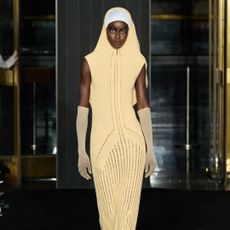
Designer Raul Lopez knows this was a show everyone will be talking about for seasons to come.
By Emma Childs Published 11 September 24

Subversive workwear designer Jane Wade has an idea.

The runways have spoken. This is the latest, barely-there trend for everyone.
By Sara Holzman Published 9 September 24

The Olympics ended last month, but NYFW is keeping sports stars busy.
By Julia Gray Last updated 10 September 24

Susan Alexandra and Rachel Antonoff put Westminster to shame.
By Halie LeSavage Last updated 7 September 24

This is a nepo baby moment I can get behind.
By Kelsey Stiegman Published 6 September 24

Expect to see the twin still wearing her $900 sandals come October.
By Julia Gray Published 22 August 24

If there's one thing Katie loves, it's an easy shoe.
By India Roby Published 20 August 24
- Contact Future's experts
- Advertise Online
- Terms and conditions
- Privacy policy
- Cookies policy
Marie Claire is part of Future plc, an international media group and leading digital publisher. Visit our corporate site . © Future US, Inc. Full 7th Floor, 130 West 42nd Street, New York, NY 10036.

IMAGES
VIDEO
COMMENTS
Luff: The forward edge of the sail. Leech: Back edge of the sail. Tack: The lower front corner of the sail. Clew: The bottom back corner of the sail. Foot: Bottom of the sail. There are two sail shapes, the fore-and-aft rigged sails, and square-rigged sails.
A sail, which is a large piece of fabric that is attached to a long pole called the mast, uses the wind to pull a sailboat across the water. It has various parts, such as the head, tack, clew, luff, leech, foot, mainsail, jib, and batten. These components determine the shape and efficiency of the sail.
The mast is the long, standing pole holding the sails. It is typically placed just off-center of a sailboat (a little bit to the front) and gives the sailboat its characteristic shape. The mast is crucial for any sailboat: without a mast, any sailboat would become just a regular boat. The Sails. I think this segment speaks mostly for itself.
The luff of a sail is the front part of the sail between the tack and head. On a mainsail, the luff runs vertically along the mast and along or close to the forestay on a headsail. ... These sails are efficient for downwind sailing and are hung from horizontal spars called yards. Though not as agile as modern fore-and-aft sails when sailing ...
In front of the main mast is called a foremast. The 5 most common two-masted rigs are: Lugger - two masts (mizzen), with lugsail (cross between gaff rig and lateen rig) on both masts. Yawl - two masts (mizzen), fore-and-aft rigged on both masts. Main mast much taller than mizzen. Mizzen without mainsail.
The peak is the very top of the sail.; The throat is the top front corner of the sail.; The tack (noun) is the name for the lower corner of the sail closest to the mast. [1] Not to be confused with a tack which describes which side of a sailboat the wind is coming from while under way—port or starboard. [2]The foot is the bottom edge of the sail from the tack to the clew.
The triangular forward (front) sail is called the jib, and it's generally smaller than the mainsail. Other sails include the spinnaker, which is like a loosely-mounted parachute that flies in front of the boat during conditions of low wind. Boom. The boom is a hinged rod that extends perpendicular to the mast. It's mounted on the lower part ...
3. Genoa. The genoa is a large sail that attaches to the front of the forestay. (In this instance, it's similar to a headsail.) However, the genoa is larger than the headsail and overlaps the mainsail partially or completely to help the boat go faster. Genoa sails are useful when sailing through light or medium wind.
Hull - The main structure. Keel - The fin under the boat. Rudder - To steer the boat. Mast and Rigging - Supporting the sails. Boom - Supporting the mainsail. Sails - The canvas used to harness the energy of the wind. The starboard and port side of the boat. Windward and Leeward. Basic parts of a sailboat.
A basic sailboat is composed of at least 12 parts: the hull, the keel, the rudder, the mast, the mainsail, the boom, the kicking strap (boom vang), the topping lift, the jib, the spinnaker, the genoa, the backstay, and the forestay. Read all the way through for the definition of each sailboat part and to know how they work.
Mainsail: It's all in the name; this is the boat's mainsail. It is the sail attached to the back of the mast. Mast: The mast is a large, vertical pole that holds the sails up. Some boats have more than one mast. Painter: This is a line positioned at the front of small boats. It is used to tie the boat to a dock or another boat.
Close-Hauled. Sailing as close to the wind as possible, with the sail set at a sharp angle to the boat. Beam Reach. Sailing perpendicular to the wind, with the sail set at a right angle to the boat. Broad Reach. Sailing with the wind at a diagonal angle behind the boat, with the sail angled away from the boat. Running.
Leech - The sail's back edge. Foot - The bottom edge of the sail. Tack - Between the luff and the foot is the tack. The tack is attached to the boat or a spar. Head - The corner at the top of the sail between the luff and the leech. Clew - The third triangle of a sail between the leech and the foot. Batten - Solid slats or rods to ...
Bow: This is what the front of the boat is called. Centerboard: This is a (usually fibreglass) plate that pivots from the bottom of the keel in some boats and is used to balance the boat when under sail. Cleat: Cleats are what lines (or ropes) get fastened to when they need to be kept tight. Halyard: Lines that raise or lower the sails.
On the most common sailboats, the term foresail refers to the front sail, which is attached to the boat's bow and mast. It is usually rolled in the roller furling or attached to the forestay via little snaps called 'hank-ons.' If you stumble upon the term 'headsail' or simply 'front sail,' know it is just a different name for the same thing.
Fore-stay: Wire or line connecting the mast to the bow. Halyard (Jib): Line used to raise and lower a sail.(Ropes on a sailboat are called "lines" or "sheets") Head (Jib): Top corner of the sail that connects to the halyard which raises the sail. Leech (Jib): The edge of the sail between the head and clew also known as the trailing edge. Luff (Jib): The front edge of the sail between ...
The front part of a boat is called the bow, while the rear part is called the stern. A cockpit is a working area, towards the stern of a boat, from which the boat is steered and controlled. A boat is steered by turning the tiller which results in turning the rudder, since these two are connected with a shaft.
Hull - The watertight structural shell of a boat. Bow - The forward part of a boat. Stern - The aft part of the boat. Transom - The more or less flat surface that closes the hull at the stern. Rudder - The sailboat is steered by a fin-shaped appendage attached beneath the boat toward the stern which can be rotated to change the angle ...
The exterior and the cockpit. The external area is divided into three or four parts: Starting from the stern (we generally enter the boat from the rear, so this is in a sense our front door), we have the cockpit, which is the heart of the boat, this is where we will live most of our day, especially in summer. Bounded at the stern by the little ...
Read Next: Beginner Sailing Tips. 4. Starboard. Starboard is always the right-hand side of the boat when you are facing the bow. Because "right" and "left" can become confusing sailing terms when used out in the open waters, starboard defines the right-hand side of the boat as it relates to the bow or front. 5. Leeward.
2. Bow and Stern. The bow refers to the front of the boat, while the stern refers to the back. This is another critical term to understand, especially when docking or communicating with crew members. Price & Specs. Entry-level sailboats like the Beneteau First 14 have well-defined bow and stern areas, with sleek designs aimed at enhancing speed and maneuverability.
The mainsail is the main, largest sail of the boat, attached to the mast on the side and the boom at the bottom. It has a triangular shape and serves as the most important sail, the first one you should get acquainted with if you are just starting out. Jib. The jib is the front sail of your boat, sometimes also called the genoa.
June 17, 2024. Sailboats are powered by sails using the force of the wind. They are also referred to as sailing dinghies, boats, and yachts, depending on their size. Sailboats range in size, from lightweight dinghies like the Optimist dinghy (7'9") all the way up to mega yachts over 200 feet long. The length is often abbreviated as LOA (length ...
Gunwale (sometimes gunnel) - The outer edge of the boat's deck and cockpit, also called the rail; Halyard - Line or wire used to hoist a sail; Hank on - To attach a jib sail to the forestay with small snap hooks called hanks; Head - The bathroom of a boat and also the top corner of a sail; Helm - The means by which the sailboat is steered: the ...
A boat shoe trend is gaining steam, from the Collina Strada and Monse runways to street style in the front row. See and shop the boat shoe trend here. ... The Boat Shoe Trend Has Officially Set Sail .